

ALL AT TEA!
Dinner services owned by naval hero Horatio Nelson go under the hammer

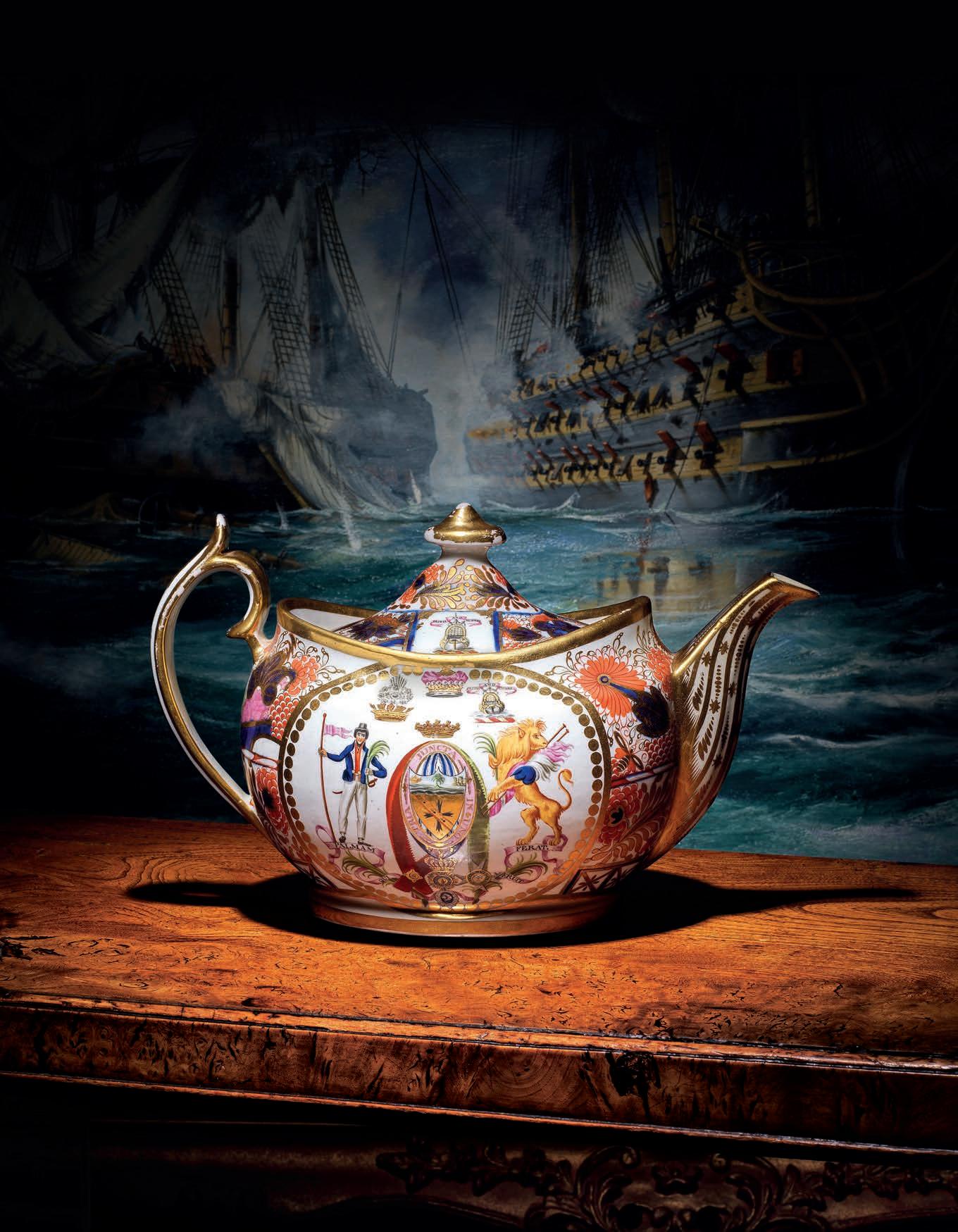
Royal Flush
Starting a collection of Maundy money
APRIL


On the Monet
Pick up paintings by the Impressionist’s family for less than £4,000

Inside: CATHERINE SOUTHON JOINS THE TEAM CHIME AFTER CHIME CHINESE ‘SINGING’ CLOCKS IN THE SPOTLIGHT
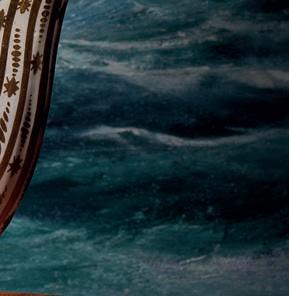

FABULOUS CREATURES
Decoding the eccentric designs of Victorian ceramicist and polymath William De Morgan

THE PETER BARKWORTH COLLECTION EARLY OAK ON SALE ERIC KNOWLES ALSO INSIDE Focus on Armenian rugs • Antiques puzzles • Auction listings ANTIQUE COLLECTING VOL 58 N0.10 APRIL 2024
2024
TheKeithHockinCollection
Thursday11April2024atourStowmarketsaleroom
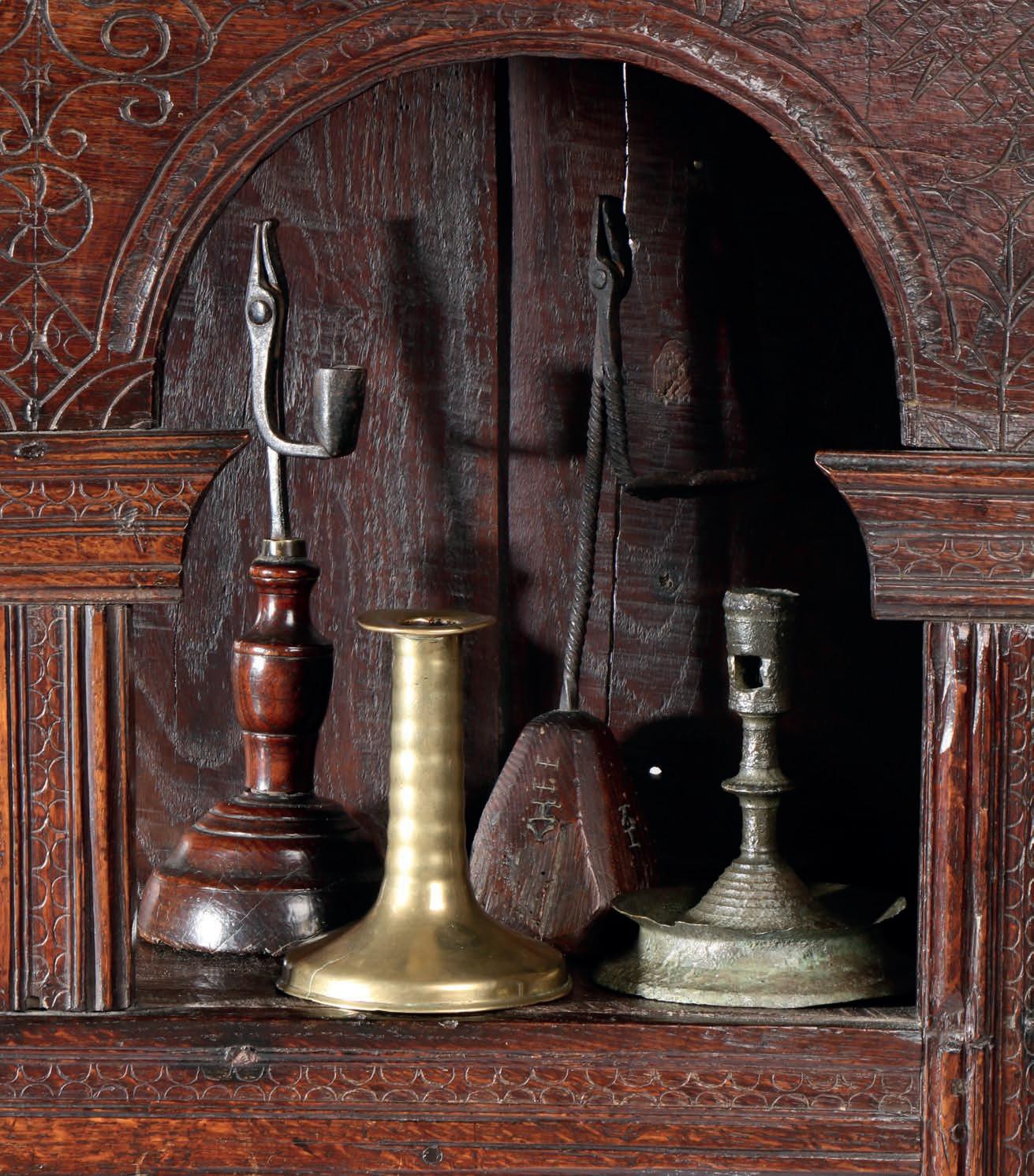
viewing: Saturday6April9am-1pm,Sunday7April9am-12noon,Monday8Aprilthroughto Wednesday10April9am-4pmandonthedayoftheauctionfrom9am.
www.bishopandmillerauctions.co.uk
GlandfordAuctionGallery:12ManorFarm,Glandford,nrHolt,Norfolk,NR257JP norfolk.enquiries@bm-auctions.co.uk01263687342
Stowmarketsaleroom:19CharlesIndustrialEstate,Stowmarket,Suffolk,IP145AH enquiries@bm-auctions.co.uk01449673088




ere’s nothing that enchants me more than a Victorian polymath. ose full-bearded, bespectacled men closeted in their studies or sheds determined to push the boundaries of knowledge, regardless of the consequences. One such, as we discover in this month’s magazine, was the artist-potter William De Morgan.
When he wasn’t blowing the roof o his lodgings trying to discover the secrets of 16th-century Middle Eastern glazes, he was penning a number of best-selling novels. Even his spare time was taken up designing a new duplex bicycle gear. Aside from De Morgan’s indusry, he also had a great talent for one-liners. When one of his workers complained their designs were being unfairly copied, apparently unconcerned, he replied: “Imitation is the sincerest form of pottery.” Have a look at the article on page 26 and discover how his work, especially his tiles, continues to delight collectors around the world.
Almost as high in my a ections as a Victorian polymath, is a blu military tactician with a love of bling porcelain. Who knew that Admiral Lord Nelson, one of Britain’s greatest naval heroes, loved nothing more than a fancy teacup? is month, on St George’s Day, of course, ceramics that were either owned or ordered by him go under the hammer at Bonhams, in what has been described as the biggest-ever auction of its type.
Among the lots are a teapot and butter dish from the renowned (and very fancy) Horatia service, as well as a teapot from the highly-collectable Baltic set. Have a look at the feature on page 18.
Elsewhere in the magazine we are joined by new columnist and TV favourite Catherine Southon, who on page 24 reveals her love of the portrait silhouette, while on page 32 regular columnist Iritia Marriott considers the ceremony of Maundy money and why those very special coins are so highly sought after by collectors.
On page 48 we go behind the scenes at an exhibition of musical Chinese clocks at the Science Museum and, on page 34, the art of Claude Monet’s great grandson (by marriage) Jean-Marie Toulgouat is put in focus. e good news for collectors is Toulgouat’s paintings of the family home of Giverny can be bought for thousands – rather than the millions required to buy the artwork of his famous forebear. Enjoy the issue.

CATHERINE SOUTHON
The TV favourite joins the team with a new column, page 24

LOUISE BROADHURST
The carpets expert previews an auction of Oriental rugs in London this month, page 42

OLIVER MILLER
Goes behind the scenes of an important sale of early oak, page 46
Georgina Wroe, Editor
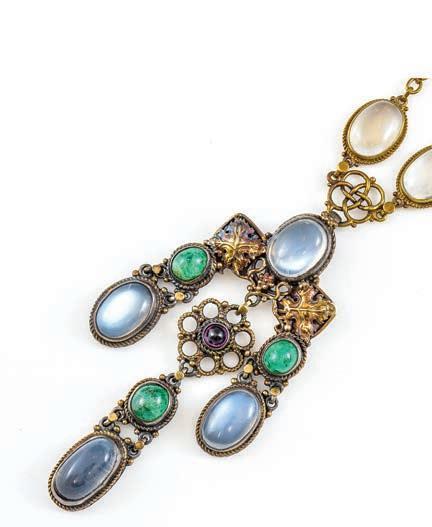

Our Antiques Roadshow expert experiences an unforgettable buzz in a UK saleroom, page 66
Editor: Georgina Wroe, georgina. wroe@accartbooks.com
Online Editor: Richard Ginger, richard.ginger@accartbooks.com
Philp Design, philpdesign.co.uk
Advertising and subscriptions: Charlotte Kettell
389969, charlotte.kettell @accartbooks.com
ANTIQUE COLLECTING 3 IN THIS ISSUE
KEEP IN TOUCH Write to us at Antique Collecting, Riverside House, Dock Lane, Woodbridge, Suffolk, IP12
or email magazine@accartbooks.com. Visit the website at www.antique-collecting. co.uk and follow us
Instagram
SUBSCRIBE TODAY TO ANTIQUE COLLECTING Call 01394 389969 or email charlotte.kettell@accartbooks.com FIRST WORD ONLY £38 for 10 issues
Welcome
1PE,
on X and
@AntiqueMag
THE TEAM
Design:
01394
MARC ALLUM
this arts and crafts pendant with moonstones, emeralds and a garnet, that has an estimate of £600-£800 at the West Sussex auctioneer Bellmans’ sale on April 16 We love!
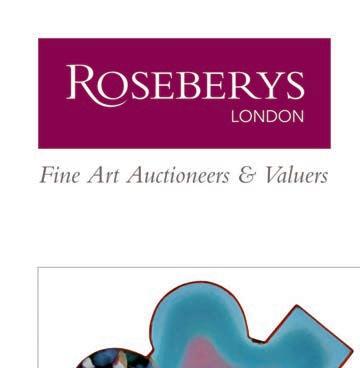
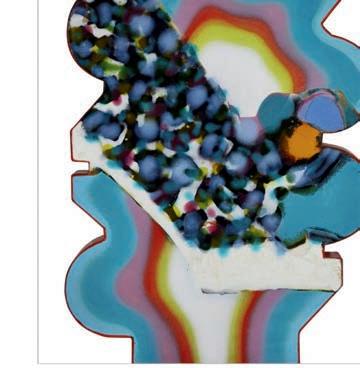


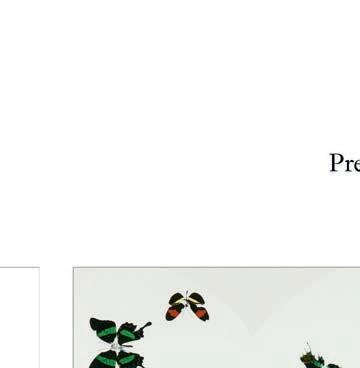

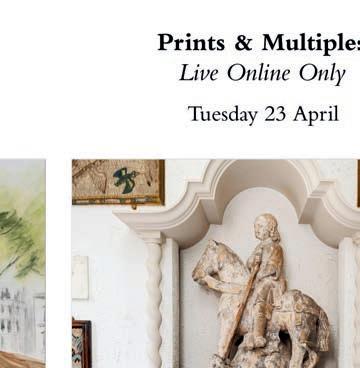
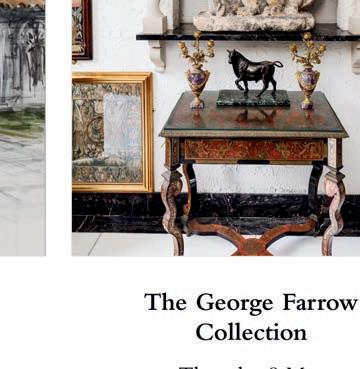
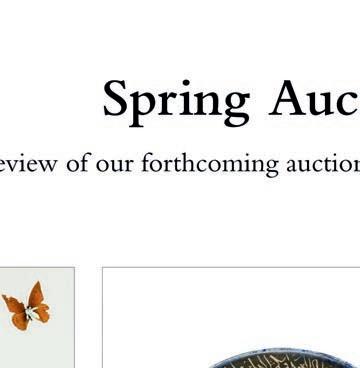

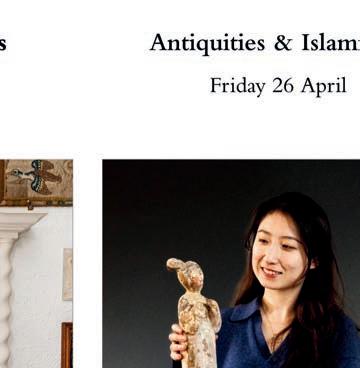
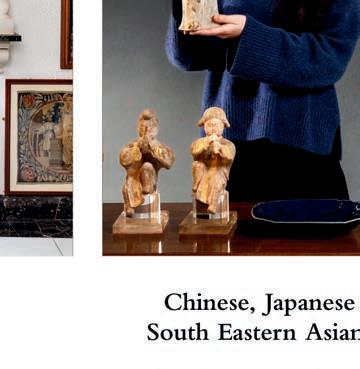




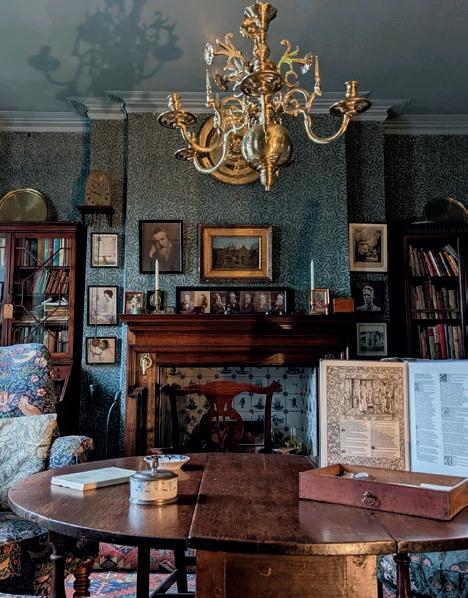
REGULARS
3 Editor’s Welcome: Georgina Wroe introduces the April issue with its focus on a the ceramicist William De Morgan and a special sale of Nelson ceramics

6 Antiques News: All the latest from the world of ne art and antiques, including details of three must-see exhibitions in London, Devon and Buckinghamshire
10 Your Letters: is month’s postbag has correspondence praising two TV stalwarts and there is news of a grey squirrel infestation
12 Around the Houses: Lifelike Russian gures from the Imperial Porcelain Factory y past their estimate in Wiltshire and a rare Dr Who annual beats its guide price in Kent






Subscription O er: Save more than a third on the annual RRP and you, or a friend receives a free gift
Waxing Lyrical: Behind the scenes with English antiques expert David Harvey as he reminisces on almost half a century of selling exhibitions
56 Book O ers: Explore the world without leaving your armchair with this month’s selection of globetrotting titles from our sister publisher ACC Art Books
58 Fairs News: A popular fair returns to a disused East Anglian air eld, while textiles from around the world are on o er in Manchester
59 Fairs Calendar: Make sure you never miss another event with our UK-wide and up-to-date listings
60 Auctions Calendar: Check out every upcoming sale from the country’s leading salerooms
66 Marc My Words: e Antiques Roadshow expert discovers auction salerooms are still alive and kicking when one very special collection goes under the hammer


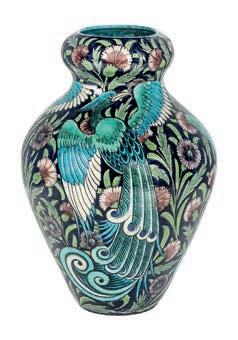
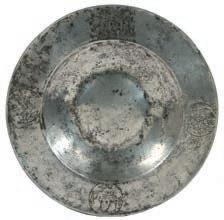

Lots to Talk About: New columnist Catherine Southon reveals her love of silhouette portraits ahead of an upcoming sale of minature marvels next month in Surrey
32 Lots of Love: Irita Marriott is impressed by the longheld royal tradition of handing out Maundy money and why the coins are enticing to collectors
39 In the Knowles: Decorative arts specialist Eric Knowles praises the masterful glass creations of the French designer Émile Gallé
40 Puzzle Pages: Keep your antiques brain active with a two pages of quizzes including a head-scratching crossword set to perplex
46 Saleroom Spotlight: Early oak, ironwork and pewter from the collection of the legendary Cotswolds dealer Keith Hockin go under the hammer in Su olk
54 Top of the Lots: e extraordinary art collection of a Bafta-winning actor is up for sale, as well as a tiny bugle used by early cycling teams
FEATURES
18 Naval Gazing: Ceramics owned by the British naval hero Admiral Lord Nelson and other high-end commemorative ware go under the hammer in London this month
26 Renaissance Man: e life and career of the celebrated Victorian artist potter William De Morgan is under the spotlight in wake of a new exhibition
34 Making an Impression: Paintings by Claude Monet’s great grandson (by marriage) appear in two exhibitions this month. Antique Collecting looks at his portrayals of Giverny
42 Magic Carpets: Rugs specialist Louise Broadhurst goes undercover at the sale of a collection of carpets this month, including examples by two important Armenian makers
48 Clock is: Chinese singing clocks were beloved by the country’s emperors. But beneath the cranes and lotus-leaf decoration they had some very British makers at their hearts. Antique Collecting reports
ANTIQUE COLLECTING 5 COVER A Chamberlain teapot cover and lid from the Horatia service, c. 18021804. It has an estimate of £25,000-£35,000 in the sale Nelson Forever! on April 23. Photo credit Bonhams Contents VOL 58 NO 10 ALSO INSIDE Focus on Armenian rugs Royal Flush Starting collectionMaundy money ALL AT TEA! Dinner services owned by naval hero Horatio Nelson go under the hammer FABULOUS CREATURES Decoding the eccentric designs of Victorian ceramicist and polymath William De Morgan FOLLOW US @AntiqueMag
TO SUBSCRIBE TODAY VISIT WWW.ANTIQUE-COLLECTING.CO.UK/SUBSCRIBE WEEKDAYS FROM 9.30AM TO 1PM,
6 46 12 18 34
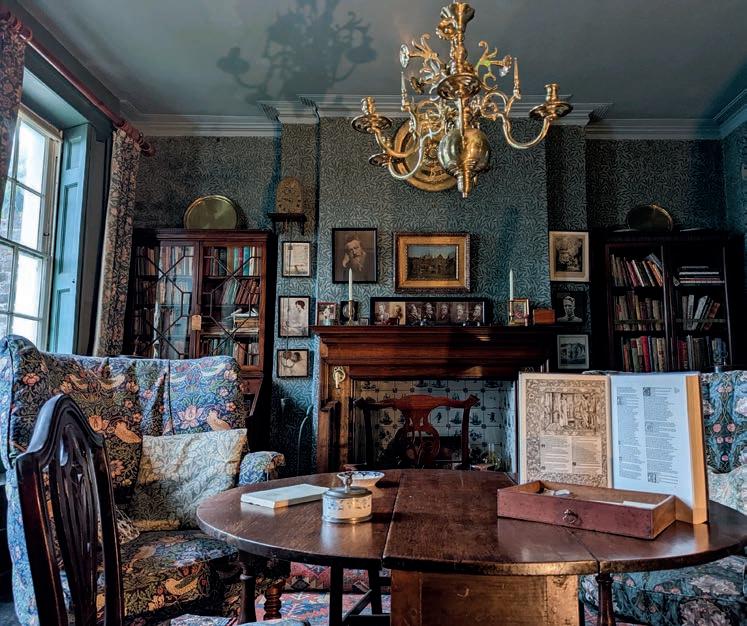
WHAT’S ON IN APRIL
A NTIQUE news
Discover life in everyday Tudor times and how important odour was to Pre-Raphaelite artists

Court short
Southwark Cathedral in London this month hosts a day-long exploration of the Tudor era beyond the royal court. Aside from royalty, the age was packed with musicians, mathematicians, poets, painters, saints and scientists. Their lives are explored on April 6 with a series of talks, one by the art historian Franny Moyle on Hans Holbein the Younger, while Dr Chris Laoutaris will unravel the intertwined lives behind Shakespeare’s First Folio. Tickets cost £23 with events taking place in the cathedral library.
Just your type
A full set of Doves type, created by Emery Walker and T.J. Cobden-Sanderson, has gone on show at Emery Walker’s House in Hammersmith. It is the rst time the full alphabet has been displayed since the pieces were retrieved from the mud by Hammersmith Bridge. Walker and Cobden-Sanderson, who started the Doves Press at the turn of the 20th century, came up with the landmark typeface which was used in many iconic books from the arts and craft movement. But a bitter feud between the duo resulted in the entire press being dumped in the River ames when neither could agree on its ownership.
e exhibition, which also includes other mudlarked nds such as prehistoric int tools, Roman coins and and Medieval pilgrim badges continues until April 27.
Above e dining room at Emery Walker’s House with the typeface on the table @ Emery Walker’s House. Credit Lucinda MacPherson
Right Doves type recovered from the ames, credit Matthew Williams Ellis
Below left George Vertue (1684–1756)
Procession portrait of Elizabeth I of England c. 1601
Below right A repoussé gold ornament, with three bands of decoration, Asante, Ghana, 19th century © V&A

GOLD COAST
The UK is sending some of Ghana’s “crown jewels” back home, 150 years after looting them from the court of the Asante king.
The V&A is lending 17 pieces to an exhibition in the West African country, while the British Museum is sending 15 treasures.
Both museums are banned by law from permanently returning contested items in their collections, so loan deals are seen as a way to allow objects to return to their countries of origin.
Most of the returning items were grabbed during 19th-century wars between the British and the Asante.
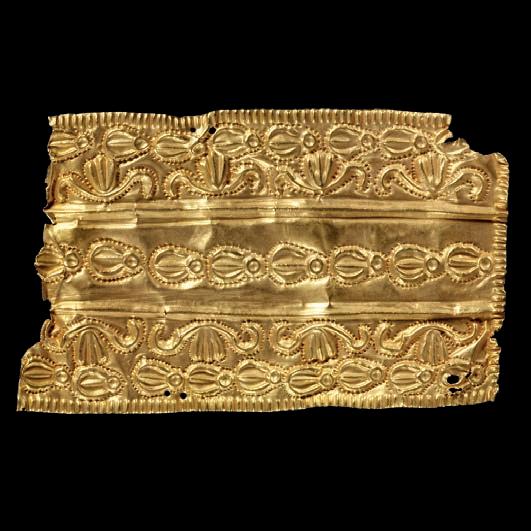
NEWS All the latest
6 ANTIQUE COLLECTING
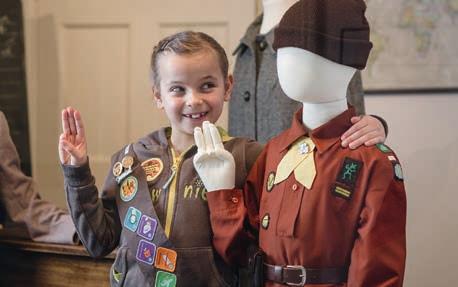
1Youngfashion
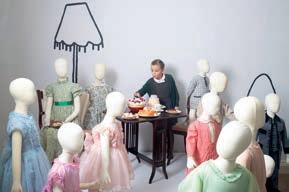
Killerton in Devon – home of the National Trust’s largest fashion collection – is staging a new exhibition exploring developmentsin children's clothing over the last 200 years. Among other things, Playing by the Rules, Childhood, Dress and Imagination, on until November 3, will reveal how both Victorian boys and girls were dressed alike in petticoats until the age of five. Visitors are encouraged to share their childhood fashion memories by posting images on Killerton’s social media channels (@ntkillerton).
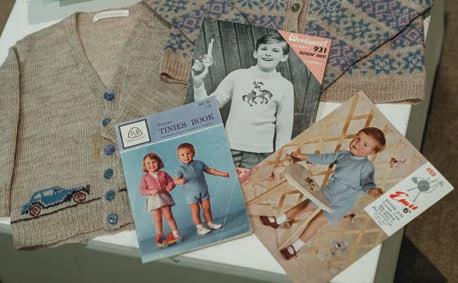
3 Singh up
is month, the Wallace Collection in London shines a light on the remarkable life and legacy of Maharaja Ranjit Singh (1780-1839), the founder of the Sikh Empire (1799-1849).
Living in a period riven with anarchy following decades of Afghan invasions, Ranjit Singh emerged as the Punjab region’s undisputed Maharaja by the turn of the 19th century.
e exhibition will feature historic objects from Ranjit Singh’s court, courtiers and his family members and display objects intimately connected with his son, Maharaja Duleep Singh – the deposed boy-king who was a favourite of Queen Victoria and the father of the prominent su ragette, Princess Sophia Duleep Singh.
Ranjit Singh: Sikh, Warrior, King runs from April 10 to October 20.
Left An old and new Brownie uniform on show at Killerton, National Trust Images © Steve Haywood
Right Guercino (15911666) King David, 1651, Waddesdon Image Library
Below left e fashion exhibition at Killerton in Devon, National Trust Images © Steve Haywood
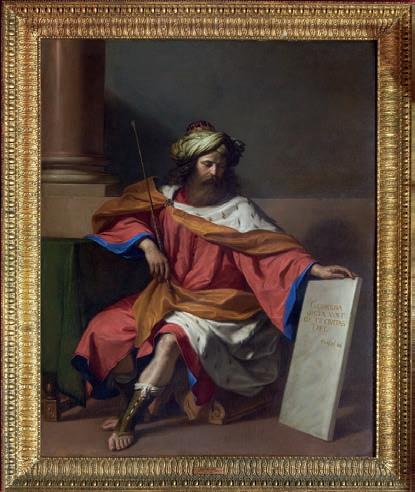
2 Four sight
to see in April 3
Left Knitting patterns on show this month, National Trust Images © Steve Haywood
Far right Guercino (1591-1666) e Libyan Sibyl, 1651 © Royal Collection Trust/ His Majesty King Charles III 2022
Right Guercino (15911666) e Samian Sibyl with a Putto, 1651 © e National Gallery
Below right Ha z Muhammad of Multan, the golden throne of Maharaja Ranjit Singh, c. 1818 © V&A
Far right Suit of armour, Lahore, Punjab, c. 18301840 © Royal Armouries
Below Emerald girdle belonging to Maharaja Sher Singh, Indian, c. 1840 © Royal Collection Trust

A new exhibition in Buckinghamshire for the rst time brings together four paintings by the great Italian artist Giovanni Francesco Barbieri (1591-1666), known as Guercino. e quartet, on display at Waddesdon, teams King David, from Waddesdon’s own collection with three sibyls (female prophets from classical antiquity) from the National Gallery and the Royal Collection.
Visitors will be invited to consider the relationship between David, the Jewish patriarch, psalmist and prophet, whom Christians believed pre gured Christ, and the four turbaned, pagan seers, who supposedly foretold Christ’s birth.
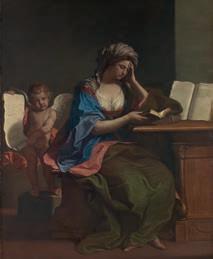










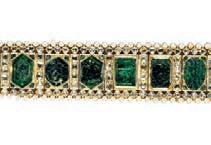


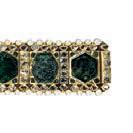

ANTIQUE COLLECTING 7



Herring zone



Fashion buffs have until April 14 to see one of the most iconic ties in sartorial history.
Designed by the leading menswear designer Michael Fish, the classic ‘70s design was bought for 99p in a charity shop in Southampton with the owner unaware she had a museum piece on her hands. With its exaggerated wide shape, the tie became known as a ‘kipper tie’a pun on the designer’s aquatic surname. Fish’s designs were worn by notable celebrities including Mick Jagger and Muhammad Ali. The tie is the latest exhibit at Fashion City: How Jewish Londoners shaped global style at the Museum of London.
Pottery showdown
e Leach Pottery in St Ives, founded by the ‘father of British studio pottery’ Bernard Leach in 1920, has launched its rst selling exhibition of 2024.
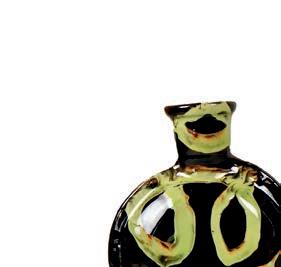

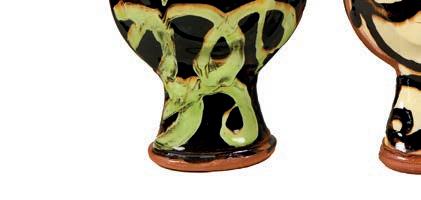
Colour & Movement celebrates contemporary and emerging potters, including Oxfordshire-based Dylan Bowen whose work has its roots in traditional slipware.
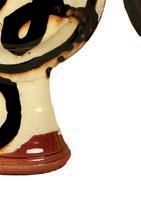


e work of the London-based ceramicist Heather Gibson, which includes hand-built ceramic stoneware, large chargers, carved vessels and tableware will also be on sale. e selling exhibition runs until May 19 with an online sale from June 10-17. e Leach Pottery was restored and reopened in 2008 as a museum to celebrate the life and legacy of Bernard Leach (1887-1979).
Above Dylan Bowen, thrown and assembled bottles, on o er this month in St Ives
FLAMING HOT
Sir Frederic Leighton’s iconic painting Flaming June, 1895, is back at the Royal Academy, on loan from the Museo de Arte de Ponce, Puerto Rico.
It was rst exhibited at the RA almost 128 years ago – at the height of Leighton’s popularity – but shortly after it was created, it disappeared for decades, until it was by chance rediscovered in the 1960s, found boxed in over a chimney in a home in Battersea.
By then, Victorian art had fallen out of fashion and it went on to be bought by Museo de Arte de Ponce.
But as tastes changed Flaming June regained its status as one of the best-loved works of this period in British art.
30 seconds with...
We asked TV celebrity, auctioneer and new columnist Catherine Southon to give us an insight into her career
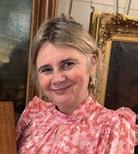
How did you start in the business?
I left university in the mid ‘90s and went straight into working at Sotheby’s Bond Street where I was a departmental assistant working in a different department every day, from carpets to ceramics. I went on to spend 10 years cataloguing scientific instruments, including the twice-yearly marine sale.
How did your TV career start?
After apply ng for an advert in the Antiques Trade Gazette for experts on
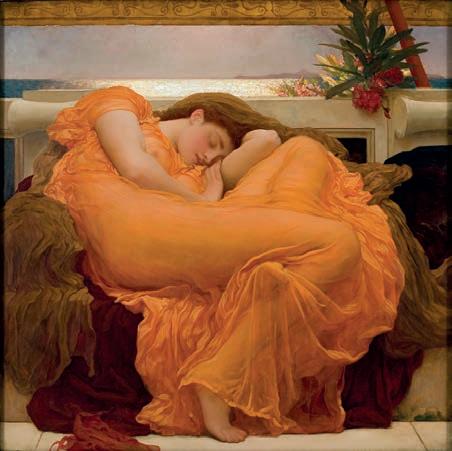
a TV programme called Flog it! in 2002, I was called up for a screen test and started filming on the same day. I was completely thrown in the deep end. I then worked on Bargain Hunt and now Antiques Road Trip, with a few others in between.
The TV work can include long days but anyone who works on the shows will tell you that we are all good friends and have incredible crews who keep us well fuelled with coffee and chocolate. On top of that, I set up my own auction house, Catherine Southon Auctioneers & Valuers, in 2012.
What has been your most exciting find to date?
At one of my valuation days in Oxted six years ago I was handed a Tesco bag, as I pulled an item out of it I noticed a box made of pear wood, a rather expensive timber, and, at that moment, a shiver went down my spine. I opened the box and read on
the silk-lined interior lid the word Fabergé. Inside was a beautiful jewelled nephrite photo frame by the Fabergé craftsman Mikhail Perkhin which sold for £22,750. Delivering the news to the vendor, who almost fell off her chair, was a moment I will never forget.
How is combining TV and your day job?
I juggle both – as well as being the mum of two teenagers – by having two diaries. I am also assisted by a wonderful team who work with me at the auction house and a very understanding husband.
Do you collect? If so, what?
Like all auctioneers I have a collection of gavels which I have picked up over the years. I don’t really collect anything in particular, I just buy what I like.
Read Catherine’s new column on page 24.
8 ANTIQUE COLLECTING
Above Kipper tie designed by Mr Fish © Museum of London
NEWS All the latest
Right Frederic Leighton, Flaming June, c. 1895. Oil on canvas, 119.1cm x 119.1cm. Museo de Arte de Ponce. Luis A. Ferré Foundation
Scent up
e Victorian vogue for synaesthesia (evoking one sense through another), in this case smell, is the subject of a new exhibition in the Midlands this autumn.
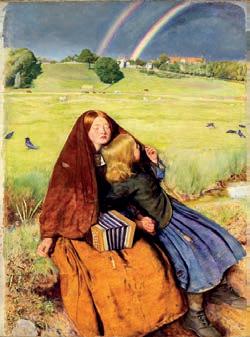
Scent and the Art of the PreRaphaelites will go on show at the Barber Institute of Fine Arts, the art gallery of the University of Birmingham on October 11.
Scent was a key motif in paintings by Pre-Raphaelite artists who depicted it in daydreaming gures smelling owers or burning incense. It was also thought to excite hedonism by evoking strong moods and emotions. e exhibition is curated by Dr Christina Bradstreet, author of Scented Visions: Smell in Art, 1850-1914.
GOOD MOODY
Plans have been unveiled for the rst major exhibition of the work of the sculptor Ronald Moody (1900-1984) later this year.
Using more than 50 sculptures and paintings, Sculpting Life, which opens at the Hepworth Wake eld on June 22, will also include never-before-seen archival material and works by Moody’s peers including Jacob Epstein, Elizabeth Frink, Barbara Hepworth and Henry Moore. Moody was born in Jamaica, and moved to London in 1923 to study dentistry. He was inspired by visits to the British Museum to leave teeth and become a sculptor, teaching himself to model and then carve, primarily in wood.

Dr Show


High-tech gadgets ranging from wristwatch dart guns to submarine sports cars have gone on show in Chicago at the rst ever exhibition devoted to James Bond 007. Fans of the secret agent and his movie franchise will have until October 27 to get to Science: Inventing the World of James Bond city’s Museum of Science and Industry.

Produced in partnership with Eon Productions, the creators of the James Bond lms, the show features 13 vehicles and over 90 artefacts to delve into the real science that went into developing the spy’s gadgets and stunts.
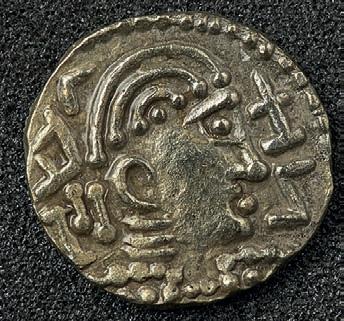
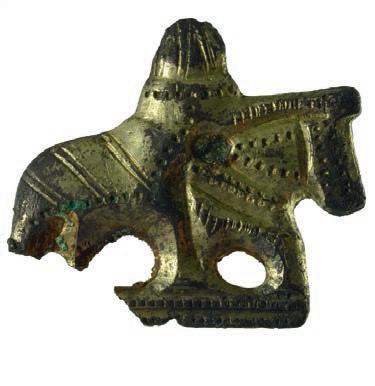



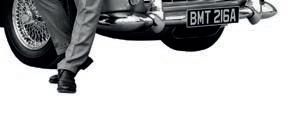

EASTERNMAGIC
The Anglo Saxon kingdom of East Anglia is put in focus at a new exhibition in Suffolk this month. Visitors have until July 23 to get along to Rendlesham Revealed: The Heart of a Kingdom AD 400-800 at the Anglo-Saxon Village and Museum in West Stow.
As well as home to the famous burial at Sutton Hoo, the Deben valley is the site of a royal settlement at Rendlesham – a power centre at the heart of a vast trading network.
One of the objects on display is a silver brooch in the form of a horse-and-rider, similar to examples found in modern-day France and the Netherlands in the later 5th century. For more details go to www.heritage.suffolk.gov.uk/rendlesham
Above left Early English gold shilling. Rendlesham played a crucial role in encouraging trade
Left A silver brooch in the form of a horse-and-rider, similar to examples found in modern-day France and the Netherlands in the later 5th century
Willem de Kooning, one of the most revolutionary and in uential artists of the 20th century, will be the subject of a major exhibition at the Gallerie dell’Accademia to coincide with this month’s Venice Biennale. e exhibition will be the rst to explore de Kooning’s time in Italy in 1959 and 1969 and the profound impact it had on his work. With works ranging from the 1950s to the 1980s, it will also will bring together around 75 works, making it the largest presentation of the artist’s work ever seen in Italy. e 60th Venice Biennale takes place from April 20 to November 24.
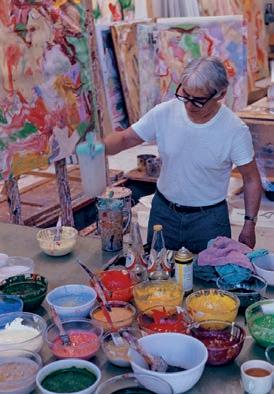
ANTIQUE COLLECTING 9
Above right Daniel Craig as James Bond, posing with the spy’s silver Aston Martin DB5 for Skyfall. Photo Eon Productions
Right A surveillance kit, used by the CIA on loan from the International Spy Museum. Photo Museum of Science and Industry
Above John Everett Millais, e Blind Girl (18291896), 1856. Image Birmingham Museums Trust, licensed under CC0
007
Right Willem de Kooning in his East Hampton Studio, New York, 1971. Photograph by Dan Budnik © 2024 e Estate of Dan Budnik. All Rights Reserved
on view at the
Below Ronald Moody working on Johanaan, 1963 © Val Wilmer. Photo Val Wilmer
Your Let ters
is month’s mailbox contains praise for two television stalwarts from the world of antiques and memories of a squirrel ‘invasion’

Our star letter receives a copy of British Designer Silver by John Andrew and Derek Styles worth £75. Write to us at Antique Collecting magazine, Riverside House, Dock Lane, Melton, Woodbridge, Suffolk, IP12 1PE or email magazine@ accartbooks.com
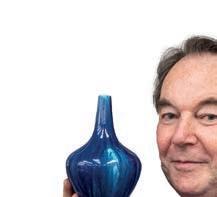








ank you for the article on the sale of the Drew Pritchard collection (Room with a Drew, March issue). I know he is not everyone’s cup of tea (personally, I think a lot of people are put o by his bluntness and jealous of his success) but Salvage Hunters got me and my elderly mum through lockdown.
Not only that, when we emerged from the
Not only that, when we emerged from the pandemic I felt duty bound to make the pilgrimage to Conwy to see his shop (now closed). We were lucky enough to meet Drew and he was charm itself. I found an anglepoise lamp and he posed for a sel e. My mum was over the moon. Happy times.
Je Alcott, by email
I was amused to read Marc Allum’s (Marc My Words, March issue) tales of his encounters with dead and dying rodents. Many years ago I was director of a mediumsized local museum located next to a small park which was home to a colony of grey squirrels.
e creatures, despite the best e orts of the council’s architect’s department, managed to invade the roof void of one wing of my building.
In time the inevitable happened, heralded by a mild aroma which rapidly increased to a nauseous level of unpleasantness. Fortunately, a member of the museum sta , an ex-military man, volunteered to remove the small carcass which was the cause of it. Happily, the squirrels never had any success in entering the display galleries or stores, so the safety and integrity of the museum’s collections was maintained.
Henry Middleton, Maidstone, Kent
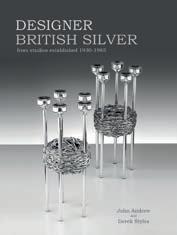
Above right Eric Knowles is ‘best on the box’
Above left Salvage Hunters star Drew Pritchard, image Drew Pritchard
Below left Henry’s museum fell prey to the grey menace
How wonderful to see Eric Knowles join the team of my favourite antiques magazine (In the Knowles, March issue). He is, I think, one of the best antiques raconteurs on the box. As far as I am concerned his knowledge and a ability cannot be beaten.
Your readers may be interested to know back in the 1970s he used to appear on a programme called Heirloom hosted by the equally great John Bly which was lmed by Anglia Television in my hometown of Norwich.
It was before Antiques Roadshow and possibly the rst in what would become a long line of similar shows. While lming he used to stay at the historic Maid’s Head hotel in the centre of the city where I once bumped into him. Not the greatest claim to fame, but it stuck with me and I’ve been a fan ever since!
Tony
Westly, Norwich, by email
‘When we emerged from the pandemic I felt duty bound to make the pilgrimage to Conwy to see his shop (now closed) in the flesh. We were lucky enough to meet Drew and he was charm itself’

The answers to the quiz on page 40. Q1 (b). Q2 (c). It refers to a mid 17th-century depiction of a carved, bearded head thought to be of Charles I. Q3 (a). Also called a ‘c’ scroll. Q4 (d). Q5 (c). First struck under James I representing the Union of the Crowns. Q6 (b). Q7 (d). It was also known as a lading-can. Q8 (a). Q9 (b). Q10 (c).
The words punk cowherd can be rearranged to form the phrase punched work; Turks seabag is an anagram of the words sugar basket; oven sins can be rearranged to make the word venisons and a cold run is an anagram of the kitchen utensil cauldron.
LETTERS Have your say 10 ANTIQUE COLLECTING
Drew
Star
letter
The Canterbury Auction





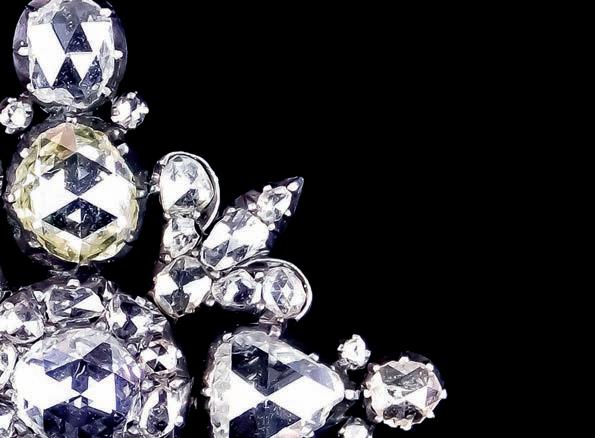
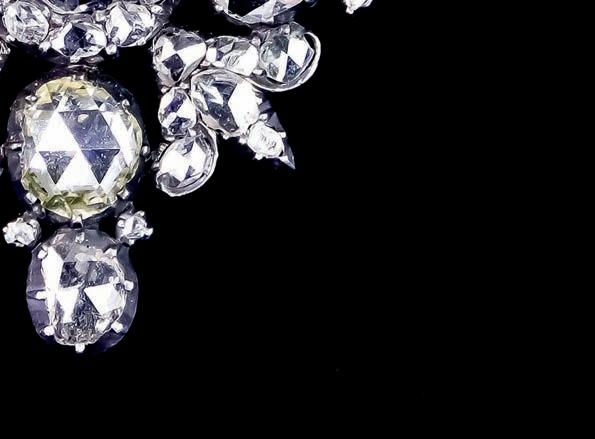
Friday 12th / Saturday 13th April Consignment



Galleries
AUCTIONEERS SINCE 1911 thecanterburyauctiongalleries Lot 705 A Late Victorian 9ct Gold and Silver Diamond Set Cross, set with sixty natural rose cut diamonds Sold for £2900
FINE ART
deadline 8th March
Established in 1911, we are Kent’s leading auctioneers and valuers of Art • Collectibles • Antiques • Jewellery • Clocks • Coins • Ceramics • Watches • Gold • Silver Telephone: 01227 763337 Email: general@tcag.co.uk Visit: www.thecanterburyauctiongalleries.com
Friday 7th / Saturday 8th June Consignment deadline 3rd May FORTHCOMING AUCTIONS
A ROUND the HOUSES
A collection of Dr Who annuals were a surprise hit in Kent while an early Australian coin found in a charity shop proved to be a bargain
Halls, Battle
e top seller at the Shropshire auction house’s recent sale of contemporary Moorcraft was a large, limited-edition standing vase in the Ryden Lane pattern, which had been expected to make £700-£900 but ended up fetching £2,700.
e vase, designed by Rachel Bishop in 1999, went to an American buyer who held o competition from a determined under bidder.
At the same sale another vase by Bishop, this one a Moorcroft Prestige jardiniere in the Tree Bark ief pattern sold for £2,300, beating its estimate of £800-£1,200. e limited-edition vase, numbered 40 of 50 and 86cm tall, was dated 1997.
e entire collection, owned by a late Oswestry collector, sold for more than £27,000, beating its total guide price of £18,000.
Halls’ ceramics specialist, Caroline Dennard, said: “Modern Moorcroft retains its commerciality because it is one of the very few long-standing English potteries which is still producing ceramics made in England.
“Limited editions are always popular and the Prestige jardiniere and stand were from one of the most sought-after ranges, which includes pieces that are both intricate in design and large in size.”
Roseberys, West Norwood
A rare enamelled plate by the French polymath Jean Cocteau (1889-1963) sold for £23,600 at the south London auctioneer’s rst design sale of the year, beating its guide price of £7,000-£9,000
Entitled Jeunesse FrancoAllemande, it was made in 1963 – the last year of the novelist, playwright and lmmaker’s life and, as one of an edition of ve, was a very rare piece.

The sale may have set an auction record for a non-unique work by Jean Cocteau
Cocteau’s career spanned more than 50 years during which he became a leading gure of the avant-garde. In 1957, he turned his hand to ceramics, taking on an apprenticeship under Marie Madeline Jolly and Philippe Madeline in their studio in Villefranche-sur-Mer. Here, he went on to create up to 300 works, including the recent lot.
Potter and Potter, Chicago
Thief pattern sold for £2,300
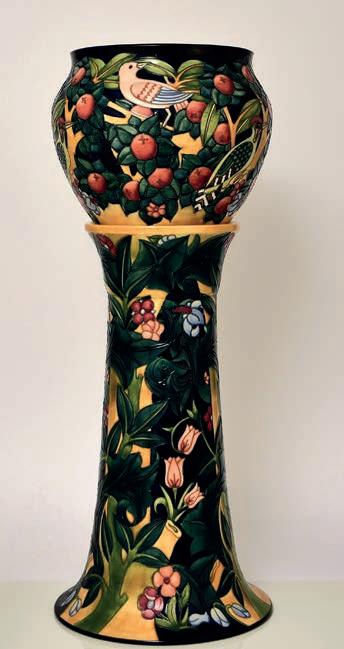
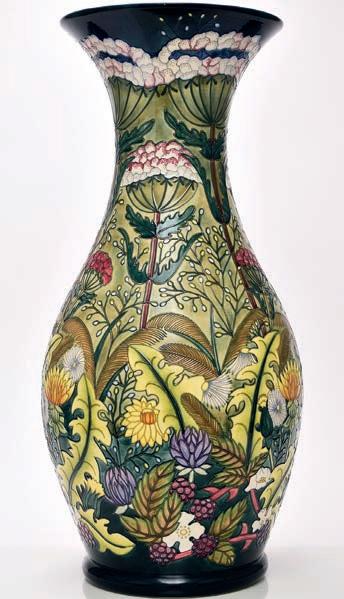
A pair of photo albums featuring the British actor Jeremy Brett (1933-1995) as Sherlock Holmes, a role he played from 1984 to 1994, was the second highest-selling lot at a sale devoted to the iconic detective at the Illinois auction house. One album was made up of 80 colour photos of Brett as Holmes and Edward Hardwicke (1932-2011) as Watson, while the other was made up of 22 snaps of Brett, some with the actresses Lillian Gish and Lauren Bacall. e albums, which both came from the estate of the actor who died in 1995 aged 61, were expected to sell for $150-$250 but realised $6,600.
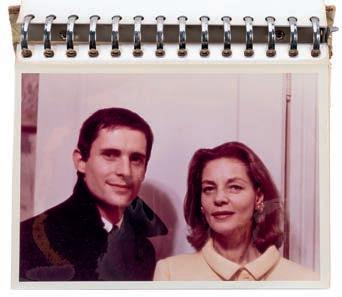
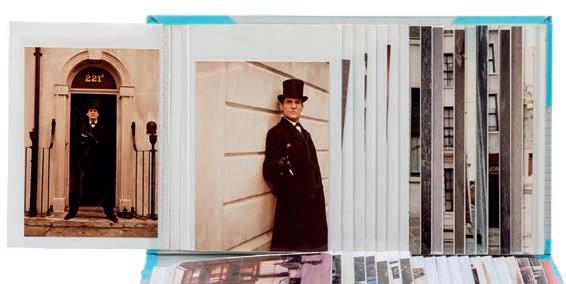
AUCTION Sales round-up 12 ANTIQUE COLLECTING
The Moorcroft standing vase, in the Ryden Lane pattern, is on its way to America
A Moorcroft Prestige jardiniere in the Tree Bark
One album included snaps of the actor with Lauren Bacall
Two photo albums belonging to Sherlock Holmes actor Jeremy Brett mystified buyers

Bishop & Miller, Glandford
A still life by the East Anglian artist Eloise Harriet Stannard (1829-1915) doubled its low estimate to sell for £6,000 at the Su olk-based auction house’s Norfolk saleroom.
e daughter of landscape and marine painter Alfred Stannard (1806-1889) and one of the Norwich School of artists, she focused on owers and fruit (few of which were native to the UK) in the style of traditional Dutch still-life painting.
Elstob, Ripon
The still life of chrysanthemums in a silver bowl was signed and dated 1887
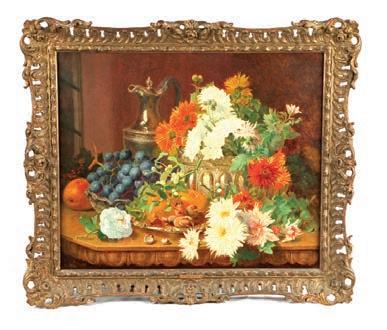
A rare pearl and diamond ring watch, c. 1800, almost doubled its low estimate of £10,000 when it fetched £19,500 at the North Yorkshire auction house’s recent sale. Consigned by a London collector, the quarter-repeating piece was signed by the Geneva-based company Achard & Fils, famed for its enamelled watches.
Made from 18-carat gold, the bezel edge is set with half pearls, diamonds and gold beading. Elstob’s David Elstob said: “It is one of only ve known quarter repeating ring watches. It was made by the Swiss maker Achard & Fils, a company founded in 1796 which ceased trading in the 19th century.”
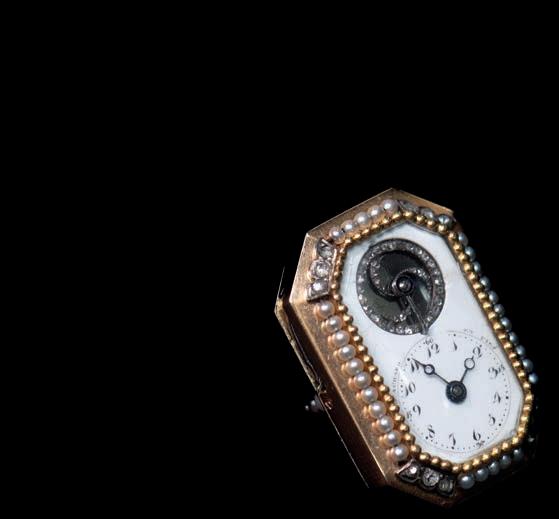
Noonans, Mayfair
The rare Swiss-made ring watch is one of only five known versions
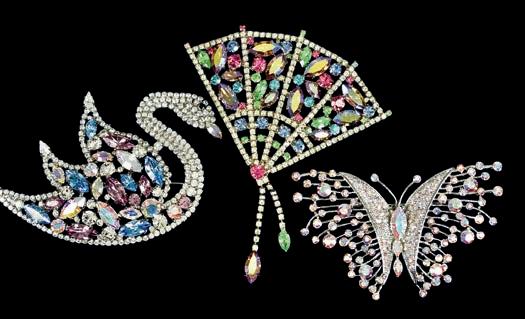
Vintage jewellery from the London maker Butler and Swan shone in Kent
e Canterbury Auction Galleries
ree costume jewellery brooches in the shape of a swan, fan and butter y by the London jewellers Butler and Wilson shone at the Kent auction house’s recent sale when they trounced their guide price of £80-£120 to sell for £720.
Founded in in 1968 by two antique dealers, Nicky Butler and Simon Wilson, the pair opened their rst boutique in 1972, soon attracting a celebrity client list. At the same sale a collection of early Dr Who annuals, from 1966 to 1979, expected to make £150-£200, sold for £580. Early annuals especially featuring Patrick Troughton are highly collectable and the set included the rare 1971 Jon Pertwee ‘pink’ annual.
Catherine Southon, Fairleigh
The collection of annuals included the 1971 ‘pink’ Pertwee edition

An Australian15 pence piece dating from 1813 discovered by a Kent Oxfam volunteer in a bag of coins sold for £7,500 against a low estimate of £5,000 at the London auction house. e coin was spotted by volunteer and coin enthusiast John Turner at the charity’s Orpington branch among a bigger bag of money. It had been commissioned by the governor of a New South Wales penal colony who called on a transported English forger to make coins for local circulation. e result became the country’s rst coins before Australia was o cially formed as a country. Of the 1,000 coins produced, the majority was melted down in the 1840s.
1813 coin was one of Australia’s earliest before it became a country


A pair of 1880 Doulton Lambeth sgra todecorated, stoneware vases by Hannah Bolton Barlow (1851-1916) almost doubled its low guide price of £1,500 when it sold for £2,600 at the Kent-based auction house’s Surrey saleroom. While the vases depicted a pride of lions, a stoneware salad bowl by the same maker, decorated with rabbits, beat its estimate of £400-£600, jumping to £1,400. e bowl had a silver rim and was incised HBB 534 with the assistant’s marks MA for Mary Aitken. Expert tube liner Hannah Barlow, one of two Barlow Sisters employed at theLondon factory, remains one of its most popular and most collectable artists.
The silver-rimmed salad bowl has a continuous sgraffito frieze of rabbits
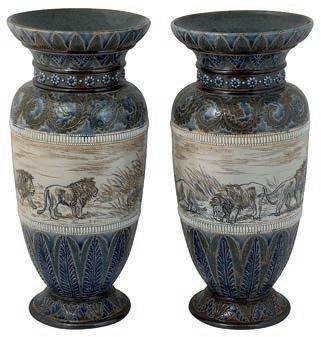
Hannah Bolton Barlow (1851-1916) is one of Doulton’s most collectable artists

ANTIQUE COLLECTING 13
The
AUCTION Sales round-up
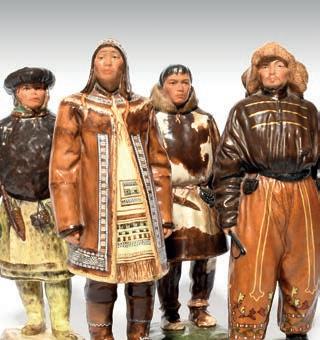
The set included (L-R) a Gilyak man from the Russian Far East, an Evens man from Kamchatka, a Chukchee man and a Kyrgyz man
The lifelike depictions, of a Chinese man and Sart woman from Samarkand, sailed past their estimates

Woolley and Wallis, Salisbury
Two large 39cm (15⅓in) porcelain gures of a Chinese man and a Sart woman, from a set of seven, beat their pre-sale estimates of £1,500-£2,000 to sell for £27,720 and £26,460 respectively at the Wiltshire auctioneer’s recent sale.
e set, made at the Imperial Factory in St Petersburg and depicting the di erent ethnic groups of early 20th-century Russia, had been expected to make £7,500£10,000 in total but ended up selling for nearly £125,000.
e lifelike gures, commissioned to celebrate 300 years of Romanov rule, were made at the request of Tsar Nicholas II, comprised 73 di erent ethnicities in a total of 146 gures.
e auction house’s ceramics specialist, Clare Durham, said: “ e lifelike series, sculpted by the artist Pavel Kamensky, was supposed to include 400 gures in total before the enterprise was cut short by the 1917 Russian Revolution.
“ e idea was to celebrate the diverse costumes and cultures that made up the Russian Empire in the early 20th century.”
She added; “ ese gures seldom come up at auction (especially in the larger size) and this collection had not been on the market since the 1920s. Even so I think we are approaching record prices for them.”
Excalibur Auctions, Kings Langley
Harrison Ford’s script for the rst ever Star Wars lm lmed at Elstree in 1976 sold for £10,795 against a low estimate of £8,000 at the Hertfordshire auction house.
It was scooped up by the Notting Hill family who had rented out rooms to the actor and went on to befriend him.
During his time with them he was visited by the glitterati of Star Wars including Carrie Fisher and Mark Hamill, neither of of whom were known to the family. Alongside the script Ford left shooting schedules, a call sheet and a collection of notes which sold for £4,800 to a UK buyer.

The script was a revised fourth draft of Star Wars Episode
IV: A New Hope
Fellows, Birmingham
A general service medal awarded to a soldier from the famous Connaught Rangers who fought in some of the bloodiest engagements of the Peninsular War, beat its low estimate of £2,000 to sell for £2,850 in the Midlands.
Dennis Larazy served between 1793 and 1814 as part of the 88th Foot who earned the nickname, the ‘Devils Own’ due to their reputation as erce ghters.

The six-clasp military medal belonging to one of the ‘Devil’s Own’ sold for £2,850
Many of the men were recruited from rural west Ireland, with not all of them able to speak the King’s English. Larazy’s heavy accent may have helped his ctitious claim to be a Portuguese translator (as recounted in the young Irish Lieutenant William Grattan’s book e Adventures of the Connaught Rangers) despite having no knowledge of the Iberian language.
Among his many battles, Larazy fought in the bloody encounter at Busaco in 1810, a ght for which the Duke of Wellington commended the Connaughts for heading the most gallant charge he had ever witnessed.
Chiswick Auctions, London
A set of 10 lithographs on velum by the Canadian American artist Agnes Martin RCA (1912-2004) ew past its pre-sale estimate of £3,000-£5,000 when it sold for £27,000 at the London auction house’s Barley Mow saleroom.
The lithographs had titles including Instant Response To Love, Innocent Love, Children Playing and Happiness-Glee
Martin, who was born to Scottish Presbyterian farmers in Saskatchewan, moved to New York at the age of 19 and became an American citizen in 1950.
Often described as a minimalist or abstract expressionist, Agnes’s later signature style, which evolved over a 20-year period, was de ned by an emphasis on lines, grids and elds of extremely subtle colour. She was elected to the Royal Canadian Academy the year of her death, 2004.
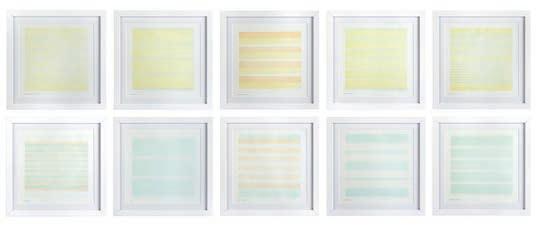
14 ANTIQUE COLLECTING









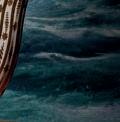







THE PETER BARKWORTH COLLECTION EARLY OAK ON SALE ERIC KNOWLES ALSO INSIDE Focus on Armenian rugs • Antiques puzzles Auction listings ANTIQUE COLLECTING VOL 58 N0.10 MARCH 2024 Royal Flush Startinga collectionof Maundy money On the Monet Pick up paintings by the Impressionist’s family for less than £4,000 ALL AT TEA! Dinner services owned by naval hero Horatio Nelson go under the hammer APRIL 2024 FABULOUS CREATURES Decoding the eccentric designs of Victorian ceramicist and polymath William De Morgan Inside: CATHERINE SOUTHON JOINS THE TEAM CHIME AFTER CHIME CHINESE ‘SINGING’ CLOCKS IN THE SPOTLIGHT SUBSCRIBETODAY • SUBSCRIBETODAY • SUBSCRIBETODAY • SUBSCRIBETODAY • SUBSCRIBETODAY • SUBSCRIBETODAY • SUBSCRIBETODAY TODAY • SUBSCRIBE TODAY • SUBSCRIBE TODAY • SUBSCRIBE TODAY • SUBSCRIBE TODAY • SUBSCRIBE TODAY SAVE 33 PER CENT AND GET 10 ISSUES A YEAR FOR JUST £25* PLUS a FREE BOOK and BAG when you subscribe to Antique Collecting SUBSCRIBE www.antique-collecting.co.uk/subscribe and enter code: ACDAPR24 Subscribe today and pay JUST £25 for your rst 10 issues rather than £38. Plus receive a FREE copy of Water Lilies and Bory LatourMarliac, the Genius Behind Monet’s Water Lilies and a jute bag* Each copy is packed with collecting guides and specialist advice. Don’t delay, this o er ends on April 30. e o er applies to new subscribers and new gift subscriptions only. * O er applies to new UK subscribers only ANTIQUE COLLECTING 15 Only £2.50 per issue! THEPERFECT GIFTIDEA Subscribe Now! ANTIQUE COLLECTING MAGAZINE •Give the gift that lasts all year and save 33 per cent on an annual subscription •Plus receive a free copy of Water Lilies worth £30 and a stylish jute bag

Waxing lyrical
David Harvey reminisces on almost half a century of themed exhibitions – most of them joyous others hazardous
Many years ago, my father who started the business, called me into his o ce and asked if there was anything I could think of to get more people interested in English antique furniture and speci cally visit our showrooms in Chalk Farm in London.
After pondering the question for a couple of days I came up with the idea of holding themed exhibitions.
e rst of which was in 1978 to mark the upcoming 200th anniversary of the death of the legendary cabinetmaker, omas Chippendale (1718-1779).
I then set about nding a range of Chippendaleperiod pieces and writing a catalogue to complement the exhibits on show. Since that inaugural event, setting up and cataloguing exhibitions has been an ongoing labour of love and, over the years, I have been lucky enough to work with some incredibly talented photographers, designers, writers, collectors and curators who have helped to make this almost an annual event – whether in Chalk Farm, Old Bond Street or, more recently, Corn Street in Witney, Oxfordshire.

Period ideas
Reconstructing a period room set in meticulous detail takes a considerable time but one of the hardest things is to think of a theme and nd a title. e idea of “an exhibition of recent acquisitions” never excited me, so I was always looking for that certain angle: whether a style, particular wood, or a maker – or even a room showing its development during the reigns of, say, Charles II to George IV. Having decided on the subject, or having had it dictated by a fresh acquisition, the hunt began for pieces to expand and illustrate the theme.
Overseeing the conservation of items to be included was a priority and had to be carried out in time for the catalogue’s photo shoot. is normally took place in the spring with each event taking the best part of a week.
Setting up the exhibition has to be run along military lines with truckloads of furniture and decorative items arriving early on a Monday morning, with the evacuation planned for the following Friday.
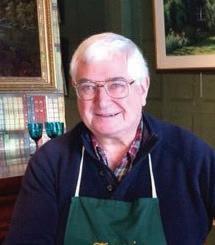

You can imagine the hilarity of the process and the wealth of anecdotes it has inspired over the years. Over the past almost half century I have been privileged to have been given access to some remarkable homes and institutions and would like to thank all concerned in making this possible.
So busted
I remember one shoot when the designer and I were forbidden from moving a marble bust on a pillar from the landing, which was in exactly the spot we wanted to place a Georgian longcase clock. But when the homeowner told us he was going out for the afternoon, we carefully replaced one with the other. But then, just as the camera’s shutter started to click, we heard the key in the door and double quick, dashed to restore everything to its original state, just as he was approaching the rst- oor landing!
Above Reconstructing a period room set in meticulous detail takes time
Above right Ditchley Park was the backdrop for this magni cent photo shoot
Right Arranging furniture for the perfect shoot can be hazardous

16 ANTIQUE COLLECTING EXPERT COMMENT David Harvey
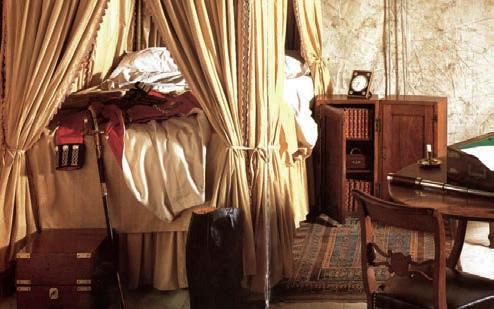
Campaign trail
Another shoot I recall most vividly showcased campaign furniture – a pioneering theme in its day.
My father approached his old regiment, the 16th/5th e Queen’s Royal Lancers asking for the loan of period pieces from its regimental museum to which they agreed. We then spent days in Wrotham Park in Hertfordshire, just outside Barnet, a glorious Palladian mansion, setting up the shoot. e pièce de résistance was to be a fully mocked up interior of a 19th-century commander’s tent, with campaign furniture in situ.
To create the atmosphere we rented a huge studio and acquired a massive tent from the army surplus store. It was in a lthy condition and appeared to have been whitewashed at some stage for winter manoeuvres.
After the shoot, during which the entire team was covered in clouds of ash-grey dust, we decided to retire to the local hostelry for a well-earned drink. I well recall the howls of laughter as we walked in, all of us appearing as something of a ghostly apparition.
Regardless, I went on to recreate the entire scene, tent and all, in the front window of my showroom at 5 Old Bond Street and I am delighted that the catalogue inspired others to embark on further research and publish books on the subject, including British Campaign Furniture: Elegance Under Canvas, 1740-1914 by Nicholas A. Brawer.
School’s out
To nish this account of the many years’ work, great fun and countless interesting moments, I can think of nothing better than a mention of Cokethorpe School, which is just outside Witney. e school’s headmaster has on several
‘The pièce de résistance was to be a fully mocked up interior of a 19th-century commander’s tent with campaign furniture in situ. To create the atmosphere we rented a huge studio and acquired a massive tent from the army surplus store. It was in a filthy condition and appeared to have been whitewashed at some stage for winter manoeuvres’
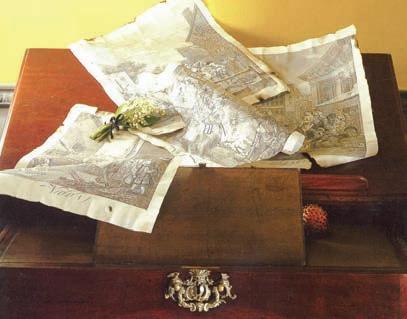
Oranges are not the only fruit
On another occasion we moved into a beautiful Adam-period house in central London, taking two days to set up the perfect shoot with a great team from World of Interiors
It was after hours of hard graft that the photographer deemed the light was too poor to continue. How do you pass the time in an 18th-century property? We sat around creating pomanders from fresh oranges and cloves waiting for the sun to reappear.
Happily our efforts and sore thumbs (cloves can be very sharp) were not in vain, and the results of our handicraft are still evident in that year’s catalogue. You can see one of them above.
occasions allowed me to use some of the rooms in the historical buildings, some of which date back to the 16th century, for catalogue photo shoots.
Above left David’s pioneering campaign furniture catalogue sparked later research
Above right A pomander takes centre stage in the catalogue
Below Cokethorpe School in Oxfordshire has staged a number of David’s shoots, image public domain
ese usually take place during the Easter Break, allowing us to be able to work without hundreds of school children to contend with.
For anyone who is interested in viewing the catalogues and the wealth of information they contain, I am delighted to say they have now been digitised and are available to view on my website.
David Harvey is the owner of Witney-based W R Harvey & Co. (Antiques) Ltd. For more details and to view the archived catalogues go to the website www.wrharvey.com

ANTIQUE COLLECTING 17
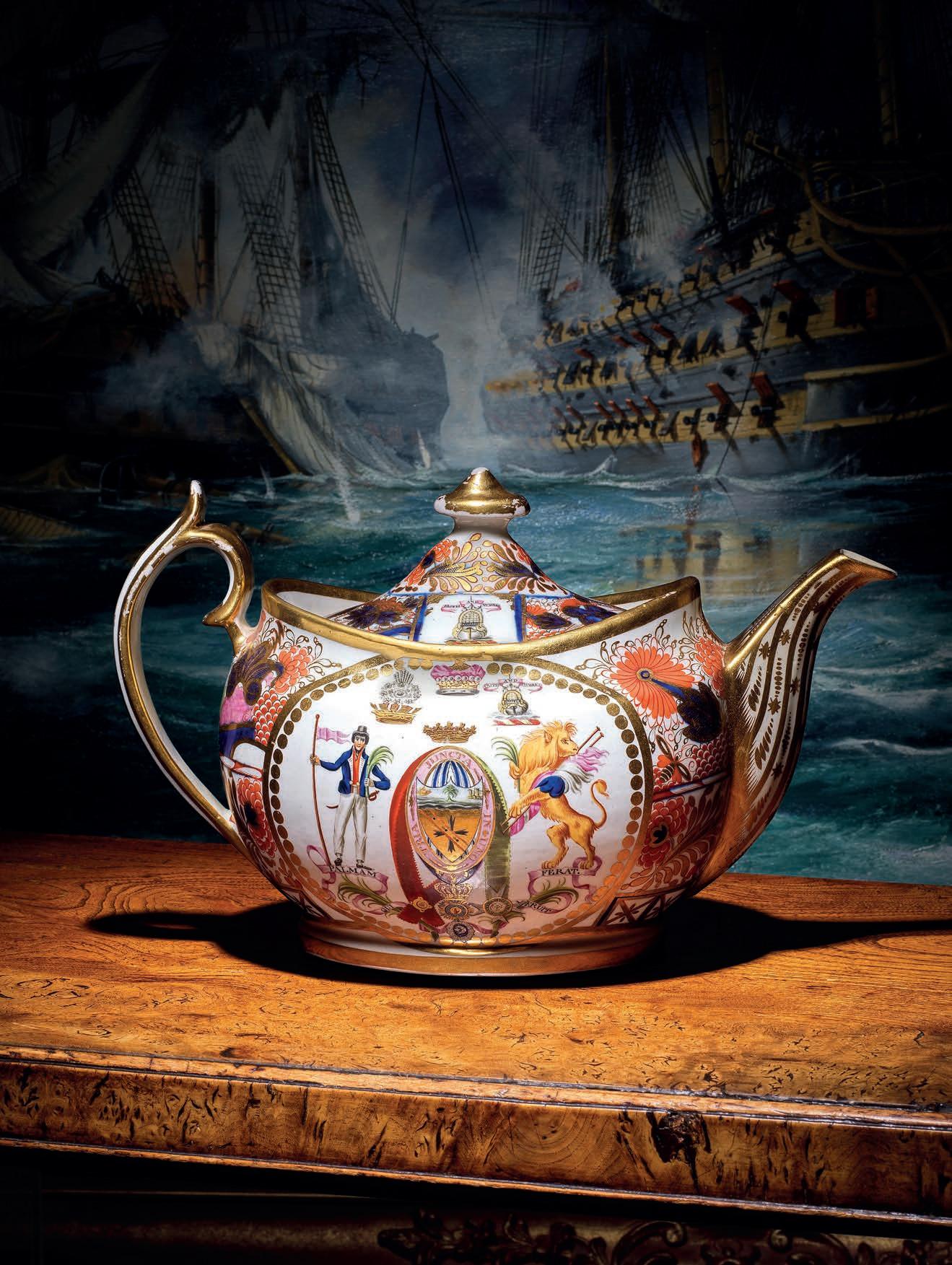
Naval Gazing
What better way to celebrate St George’s Day this month than with one of the biggest-ever single-owner sales of ceramics that belonged to Britain’s greatest naval hero – Horatio Nelson
COLLECTING GUIDES Nelson ceramics 18 ANTIQUE COLLECTING

As British naval heroes go, they don’t get much bigger than Horatio Nelson (1758-1805) whose death at the Battle of Trafalgar – shot in the chest by a French sniper after leading his men to victory– led to his near mythologisation by the adoring British public.
Tales of his daring seamanship and disregard for his own safety, not to mention his scandalous love life, are set into the national psyche. By one estimate, more than 2,000 books have been written about his life and half a dozen lms have captured his exploits. Nelson’s Column holds pride of place in London’s huge Trafalgar Square and his agship Victory is on display at the Portsmouth naval base.
Less well known, however, is the military man’s love of ne porcelain – the glitzier the better. is month on April 23, ttingly St George’s Day, some 130 lots of pottery, porcelain and enamels including those either owned or ordered by the naval commander goes under the hammer at Bonhams. Including high-end commemorative ware celebrating the admiral, it is thought to be the largest ever sale of its type.
Fine living
Like many men who achieve god-like status in their lifetime, Nelson could be forgiven for more than a touch of vanity. Caricaturists of the day such as James Gillray made fun of his penchant for draping himself in medals and orders in public. As well as his peer’s robe and medal of the Order of the Bath, he also famously sported a large gem-laden chelengk pinned on his cocked hat that had been presented to him by the Sultan of Turkey, Selim III, in gratitude for driving the French out of his territory. If the size of it wasn’t ostentation enough – it included 13 diamond rays representing the French ships captured or destroyed at the action – it contained a small mechanical device that, when wound, made its centre rotate in a clockwise motion.
Opposite page A Chamberlain Worcester teapot from the Horatia service, c. 1802-1804. It has an estimate of £25,000-£35,000 at this month’s sale. It includes Nelson’s full arms, including the motto of the Order of the Bath, with supporters of a sailor and a lion, a viscount’s coronet and two crests of the San Josef stern and a naval crown with chelengk, a ribbon beneath the arms inscribed with the motto Palam Qui Meruit Ferat, meaning let whoever earns the palm bear it
Above left JMW Turner (1775–1851) e Battle of Trafalgar, 21 October 1805. (1822-1824), National Maritime Museum, public domain
Below right A large jug with the impressive print depicting the death of Nelson, it has an estimate of £500-£700 at this month’s sale
Bottom right A printed and hand-coloured mug which incorrectly puts Nelson’s date of birth as September 26 not 29, it has an estimate of £200£300
Below A large jug painted and inscribed with the words G R Success to the British Fleet’ it has an estimate of £500-£700 at this month’s sale
Commemorative ware
The death of Nelson at the Battle of Trafalgar in 1805 was a great blow to the British people. People wept when they heard of his death and his funeral was the grandest state occasion of the era, taking place over five days.
By the time of his demise, the admiral had achieved a god-like status, having delivered the nation from its oldest foes of France and Spain.
Inevitably Nelson’s life and death would spark a huge industry in commemorative wares, with any place even remotely connected with him producing souvenirs ranging from postcards and bookmarks to glassware and ceramics.
As well as locations, his notable battles were commonly referenced, including Cape St Vincent in 1797, the Battle of the Nile in 1798, the Battle of Copenhagen in 1801 and his last and most famous victory, Trafalgar in 1805.
Added to this, later landmark celebrations were held in 1855 and 1905 with a whole new tranche of commemorative ware.
The makers of Nelson commemorative ware were typically pottery and porcelain manufacturers, as well as artisans specialising in ceramics. During the 19th century, when Nelson’s legacy was at its height of popularity, pottery makers including Wedgwood, Spode, Worcester and Coalport all produced ranges of commemorative items featuring his likeness and lauding his successful naval victories.
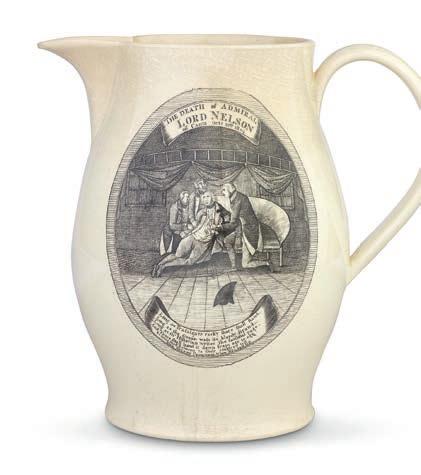
‘Feted throughout the land Nelson no doubt found himself bound to maintain the lavish lifestyle expected of him. He placed an extravagant order for a breakfast, dinner and dessert service to be decorated in the ‘Fine Old Japan’ pattern, number 240 – one of the most expensive service on offer –decorated in a rich Imari pattern’


COLLECTING GUIDES Nelson ceramics
So it may be no huge surprise that when it came to his dinnerware he favoured extravagance over restraint. Much of it was made for Nelson and his mistress Lady Emma Hamilton’s home in Merton Place in Surrey. Nelson paid £9,000 for his country retreat, which would become home to his unconventional ménage of Sir William Hamilton (Emma’s husband) and Emma and his own daughter, Horatia. Entertaining was to be at the heart of the house. In a letter to Emma he wrote: “We will eat plain, but will have good wine, and a hearty welcome for all our friends.”
Horatia service
Perhaps keen to impress his young mistress when furnishing their new home, and no doubt in uenced by his travels to foreign parts (Nelson had been given porcelain from Naples and Dresden as state gifts) he soon developed a taste for the grand and splendid when it came to the design of his personal china (much of it is now on display in the National Maritime Museum).
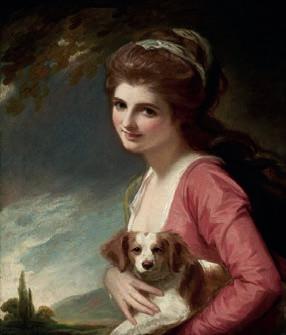
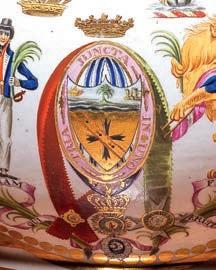
One of the highlights of the sale, expected to make £25,000-£35,000 is a Worcester Chamberlain teapot and stand from the couple’s famous ‘Horatia’ service, which the couple named after their daughter, born in 1801.
It was the late summer of 1802 when Nelson, having beaten the French in the Battle of the Nile and the Danes in the Battle of Copehagen, decided to make the most of a lull in hostilities with a tour of Wales and the West Country. With mistress Emma and her husband Sir William, the unusual trio set o to Worcester.
Local hullaballoo

Abuzz with excitement the local paper reported: “ e gallant Admiral was in good health and spirits; he wore on his breast the insignia of the several orders with which he had been honoured for his glorious achievements, and granted the exulting crowd by repeatedly appearing at the window and bowing to them with the most graceful condescension.” Accompanied by a musical band the lauded visitors made their way to Chamberlain’s China Works in Severn Street. In the painting room they met a young china painter named James Plant who later described how “a battered looking gentleman made his appearance. He had lost an arm and an eye. Leaning on his left and only arm was the beautiful Lady Hamilton, evidently pleased at the interest excited by her companion: and then amongst the general company came a very in rm old gentlemen. is was Sir William Hamilton.”
Fine Old Japan
Feted throughout the land, Nelson may have found himself duty bound to maintain the extravagant lifestyle expected of him. He thereby placed an order for a breakfast, dinner and dessert service to be decorated in the ‘Fine Old Japan’ pattern, number 240 – one of the most expensive service on o er – decorated in a rich Imari pattern.
‘ e factory’s order book records the sale of a breakfast service of approximately 137 pieces (including the breakdown of payment for the hand-painting of 150 each of coronets, crests and other armorial elements, and “1 Complete dinner service” along with “1 Complete dessert service, with ice pails”to be delivered to the “Right Hon. Lord Nelson Duke of Bronte, No. 23, Piccadilly, opposite the Green Park”.’
e breakfast service, designed for 12 people and costing £120 and 10 shillings, was to feature Nelson’s four crests (each costing two shillings and sixpence per image) and was made up of two teapots, cups, bowls, plates, honey hives and butter tubs with the most expensive items being a pair of water plates and their covers.
While specimen pieces exist for the other two services, they were not completed.
Top George Romney (1734–1802) Lady Hamilton as Nature, 1792, Frick Collection, public domain
Above left Nelson’s family crest as it appears on the Chamberlain Worcester teapot from the Horatia service, c. 1802-1804
Above right e Chamberlain Worcester butter tub from the Horatia service, c. 18021804. It has an estimate of £6,000-£8,000
Left Lemuel Francis Abbott (1760-1802)
Rear-Admiral Sir Horatio Nelson (17581805), 1799, National Maritime Museum, public domain

Unpaid invoice
Work on the breakfast set probably commenced in September 1802 and it took around two years to produce every piece. Nelson would have enjoyed seeing it in all its splendour at Merton when he was at home brie y in August and September 1805.
e service was listed in an inventory of Lady Hamilton’s possessions from Merton c.1813, noting several pieces broken by Emma or her guests or now missing. e set had not been paid for by the time of Nelson’s death, however, and in January 1806 Chamberlains submitted a nal account for the porcelain. ey eventually received payment from Nelson’s estate. High cost may have been why the other two services were never completed.
Inherited by Emma, she and her creditors dispersed and scattered the porcelain by gift and sale, including to Nelson’s family. e water plates can be seen in the Maritime Museum. Nelson specialist and dealer, Martyn Downer, said: “Other pieces have been sold by auction in recent years including a plate (£31,250, Bonhams London, October 2017), a butter tub (£11,312, Bonhams London, June 2019), a teapot (£32,700, Sotheby’s London, June 2001) and an egg cup (£7,440, Sotheby’s London, October 2005).”
20 ANTIQUE COLLECTING
Coalport cup and saucer
While invoices can help document the ceramics Nelson ordered, less easy is discerning if the great man ever ate his breakfast from them, or sipped a cup of tea –whether on land or sea. Bonhams British ceramics specialist, Anna Burnside, said: “Even during the periods Nelson didn’t go ashore, provisions including letters and gifts would have been brought aboard. Clearly not entire services but some elements.”
Which pieces may have made their way from Merton to one of Nelson’s ships is di cult to say. But one such is another highlight of this month’s sale – a Coalport cup and saucer by the ceramics decorator omas Baxter, dated 1804, which has an estimate of £15,000-£25,000. We know Baxter was commissioned to create a number of pieces depicting Emma including the one-o cup and saucer.
In a letter written to Emma on May 27, 1804, while aboard the Victory, Nelson gives a tantalising hint that the cup and saucer may have made their way to sea. He writes: “I write you, this day, by Barcelona. Your dear phiz--but not the least like you--on the cup, is safe: but I would not use it, for the world; for, if it was broke, it would distress me very much.”
e saucer is embellished with an anchor and ‘N&B’, the B standing for Bronte referencing his muchloved title of the 1st Duke of Bronte KB (he was even said to have wanted to give Horatia the second name Etnorb, the revese of the word Bronte (overruled by Emma).
e Baltic set
Another highlight from the collection is a Londondecorated Paris porcelain teapot and cover from what became known as the Baltic service, which has an estimate of £20,000-£30,000 and, like the Horatia service, appears in the Merton inventory.
e set was part of a presentation of chinaware given to Nelson in 1802 by the Ladies of the City of London at a banquet following a procession in his honour. Nelson’s niece, Charlotte Nelson, Duchess of Bronte, who accompanied him described the excitement of the event. She wrote ‘... All the ladies had their handkerchiefs when my uncle passed, they and the people calling out “Nelson for Ever.”’
In all likelihood a number of Baltic sets were made, the various versions of which were made up of a tea service and a dessert set both of Paris porcelain and a dinner set believed to be creamware. Another slightly larger set belonged to Nelson’s sister Catherine ‘Kitty’
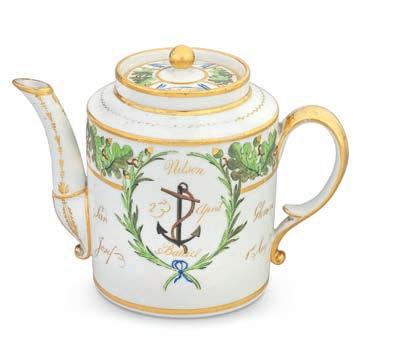
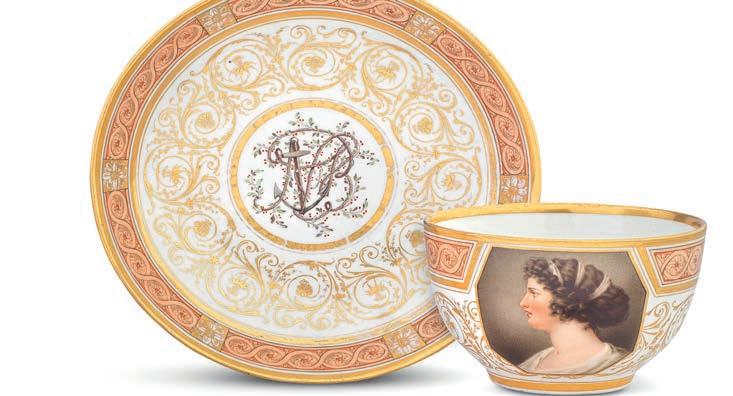
Close friendship
Thomas Baxter (1782-1821) headed one of the most renowned enamelling studios of its day. Born in Worcester, the family soon moved to London where he learned the skills of china painting from his father at a workshop off Fleet Street decorating blanks in the latestFrench styles. Baxter specialised in figures but,unlike most ceramic decorators who attemptedportraits of famous people, when it came to Lady Emma Hamilton, he had first-hand knowledge of his subject, having made several trips to Merton between 1802 and 1805 and striking up a close personal friendship with her.
Above A Coalport cup and saucer by omas Baxter (1782-1821), dated 1804. It has an estimate of £15,000-£25,000 at this month’s sale
Below left A Londondecorated Paris porcelain teapot and cover from Nelson’s Baltic service, c. 1802. It has an estimate of £20,000-£30,000
Below ree graduated platters from a creamware Baltic service, c. 1802, impressed ‘Wilson’, marked no.92. ey have an estimate of £1,000-£1,500
Below right A sauce tureen on a xed stand and cover from a creamware Baltic service, c. 1802. It has an estimate
His sketches of her and Horatia (in the National Maritime Museum) attest to their close personal friendship. Like many artists of the day Baxter often depicted his subjects, including Emma, in a classical pose.
Matcham. Another went to Nelson’s brother, William from where the teapot in this month’s sale may derive.
Anna Burnside said: “While it was decorated in London, the teapot is distinctly French in shape which you can see by its tall, cylinder shape andsloping shoulders. e idea that it was made of Paris porcelain – the capital of Nelson’s great enemy France, may not have been mentioned by the ladies who presented it.”
Most ofthe Baltic creamware dinner service was used at Merton andit is possible that someother pieces were sold to Nelson’s captains or admirers.
Several pieces of theBaltic creamware service, some marked for David Wilson & Sons, Hanley, Sta ordshire appear in this month’s sale, including pieces acquired by Archibald Primrose, 5thEarl of Rosebery (1847-1929), who was fleetingl prime minister from 1894-1895.
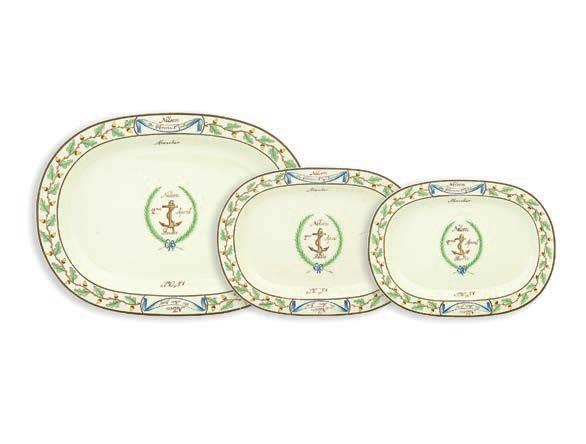
Nelson Forever! A Naval Legacy in Ceramics and Glass is at onhams Knightsbridge on Apri
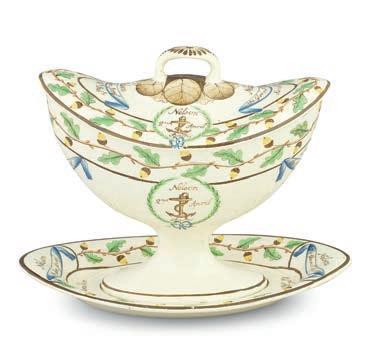
ANTIQUE COLLECTING 21
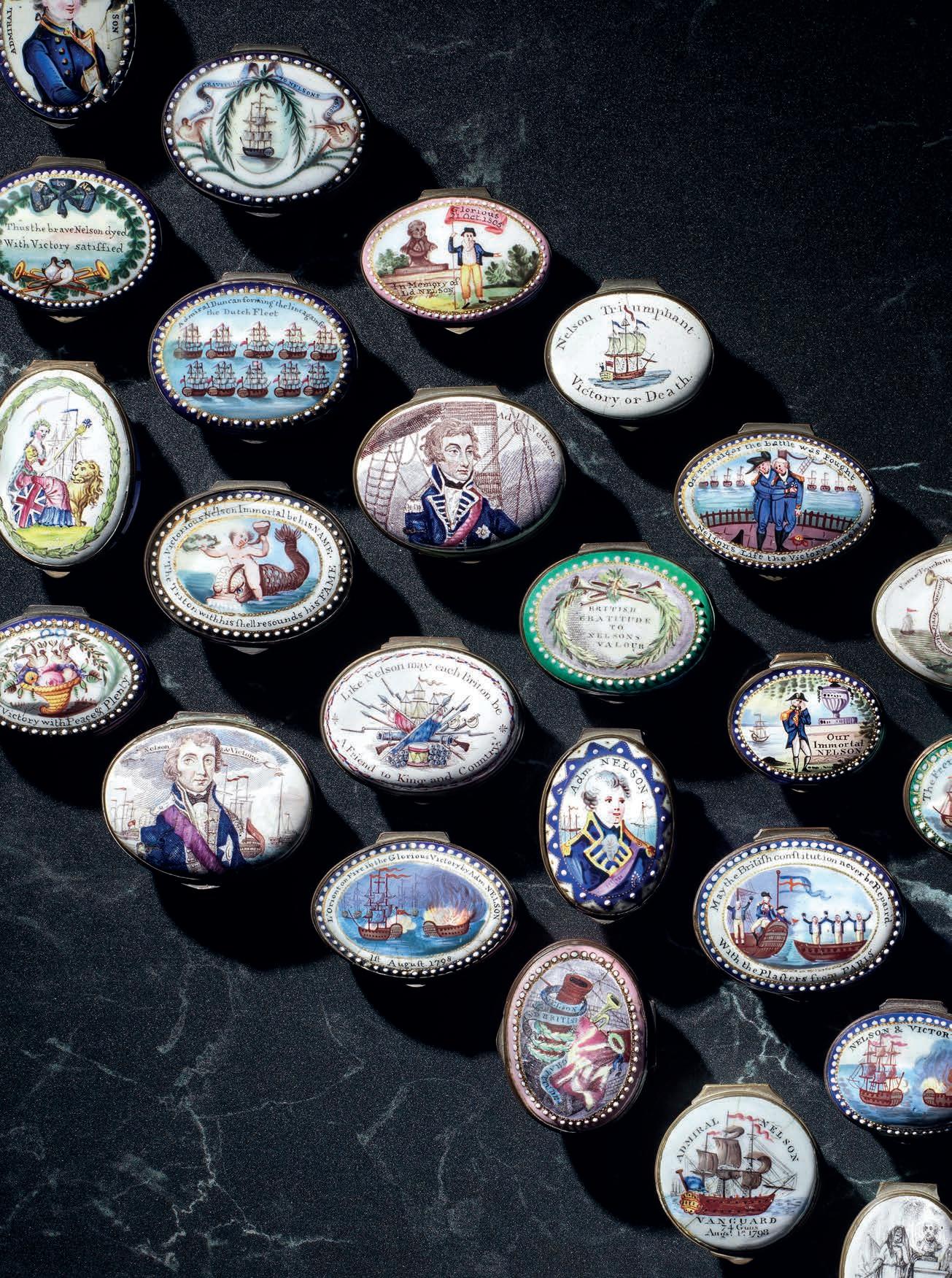
Patch Perfect
e sale also includes a large number of enamelled patch boxes, made in their thousands to celebrate the life and death of Nelson
‘While patch boxes as a container for patches (to cover facial scars or blemishes) had largely gone out of fashion by the mid 1770s, the Georgian obsession with boxes had not. Many had evolved into trinkets (often given as gifts) to house anything from sweets – to mask bad breath – to tweezers’
22 ANTIQUE COLLECTING COLLECTING GUIDES Nelson ceramics
An astonishingly large numbers of patch boxes were produced to honour the admiral both during and after his lifetime, generally including rousing patriotic mottoes dedicated to his service. e National Maritime Museum in Greenwich has a collection of more than 130, most of them di erent.
Some were produced to celebrate his key naval victories, but the majority were made after his death at the Battle of Trafalgar in 1805.
While patch boxes as a container for patches (to cover facial scars or blemishes) had largely gone out of fashion by the mid 1770s, the Georgian obsession with boxes had not. Many had evolved into trinkets (often given as gifts) to house anything from sweets – to mask bad breath – to tweezers. While the well-heeled might have commissioned jewel-encrusted gold or silver gilt examples, or even handpainted porcelain versions, the more mass market boxes were made from enamelled copper.
Boxes were made from thin copper sheets coated with a layer of opaque white or coloured glass made from powder. When heated in a small furnace, the glass melted and fused to the metal, ready for decorating. Decoration was either by painting, transfer printing, gilding or a combination of all three methods. Because enamels change colour at di erent temperatures – some more quickly than others – skill, patience and artistic talent were required to achieve the most intricate designs.
Bilston boxes

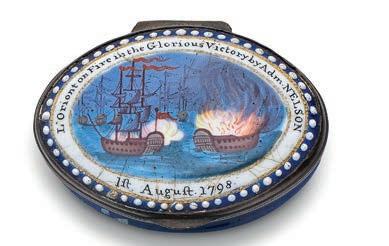

Major manufacturing centres for enamelled patch boxes were established in south Sta ordshire around Birmingham, which in the 18th century had earned the name as the metal workshop of the world. While the quality of enamelling varied from town to town, it was the towns of Bilston and neighbouring Wednesbury, which soon became renowned for the quality of their work.
For dedicated collectors, identifying Bilston makers is tricky (although we know the town’s makers had a preference for pink). ere were no big factories, and no identifying marks. A single box involved many workers, often from interconnected families. A workshop at the rear of the house provided the space for the essential tools of the trade: a workbench, a few tools and a mu er furnace for ring. One or two families, however, developed their business further including the Bickley family and the Becketts who were producing enamelled boxes in Bilston for more than a century.
e main period for the production of the Bilston enamels was roughly 1760 to 1790, with the trade virtually extinct by 1820. Depicting the life and death of Nelson may have been among the enamellers’ last great hurrah.
1 Two South Sta ordshire enamel boxes painted with Britannia mourning, one inscribed ‘England mourn and drop a tear the Victory’s great but Bought too dear’, £600-800 2 Enamel box, printed and hand-coloured with a Man ‘o War and the motto Nelson Triumphant, Victory or Death, £500-£700 3 Enamel box painted with a half-length portrait of Nelson before masts and rigging, £350-450 4 Enamel box painted with the fatally wounded Nelson supported by Captain Hardy aboard Victory, inscribed ‘O Trafalgar the battle was Fought, Nelson’s Life the Victory Bought’, £700-1000 5 Enamel boxes painted and inscribed for Britain’s victory over the French at the Battle of the Nile in 1798, £600-800 6 Enamel box painted with Nelson and triumphant sailors, the patriotic inscription ‘May the British constitution never be Repair’d with the Plasters from Paris’, £400-500 7 Enamel boxes painted with ‘Nelson & Victory’ and with the Admiral mourning by a monument to his fate, £600-900 8 Enamel box painted with a sailor by a monument to Nelson, his ag pronouncing the ‘Glorious 21 Oct 1805’

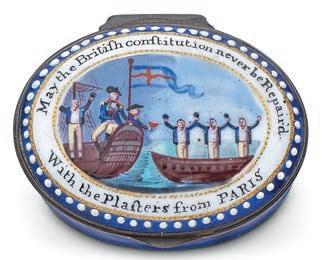



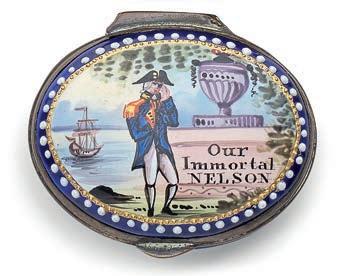
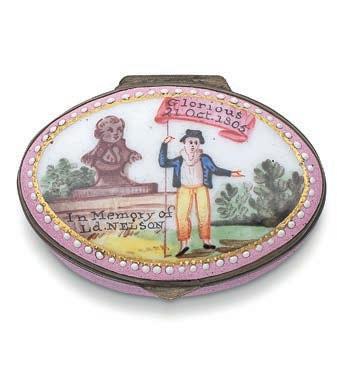
1 4 2 3 5 6 7 8


WLOTS to TALK ABOUT
Before photography, silhouettes were the easiest way to capture the faces of loved ones, writes new columnist Catherine Southon
e have auctioned a number of silhouettes over the years, but nothing quite like the collection recently discovered by a member of my team in a local house call. It comprises of more than 22 silhouettes, many by John Miers and other leading names, and will be auctioned at our saleroom in Fairleigh, near Warlingham, in Surrey in May.
Few other portraits conjure up the sense of mystery and intrigue as a silhouette. Unlike detailed portraits, that meticulously depict every facial feature and expression, silhouettes rely on the contrast between light and dark to create the merest outline of the subject leaving the viewer to ‘ ll in the gaps’ speculating on the life and personality of the subject.
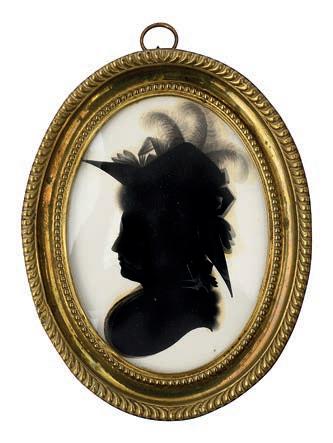
And then there’s the fashion. Because silhouettes were popular across all levels of society, they give us a unique insight into the styles of the day – from women’s hair, jewellery and accessories to gentlemen’s cravats.
My favourite in the upcoming sale shows an interior scene of a seated man reading a letter painted on glass by William Hamlet the Elder ( .1785-1816). It is so beautifully detailed we can even see the letter is addressed Beverley, Yorks and begins Dear Brother. It is both intimate and theatrical leaving the onlooker wondering who both the letter writer and recipient are.
Cut above
Silhouette cutting originated in the early 18th century when an artist (often a young woman) was hired at a gathering to record its most distinguished guests.
Cut from card, they were known as ‘pro les’ or ‘shades’ and the fad soon spread to the general public as an a ordable alternative to traditional painted miniatures.
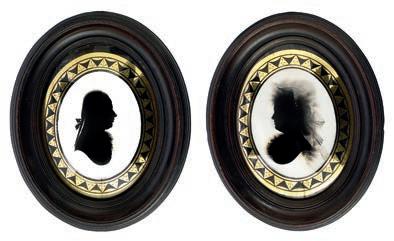
Soon artists were travelling to county fairs and small towns capturing the pro les of the general public across the UK. Before the advent of photography it was the only inexpensive way to record the generations.
It was only in 1835, the term silhouette entered the French dictionary. According to some, it was the mid 18th-century French nance minister Etienne de Silhouette’s relentless taxation of nobles that led to the public’s sardonic use of silhouette to mean “cheap.”
John Miers

While the earliest versions relied on cut paper, others were painted on ivory, plaster, paper, card or in reverse on glass. Among the notable artists associated with silhouette portraiture, John Miers (c.1758-1821) stands out.
Born in Leeds, the son of the painter of coach signs, by 1781 he had set up his own business as a “painter, gilder & pro list”. After establishing a business in Edinburgh, he operated in various northern towns before setting up studios in London where it took customers two minutes to sit for a silhouette, the price for which ranged from 7 shillings and sixpence to one guinea.
His attention to detail was second to none, with delicate shading creating expressive pro les, hair and clothes. By 1792 Miers was assisted by other pro lists, the most notable of which was John Field (1772-1848) who remained with him for the next 30 years and to whom a lot of work from the studio is ascribed.
Less is more
But before long, photography had taken over as the most e cient way of capturing a loved one’s likeness and the popularity of silhouette portraits declined.
Above John Miers (17581821) a silhouette portrait of a lady facing right, 12 x 9.9cm. It has an estimate of £100-£150 at next month’s sale
Left Studio of John Miers (1758-1821) a pair of silhouette portraits of a lady and gentleman, painted on white plaster, 18 x 14.7cm. It has an estimate of £300-£500
For today’s collector, a group of silhouettes is not just a tantalising glimpse of bygone days, they look terri c hung in clusters above a desk, or framing a window, or artfully posed running up a staircase wall.
ere is no doubt that through the skillful hands of artists like Miers these simple yet powerful images have left an indelible mark on the art world, proving that sometimes, less is truly more.
e collection of silhouette portraits is part of Catherine Southon’s antiques and jewellery auction on May 15 at the Kent-based auction house’s Farleigh Court saleroom in Surrey. Estimates range from £100 to £800, for more details go to www.catherinesouthon.co.uk
‘Cut from card, they were known as ‘profiles’ or ‘shades’ and the fad soon spread to the general public as an affordable alternative to traditional painted miniatures. Soon artists were travelling to county fairs and small towns capturing the profiles of the general public’
24 ANTIQUE COLLECTING
Above right William Hamlet the Elder, British, ( .1785-1816) silhouette painted on glass of an interior scene, 29.7 x 23.5cm. It has an estimate of £200-£300 at next month’s sale
EXPERT COMMENT Catherine Southon

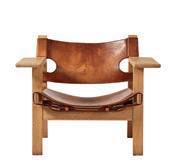

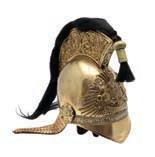


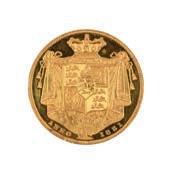



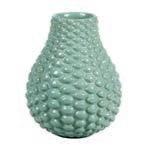
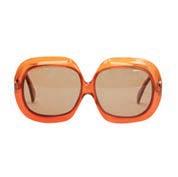
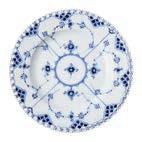
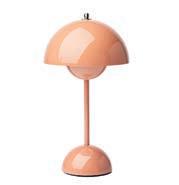

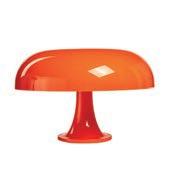


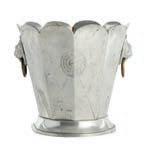
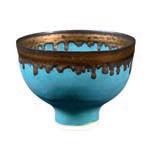

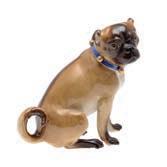
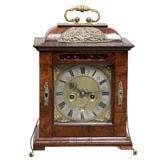

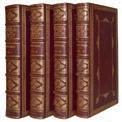
Explore a World of Valued Objects at auctionet.com
RENAISSANCE MAN
Ware among the most recognisable and enduringly popular decorative arts of the late Victorian period.
e boundaries of his imagination were seemingly endless, from the technical (he singlehandedly revived the ancient glaze of lustre ware) to the lyrical (he went on to author seven popular novels). e scope of his designs ranged from Pre-Raphaelite medievalism and Italian Renaissance majolica to ancient Middle Eastern motifs. An ongoing exhibition at Blackwell, the Arts and Crafts House, in Bowness-onWindermere in Cumbria, this month showcases De Morgan’s many talents focusing on symmetry, pattern and shape.
Liberal background
Born in London’s Gower Street in 1839, William Frend De Morgan was the son of the distinguished mathematician Augustus De Morgan and his wife Sophia Elizabeth Frend, a highly educated woman who was an advocate for women’s higher education and an early supporter of the su ragette movement.
Being born into a liberal middle class family no doubt made it easier for him to follow his heart and, when it came to his education, at the age of 20 he entered the Royal Academy schools.

is proved presumably not entirely satisfactory, judging from the fact he left with four years to go. e
young De Morgan then showed a distinct uncertainty as to the direction of his career and he dabbled more or less successfully in various pursuits. His circle of friends included Edward Burne-Jones, Dante Gabriel Rossetti, Philip Webb, and, perhaps most importantly, William Morris. Apart from introducing De Morgan to the applied arts in general, Morris also brought him into the centre of the arts and crafts movement.
William Morris
From the 1860s onwards, stained glass enjoyed a major revival as Morris and his contemporaries re-popularised the arts of the medieval period, providing stained glass windows for both church restorations and domestic buildings. Having tried and dismissed traditional painting he turned to stained glass and the painting of some of Philip Webb’s furniture. Although De Morgan soon distanced himself from Morris’ dogmatic and sometimes utopian viewpoint of the arts and crafts movement and of his own production within it, this period was nevertheless of utmost importance to the development of his interest in pottery. An interest that led to one of the most proli c and exciting periods of ceramics production of the Victorian era
It seems to have been De Morgan’s work with stained glass that ultimately kindled his interest in pottery by introducing him to lustre glazes and their complex chemistry. De Morgan found himself experimenting with various glaze components and ring techniques which he tested on blank tiles. is coincided with a boom in decorative tiles in the late 19th century.
26 ANTIQUE COLLECTING
COLLECTING GUIDES William De Morgan ceramics
Above William De Morgan (1839-1917) gourd-shaped vase with Persian decoration, c. 1890, credit De Morgan Foundation

Commercial tile making
De Morgan began to experiment with tile decoration in his studio at London’s Fitzroy Square. ere were a number of tile manufacturers at the time, including Minton’s and Maw & Co., as well as several outlets where tiles were sold. One of these of course being William Morris’ own Morris & Co.
So De Morgan entered the world of commercial tile making. Initially his designs owed much to Morris and mainly featured owers and leaves, often done so they could form an in nite pattern for use in friezes and replaces. However, his imagination set him o in a direction of ever expanding ideas to the point when he felt con dent enough to start a business on his own.
De Morgan’s rst proper kiln was set up at 30 Cheyne Row in Chelsea where ring could be conducted safely in a shed in the back garden. e roof of his
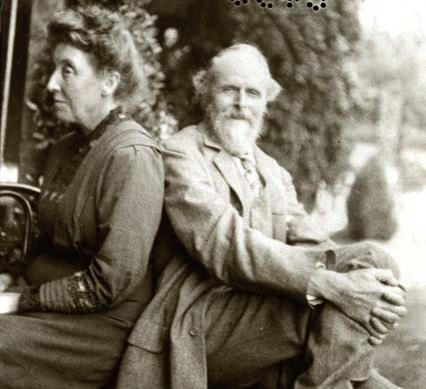

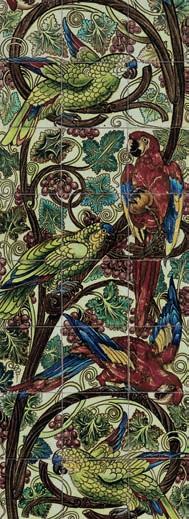
Above left William De Morgan (1839-1917) ogee pattern tile, c. 1890, credit De Morgan Foundation, all images unless stated © Trustees of the De Morgan Foundation
Above William De Morgan (1839-1917) parrot tile panel, c. 1890, credit De Morgan Foundation
Above right William De Morgan (1839-1917) a tile in the master bedroom at Blackwell, the Arts and Crafts House
Below left Evelyn De Morgan (1855-1919) with her husband William, c.1900 © Trustees of the De Morgan Foundation
Below right William De Morgan (1839-1917) Bear and Hare dish, c. 1890, credit De Morgan Foundation
‘De Morgan cleverly created intricate repeating patterns which could be used to great effect. Some of his early designs from this period became hugely popular and were in production for almost 30 years, such as BedfordParkDaisy and BBB’
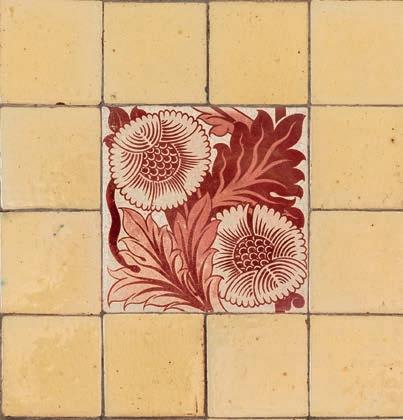
Tile revival
The great period of English tilemaking dates to the medieval times when encaustic tiles were used on the flooring of cathedrals and monastic buildings. But almost all tilemaking ended with the Reformation with many tiled floors boarded over.
Tiles came back into vogue in a modest way in the 1830s as part of the general revival in church building. In the 1840s A.W.N. Pugin introduced colour-printed tiles in his decoration of the smoking room of the new House of Commons.
By the 1860s Victorian interiors offered a multitude of options for decorative tiles from hallways to new ‘modern’ bathrooms and kitchens. Domestic coal-burning grates was an evergrowing industry through the 19th century with the earlier metal grates replaced in the later half of the century with tiles. Industrial developments also made possible the production of tiles in numbers.
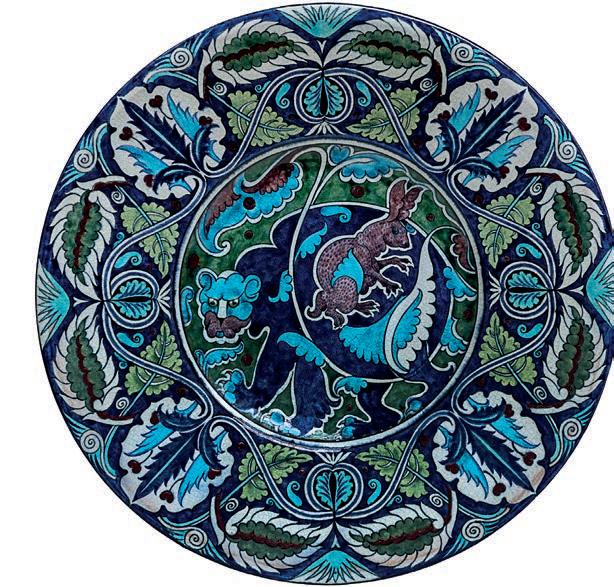
ANTIQUE COLLECTING 27
COLLECTING GUIDES William De Morgan ceramics

previous lodgings had been burnt down due to his ring experiments, making him perhaps not the most popular tenant. He stayed in Cheyne Row for 10 years even expanding up the road to number 36 were he arranged both a workshop and showroom for his growing clientele. It is from this Chelsea period that the majority of his tile designs originate.
Popular designs
e arts and crafts ideology he was exposed to through his friendship with Morris and his own insistent curiosity, led De Morgan to begin to explore every technical aspect of his craft. As well as an abundance of oral patterns he increasingly made use of birds and animals as well as mythical beasts. e tiles themselves, as well as 14in rice dishes, were initially bought as blanks from factories like Wedgwood. Later De Morgan would go on to produce his own pottery.
De Morgan cleverly creating intricate repeating patterns which could be used to great e ect. Some of his early designs from this period became hugely popular and were in production for almost 30 years, such as Bedford Park Daisy and BBB – named after the Norwich ironmonger Barnard, Bishop and Barnard, who sold the tiles as part of their cast-iron replaces. His inventive
streak lured him into complex studies of the chemistry of glazes, methods of ring, and pattern transfer.
Towards the latter part of the 1870s, De Morgan became more aware of the fantastic inspiration from the Middle East. e South Kensington Museum (now the V&A) had a good collection of Islamic pieces, including pottery which both De Morgan and Morris studied with great
e in uence of Middle Eastern designs was not new (Owen Jones had referred to them as early as 1856 in his Grammar of Ornament
But around 1873–1874, De Morgan made a striking breakthrough by rediscovering the technique of lustre ware (characterised by a re ective, metallic surface) found in HispanoMoresque pottery and Italian majolica. Nor was his interest in the East limited to glazing techniques, but it permeated his notions of design and colour, as well. As early as 1875, he began to work in earnest with a Persian palette: dark blue, turquoise, manganese purple, green, sealing wax red, and lemon yellow. ese ‘Persian’ pieces continued to be produced alongside the lustre ware for the rest of
Move to Merton Abbey

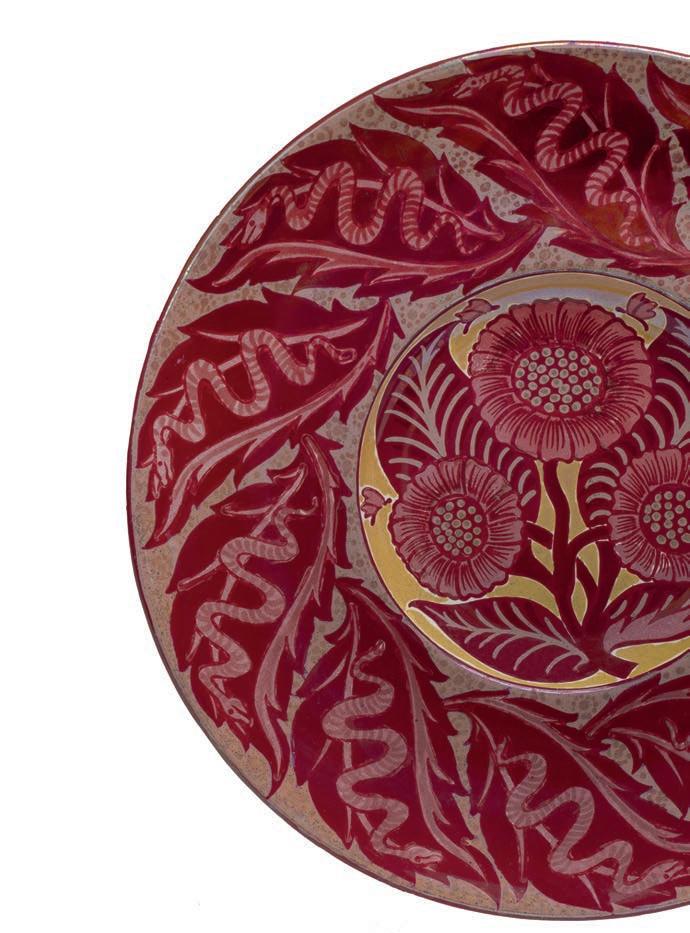
28 ANTIQUE COLLECTING
Above William De Morgan (1839-1917)
ruby lustre dish, c. 1880, credit De Morgan Foundation
Right William De Morgan (1839-1917)
Daisy and Snake 1890, credit De Morgan Foundation


was also joined by Reginald ompson who, apart from contributing to the design process, is thought to have invested in the pottery.
By 1882, De Morgan’s business had outgrown its Chelsea premises and was moved to Surrey. e Merton Abbey site was considerably larger and also closer to William Morris’ textile workshop which had recently opened there. At Merton Abbey De Morgan had the opportunity to design and have built customised kilns to suit his continuing glazing and ring experiments. e expansion also permitted him to manufacture pottery on site rather than buying blanks, consequently he started to design his own pieces and to pay greater attention to the relationship between
De Morgan marks
Although far from all De Morgan’s pottery is marked, there is a range of markings that can help to date it. Some pieces, although not bearing a De Morgan mark, have the initials of one of the Passenger brothers, this normally indicates a well painted piece, thus serving as a quality control measure. Other initials include J.J. for Joe Juster, H.R. for Halsey Ricardo and E.P. for Edward Porter.
As with all hand-crafted items there are varying degrees of quality in De Morgan’s pottery.
Due to the sensitivity of the glaze components and the unreliability of the firing process some pieces look crisp and well defined whereas on others the glaze may have run or misfired.
The lustre pieces are the most sensitive to firing temperatures and pieces can come out too dark or lacking in definition.

His throwers then manufactured each piece to his speci cation. e move to self-produced pottery meant that De Morgan was not con ned to the tiles and dishes used during the Chelsea period.
In fact not many of the tile designs made during the Merton Abbey period continued. Instead, a wide range of vases and bowls were produced, many in the Persian colours. e designs from this period tended to be bolder but also more successful with a greater harmony between the pattern and the piece on which it was painted.
‘Towards the latter part of the 1870s, De Morgan became more aware of the fantastic inspiration from the Middle East. The South Kensington Museum (now the V&A) had a good selection of Islamic pieces which both De Morgan and WIlliam Morris studied’
ANTIQUE COLLECTING 29
ruby lustre dish, c. 1890, credit De Morgan Foundation
Right A ceramic plate, c. 1890–1907, from the Sands End pottery, signed by Charles Passenger, credit Metropolitan Museum of Art (not in exhibition)
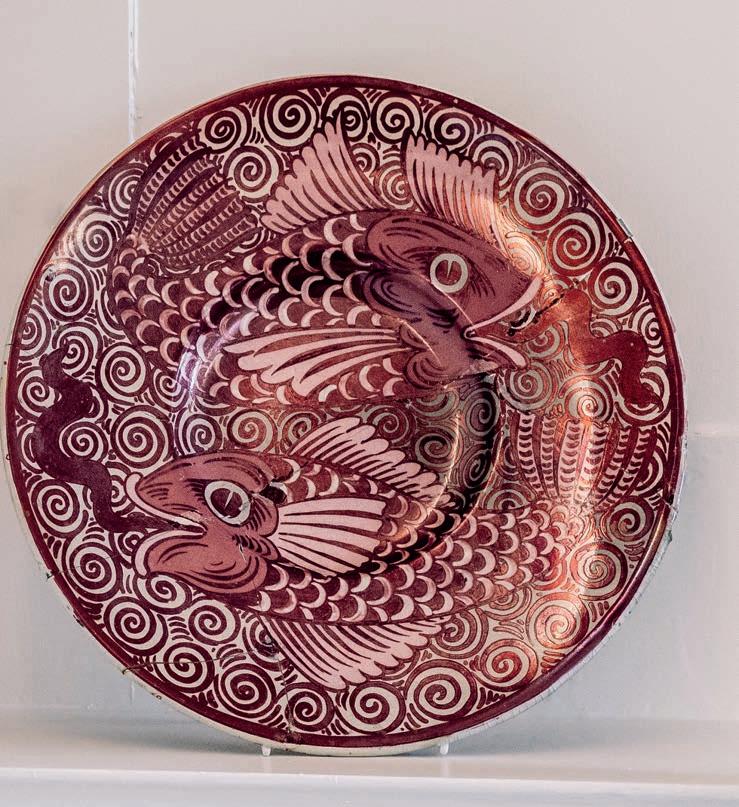
Several techniques were used to apply designs to tiles and vessels, the three main being pouncing, the painted paper technique and painting straight onto the ware. Pouncing was a fairly lengthy process. The finished design was copied onto tracing paper, after which the outline was pierced with tiny pin pricks. The paper was then placed on slip-coated ware and dusted with a fine powder. The powder penetrated the tiny holes and, when the paper was lifted, the pattern was left on the ware, ready to be filled with coloured pigments.
The painted paper technique was more economical and tended to be used for tiles which needed to be produced in large numbers. Again the design was copied onto tracing paper, this time in thick ink outlines.
The copied design was fixed to a sheet of glass which then served as the master copy. On the other side of the glass another sheet of paper was fixed and, by lighting the glass behind, the master copy would shine through and provide the outline within which the painter could then apply the colour pigments.
This painted sheet was then placed face down on the skip-coated ware and fixed with sodium silicate after which is was it was sprinkled with powdered glaze. It was then fired during which the paper burnt away and the pigments fused with the glaze, thus transferring the pattern to the ware.
The drawback of the printed paper technique was that it could only be used on flat surfaces. On vases and bowls the designs had to be transferred either by pouncing or painting directly onto the ware, with the latter supervised by De Morgan.
Marriage to Evelyn
Unfortunately, De Morgan su ered from ill health and by the mid 1880s found it increasingly tiring to commute to Surrey. In 1888, he opened a studio closer to home in Sands End, Fulham.
e pottery was beset by nancial problems, despite repeated cash injections from his wife, the pre-Raphaelite painter Evelyn De Morgan (née Pickering) whom he married in 1887. Here he was joined by a new partner the architect Halsey Ricardo, with whom he worked on several large projects including Peacock House as well as important commissions for a series of tile patterns for P&O Line.

e Fulham period is considered De Morgan’s best and is certainly the most proli c. He mastered many of the technical aspects of his work that had previously been elusive, including complex lustres and deep, intense underglaze painting that did not run during ring.
One of the best-known portraits of De Morgan painted by his wife Evelyn, shows him holding a stunning lustre vase widely acknowledged to be his crowning triumph. In 1919 the vase was bequeathed by Evelyn to the V&A.
Pots to books
However the period was also marred with increasing problems. De Morgan’s health continued to decline and, to relieve his symptoms, he opted to spend the winter months in Florence. is naturally put increasing pressure on Ricardo even though De Morgan did his best to supervise output and provide ready-to-use patterns from Italy.
It was an ine cient system and the business began to su er, Ricardo left and De Morgan entered into a partnership with the Passenger brothers and his kiln master Frank Iles. is was to last until 1907 when De Morgan withdrew from the business.
Late in life he turned his hand to writing novels, and became better known for these than he ever had been for his pottery. His rst novel, Joseph Vance, was published in 1906, and was an instant sensation in both the UK and US. is was followed by An A air of Dishonour, Alice-forShort and It Never Can Happen Again. He died in 1917 and was buried in Brookwood Cemetery.
Featuring some 60 tiles and vases from the De Morgan Collection and pieces from the Lakeland Arts collection, Sublime Symmetry: William De Morgan is on at Blackwell, the Arts & Crafts House, Bowness-onWindermere, Cumbria, LA23 3JT until October 6. For more details go to www.blackwell.org.uk
‘The record for a single De Morgan tile was set at the Salisbury-based auction house Woolley and Wallis in 2012, when an unusual 15.5cm square blue-and-white tile of a kingfisher eating a fish, expected to make £500-£800 sold for £6,300’
30 ANTIQUE COLLECTING
Above left William De Morgan (1839-1917) Fish charger, credit Robin Zahler Photography
Above right Evelyn De Morgan (1855-1919) William De Morgan, oil on canvas, 1909, public domain (not in exhibition)
COLLECTING GUIDES William De Morgan ceramics
De Morgan at auction
As with many examples of decorative arts, prices for De Morgan pottery reached a high level in the late 1980s and early 1990s but then dropped dramatically. Since then prices have continued to rise with most achieving sums far greater than their guide prices.
Christie’s set an auction record for a William De Morgan faience vase on May 25, 2022, when it sold for £65,000 (against an estimate of £15,000-£25,000). Standing 15in (39cm) high and dating from the sought-after Sands End period, the vase, c.1888-1997, was painted by leading factory decorator Fred Passenger and depicted three stylised peacocks and Persian-style manganese carnations against a dark blue ground.
e labels and signature of Fred Passenger were present on the base of the vase, along with a label suggesting it was o ered for sale at the time with a price tag of £45.
It came from the collection of the banker and connoisseur collector Sir Nicholas Goodison (1934-2021) one time chairman of the Stock Exchange and the TSB Group from 1988-1995.
Tiles better

De Morgan iers
For the canny collector, it would appear misattributed De Morgan tiles do still appear. In 2021, a US-based reader of Antique Collecting magazine, who spotted the tile he used to keep his pills on as the work of De Morgan, consigned it for sale with Woolley and Wallis. e Fulham period tile of a long-clawed bird, which he had bought for $10, was expected to make £1,000 but sold for £3,500.
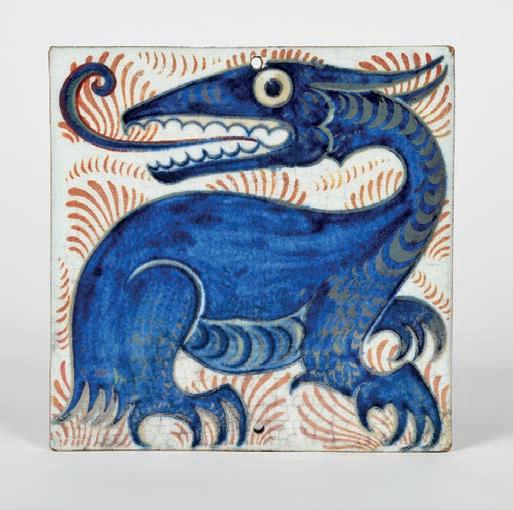
De Morgan’s tiles continue to attract interest when they appear in salerooms around the world. Last June an Iznik tile panel realised $15,120, three times its low estimate of $5,000 at Christie’s New York.
e well-known motif is recorded as having been designed prior to 1888, the year in which De Morgan and Halsey Ricardo entered into partnership at the Sands End Pottery in Fulham.
e record for a single tile was set at Salisbury-based auction house Woolley and Wallis in 2012, when an unusual 15.5cm square blue-and-white tile of a king sher catching a sh, expected to make £500-£800 sold for an impressive £6,300.
In 2019, the London auctioneer Roseberys sold four Galleon tiles, each valued at £500-£800, for a combined total of £4,200. e tiles dated from 1888-1898 and the Sands End factory in Fulham which represented the apogee of De Morgan production.
In June of the same year, a tile bought at a Devon market for just £8 sold at the same Wiltshire auction house for £4,750 – more than four times its low estimate of £1,000. Described as a “Cornish tile” at the market, the vendor recognised the 15cm square tile as unmistakeably the work of De Morgan.
‘The Fulham period is considered De Morgan’s best and it is certainly the most prolific. He mastered many of the technical aspects of his work, including complex lustres and deep, intense underglaze painting’
Above A William De Morgan faience vase sold for £65,000 in 2022, image courtesy of Christie’s
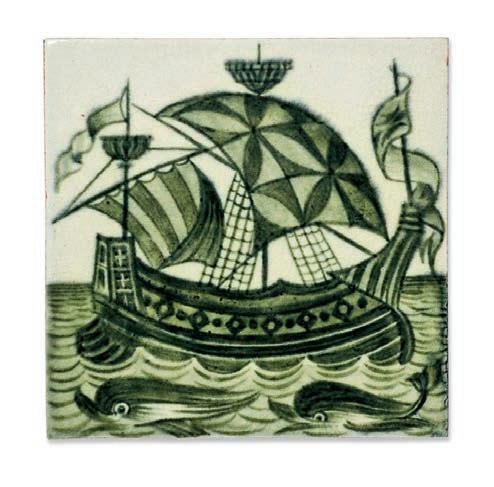
Above right Antique Collecting reader Barry Anderson consigned his tile for sale, image courtesy of Woolley and Wallis
Left One of four Galleon tiles, each valued at £500-£800, which sold for a combined total of £4,200, image courtesy of Roseberys
Right An Iznik panel realised $15,120 in 2023, three times its low estimate of $5,000, image courtesy of Christie’s New York
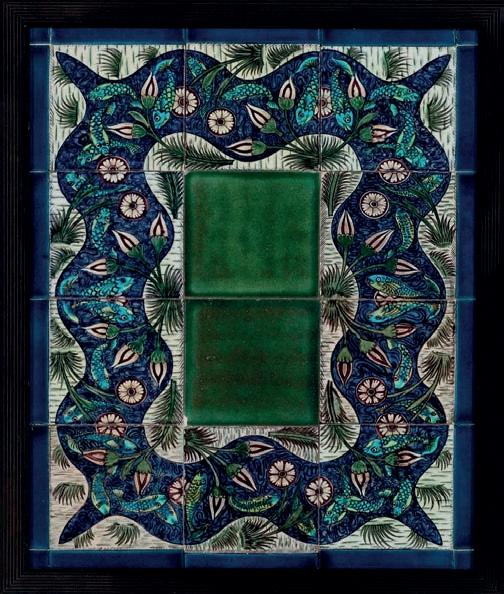
ANTIQUE COLLECTING 31
LOTS of LOVE

Maundy money given by the reigning monarch to the needy for centuries is a wonderful area of coin collecting, writes Irita Marriott
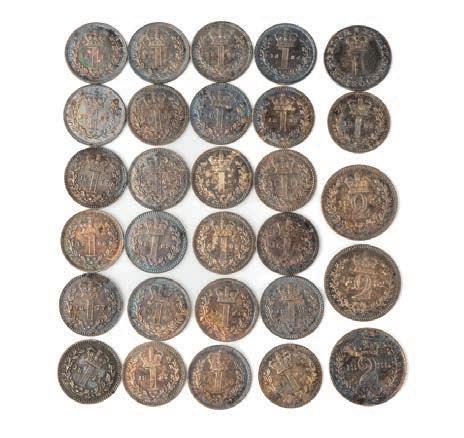
IGeorge V
Choosing the worthy recipients of the money was not easy. In 1921, the verger at Westminster Abbey, during the reign of George V, wrote: “Among the applicants this year are a doctor’s daughter who is now a caretaker, a solicitor, a governess, a librarian, the one-time proprietress of a laundry, and a builder.
“Practically every case is one of real distress, and as the King is now 56 we have chosen 56 men and 56 women from the worst cases to receive the Maundy gifts.”
It seems, even then collectors were keen to get their hands on the purses. e verger continues: “Americans are very keen on getting as souvenirs the little bags with long red leather strings in which the coins are put. Often on Maundy ursday you will see them waiting outside the Abbey to try to persuade the recipients to part with the bags for suitable remuneration.”
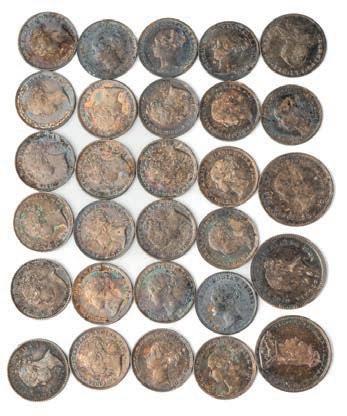
n Latvia we call Easter “Lieldienas” which translates as “big days” referring to the start of spring and the longer daylight hours. As you might expect we have a lot of traditions associated with it, from building a swing (the higher you swung, the higher the sun would rise) to rolling decorated eggs. Of course all countries have their traditions and one I love in this country is that of the Maundy ceremony. With its emphasis on humanity, service and charity, it is a good reminder to think of others as we sink into the gluttonous chocolate fest.
Feet washing
e rst recorded participation of an English monarch in the ceremony, which takes place on Maundy ursday, the day before Good Friday, was King John in 1210, where he gave alms to the poor of Knaresborough, Yorkshire.
While early monarchs continued to imitate the actions of Christ by washing the feet of his subjects, the tradition was ended by Charles II on the outbreak of the plague. Hence, he became the rst monarch to issue speciallystruck Maundy Money, made up of undated one pence, two pence, three pence and four pence coins. e tradition goes on, the number of recipients corresponding to the age of the monarch. So expect King Charles III, health permitting, to present 75 men and women with Maundy money this year.
Above A selection of one and two pences from the 1880s, the reign of Queen Victoria, sold recently for £400
Below right A one, two and four pence from 1886, the reign of Queen Victoria, sold for £40
Mint o cials
Until 1817 the coins came from the circulating coinage, and it was not until the latter half of the century that the four Maundy coins developed as distinct pieces. It is given in two leather purses, a white one containing coins to the value of the monarch’s age, and a red purse containing two commemorative coins.
With so few Maundy coins struck each year, and their recipients naturally keen to hold on to them, when they do appear on the market, they are always highly sought after. In most years there are fewer than 2,000 complete sets meaning they are highly sought after by collectors.
e resale of Maundy money became so great in the 1960s that the Mint began restricting the production of the sets. Today only a few special sets are available to Mint sta and o cials, beyond those gifted to recipients in the Royal Maundy ceremony.
Of course there were some who spent it as it is real currency. And then there are those who used the three pence as the sixpence in the Christmas pudding meaning that is the rarest of the Maundy money set.
If you fancy given an unusual Easter gift this year, Maundy money might just t the bill.
Irita Marriott is an expert on a number of TV programmes including Antiques Road Trip, Celebrity Antiques Road Trip and Bargain Hunt. She also owns her own auction house in Derbyshire, for more details and sale dates go to www.iritamarriottauctioneers.co.uk

‘With so few Maundy coins struck each year, and their recipients naturally keen to hold on to them, when they do appear on the market, they are always highly sought after. In most years there are fewer than 2,000 complete sets’
32 ANTIQUE COLLECTING
EXPERT COMMENT Irita Marriott
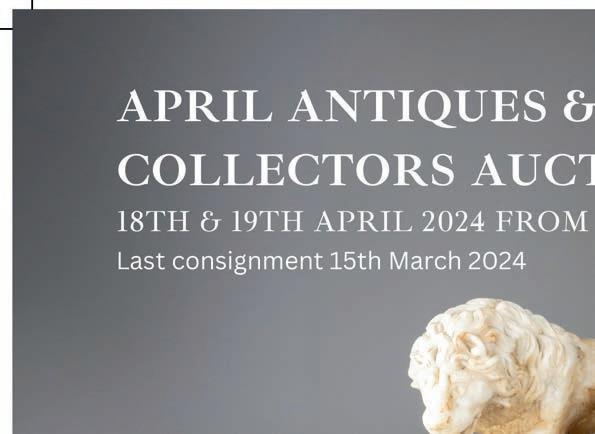

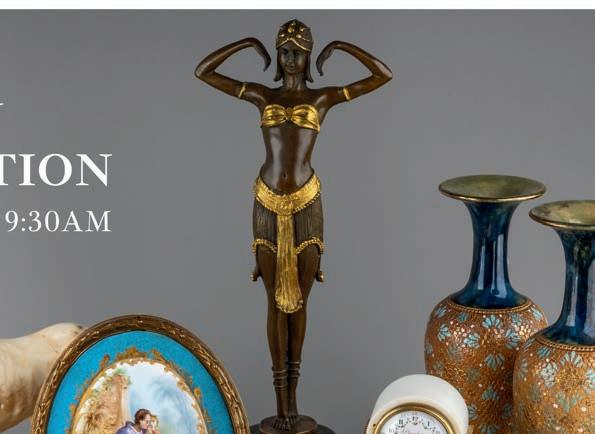



Enjoy a generous up to 10% discount on all our specialised packing and shipping services at Pack & Send - Oxford Circus. Our comprehensive services include: • Custom Packaging • Door-to-Door Worldwide Delivery • Loss & Damage Warranty Coverage • Professional Secure Handling • Documentation and Customs Clearance For a free consultation and estimate, call: +44 (0)203 435 9415 email: oxfordcircus@packsend.co.uk www.packsend.co.uk/oxfordcircus Bespoke Packing & Shipping of Antiques and Fine Arts Quote discount code: OXC001ATC “Shipped high value artwork. Packaging was immaculate and delivery could not be more punctual. Thank you!” by Hadi H ★ ★ ★ ★ ★ ANTIQUE COLLECTING 33
GUIDES Jean-Marie Toulgouat

Making an Impression
While a painting by Claude Monet sold for £14m last month, works by his great grandson (by marriage) Jean-Marie Toulgouat – described as ‘the last remaining link with Giverny’ – can be snapped up for a few thousand. With two ongoing exhibitions of his work, Antique Collecting re ects on his art
While their antecedence may be somewhat complicated – Jean-Marie Toulgouat’s mother was the granddaughter of Claude Monet’s second wife – what the two artists lacked in bloodline was made up in their devotion to Giverney – the magical Normandy house and garden 50 miles to the northwest of Paris where Monet lived from 1883 until his death in 1926.
And it was at Giverney in 1928, just two years after Monet’s death, Jean-Marie Toulgouat was born, his playground soon becoming the artist’s former home. At the time there were more than 300 works by Monet still at Giverny – as well as the artist’s private collection of works by his friends: paintings and drawing by Pissarro, Manet, Cézanne and Renoir. In an interview, Toulgouat said: “It was an extraordinary environment in which to grow up, but I took it all for granted.”
When Toulgouat died in 2006 his obituary in e Telegraph would describe him as ‘the last remaining link with Claude Monet at Giverny.’ is month, two exhibitions showcase Toulgouat’s talents as a painter: one of his rediscovered works at David Messum’s gallery in London; the other a selling exhibition at the Garden Museum in Lambeth, showcasing 50 works exploring his life as an artist-gardener.
Jean-Marie Toulgouat
Giverny needs little introduction to anyone interested in the history of European art. e gardens Monet created included the ponds of water lilies and the Japanese bridge. e pictures he painted of both are among the most famous in the world.
For Monet, the elongated house, clad in pink plaster with green shutters, provided an ideal environment for his creativity. It was large enough to accommodate his extended family, made up of the six children of his partner Alice Hoschedé (whom he married in 1892) and his own two sons, Jean and Michel. For years prior to the move Monet had struggled to establish his artwork, after periods of poverty, scathing criticism and family dramas, with his rst wife Camille dying in 1879.

34 ANTIQUE COLLECTING
COLLECTING
Above Jean-Marie Toulgouat (1927–2006) L’Envers de la Frontière, 1979, oil on canvas, image courtesy of David Messum Fine Art (on show at the gallery until April 4)
Right Jean-Marie Toulgouat (1927–2006) Les Hemerocalles, courtesy of David Messum Fine Art (on show at the gallery until April 4)

On April 29, 1883, Monet moved to Giverny, one day before the death of his friend Manet. His passion for plants was evident from the start, soon blossoming quite literally into a unique and magical garden.
Artistic pilgrimage
Monet’s closest friends, including Camille Pissarro, Paul Cézanne, Auguste Rodin and John Singer Sargent, would take the train or drive from Paris to spend the day in Giverny. Also making the trip were a number of admirers including the American painter eodore Butler (18611936) who, in 1892, married Suzanne Hoschedé the daughter of Monet’s wife, Alice.
e couple settled in Giverny where they lived until Butler’s death in 1936. It was their daughter Lilly Butler, who became a fashion designer for Harper’s Bazaar and married Roger Toulgouat, who gave birth to Jean-Marie Toulgouat in 1927, nine months after Monet’s death.
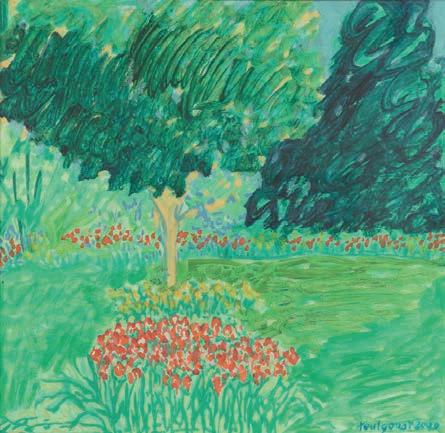
MONET AND GIVERNY
With the ink still wet after signing the lease on Giverny in 1883, even before he started painting, Monet started work on the gardens claiming he “should like to grow some flowers in order to be able to paint in bad weather as well.”
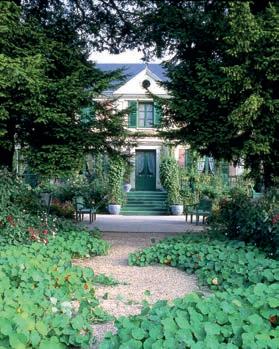
Above Jean-Marie Toulgouat (1927–2006) Jacinthes des Bois dans un Paysage Boisé comme Cézanne, 1967, oil on canvas, courtesy of David Messum Fine Art (on show at the gallery until April 4)
Above right e house at Giverny © Andrew Lawson (on show at the Garden Museum until April 24)
Below left Jean-Marie Toulgouat (1927–2006) Le Printemps à Giverny, 2000, courtesy David Messum Fine Art (on display at the Garden Museum until April 24)
Below right Monet’s Garden, Giverny © Andrew Lawson (on show at the Garden Museum until April 24)
‘Growing up just around the corner from Monet’s home and garden, Toulgouat was born into an artistic world and when, at the age of seven, he took up a paintbrush, it was to his great-aunt, the painter Blanche Hoschedé-Monet he turned’
In fact flowers had long been important to the artist, who famously said late in life: “Perhaps flowers were the reason why I became a painter.”
Monet did not like organised gardens preferring instead to let them grow freely, marrying flowers according to their colours and mixing the simplest flowers (daisies and poppies) with rare varieties.
In 1893, 10 years after his arrival at Giverny, Monet bought a piece of land neighbouring his property on the other side of a railway.
Japanese garden
After obtaining permission from the Eure Prefecture to divert a branch of the river Epte, to create ponds, he set the scene for one of the most famous landscapes ever depicted.
Using the diverted watercourse Monet designed his garden and flowerbeds draped with willows and inspired by the Japanese gardens he knew so well from the prints he collected.
The garden went on to include the famous Japanese bridge covered with wisterias, other smaller bridges, weeping willows, a bamboo wood and the famous nympheas.
An increasingly famous and wealthy man, Monet was able to afford the employment of six gardeners to manage the grounds, the pond and the plants. The effect he aimed to achieve was what he called, in a letter to a friend, “instantaneity ... in particular, the atmospheric envelope and the same light diffused over everything.”

ANTIQUE COLLECTING 35
COLLECTING GUIDES Jean-Marie Toulgouat

Growing up just around the corner from Monet’s home and garden, he was born into an artistic world and when, at the age of seven he took up a paintbrush it was to his great-aunt, Blanche Hoschedé-Monet he turned. From the years 1939 to 1946, Blanche – who, as his step daughter, ran Monet’s house after his wife had died in 1911 – was Toulgouat’s sole guardian.
Talented tutor
And when it came to a tutor he chose well. Blanche, herself a painter, was the only person Monet, who admired her talent, ever advised on art. In turn she passed on his wisdom to the young Toulgouat telling him exactly the colours he should use. (During WWII when everything was scarce, not least oil paints, she even gave her greatnephew some of Monet’s remaining tubes.) Toulgouat’s American artist grandfather also pitched in for lessons, making him a small easel at the age of six.

Left Jean-Marie Toulgouat (1927–2006) Dahlias Etoile, 2004, courtesy David Messum Fine Art (on display at the Garden Museum until April 24)
Below left Jean-Marie Toulgouat (1927–2006) Pres de l’Orangerie à Manotte, 1989, courtesy David Messum Fine Art (on display at the Garden Museum until April 24)
Below right Jean-Marie Toulgouat (1927–2006)
Les Iris Mauves, 2001, oil on canvas, courtesy David Messum Fine Art (on show at the gallery until April 4)
Toulgouat’s playground now extended to the worldfamous gardens and the banks of the Seine, where, one day, he and a friend decided to build a canoe. When they ran out of wood, whether by accident or design, Toulgouat got his hands on a pile of old canvases, which were actually works that Monet had abandoned with the expectation that they be burned.
Return to Giverney
Painting as a career was, however, something Toulgouat initially resisted. When he left Giverny in 1947 to begin his adult studies he went to Nice, rst to study classical drawing at a provincial art academy, then architecture at the University of Paris.
For 16 years he practised landscape architecture in Paris, designing municipal parks and gardens. But when he reached the age of 40, Toulgouat began laying plans to leave his home in Paris’ Latin Quarter and return to Giverny to do what he was meant to do. In 1964, selling the only original work by Monet he possessed, he returned to Giverny with the art historian Claire Joyes as his wife.
After Monet’s death, the house and garden had fallen fell into disrepair. Claire Joyes recalled the rst time she entered Monet’s long-neglected home: “ e walls were damp but the house tidy. Viewed from the gate, the garden simply consisted of lawns. ere was no structure at all and the owerbeds were not planted. e biggest problem? e big water lilies studio where a volleyball net had been installed!’
Restoring the gardens
In 1966, Monet’s only surviving son, Michel, died aged 88 without an heir. It transpired that he had bequeathed his father’s entire estate to the Académie des beaux-arts.
Monet’s collection of paintings was shipped to Paris, and a campaign began to restore the neglected gardens.
Not only had Toulgouat worked as an architect and landscape designer in Paris, he was the the closest living link to how the gardens had looked in Monet’s lifetime. With the help of his uncle, James Butler, the pair embarked on restoring the boarders and plantings to Monet’s original design, supported by Gérald Van der Kemp, who was engaged by the Institut de France to direct the restoration. ey used a mixture of Toulgouat’s childhood recollections, old planting records, photographs and even Monet’s paintings as their guide.
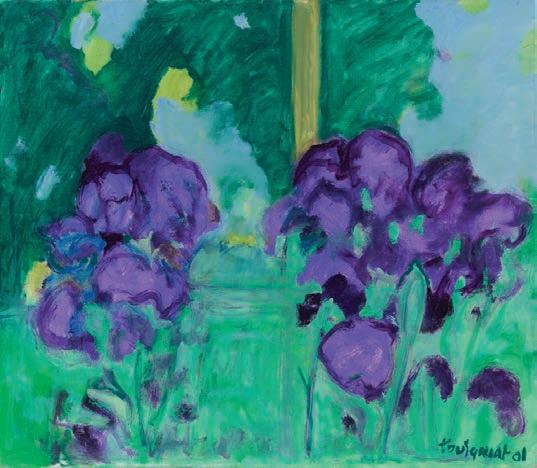
36 ANTIQUE COLLECTING

Artist gardener

roughout the process of regrowth Toulgouat painted Giverny and its surrounding neighbourhood, just as Monet had done: the owers, the woods and the trees and the pond. To some artists, this might have seemed a daunting prospect, with Giverny so closely associated with Monet’s name. (An article in e Times during an exhibition of Toulgouat’s work in London in 1999 would call him ‘Monsieur Monet, junior,’ while a BBC News article bore the title, ‘Shining Light inMonet’s shadow’).
As well as documenting Giverny, Toulgouat also painted his own nearby cottage and gardens, where he and his wife planted poppies, cosmos and nasturtiums.
He also painted in his summer home, La Manotte, in the south of France, as well asin Atlanta, Georgia in the USA, where he was a frequent visitor.
Like Monet
Like his famous forebear, Toulgouat’s paintings are impressions but they are more modern, mixing bold and pastel colours in a restricted palette. David Messum, whose gallery owns the artist’s estate, said: “While his early works veered towards abstraction, he soon developed a mature style in which we always know that we are dealing with landscapes and gardens.”
He continued: “Whilst themore abstract and linear constructions of the 1960s bely histraining as an architect, focusing on thestructure of the enclosed spaces of Giverny, his re ections series of a decade later provide an accent ofthe palette of the gardens throughout the seasons. ese spatially ambiguous canvases depict the dance of colours on the water’s surface reminiscent of those captured in Monet’s famous Water Lilies series.”
In the1980s the work became looser and more vibrant, he added, re ecting the, by then, more mature gardens of Manotte.
Critical success
e late art critic Brian Sewell was an admirer of Toulgouat’s work. In 1987, he wrote: ‘Often the pictures work both as a sea ofcolour and as an organised pictorial distance, asbright abstraction and the reality of summer heat. Nothing is left to accident orserendipitous disorder – the limited palette and the underlying discipline of the technique ensure that the e ects are precisely predictable, and that no picture expresses more or less than Toulgouat intended, in spite of the impressions of breath, speed and spontaneity implied in the handling ... e inheritance from Claude Monet is unmistakable.”
Toulgouat for sale

Above left Jean-Marie Toulgouat (1927–2006) Couleurs de l’Automne, I, oil on paper, courtesy of David Messum Fine Art (on show at the gallery until April 4)
Above Jean-Marie Toulgouat (1927–2006) L’Automne au Bassin, 1998, courtesy David Messum Fine Art (on display at the Garden Museum until April 24)
Above right Jean-Marie Toulgouat (1927–2006) Automne à Giverny gouache on board, on sale for £3,850 at the selling exhibition at the Garden Museum
Below right Jean-Marie Toulgouat (1927–2006) Bordure d’Été aux Artichauts, 1979, courtesy David Messum Fine Art (on show at the gallery until April 4)
While Monet’s work can sell for millions, paintings by Jean-Marie Toulgouat can be snapped up for thousands. A smaller gouache on board may come it at less than £4,000, with an oil on canvas or board on offer for anything from £6,000-£18,000. i , DavidMessum in , said: “ any of Toulgouat’s workson paper i n accessible to the average collector i ing anaffordable link to the French Impressionists.”But despite Toulgouat’s links to Monet, he was a pains to distance himself from the movement declaring: “I was born one century too late.” For Toulgouat it was the abstract expressionists ofthe1950s who proved his greatest influence.
His e orts were successful and Toulgouat enjoyed considerable recognition in his lifetime, both in France and abroad. On his death in January 2006 obituaries appeared in all the major British newspapers.
As the works on show this month reveal, Toulgouat is a talent to be reckoned with.
Jean-Marie Toulgouat (1927–2006) Rediscovered Works from the Studio Estate continues at David Messum’s until April 4, while Jean-Marie Toulgouat: Gardening Giverny is on at the Garden Museum, Lambeth Palace Road, London SE1 7LB until April 24.

ANTIQUE COLLECTING 37
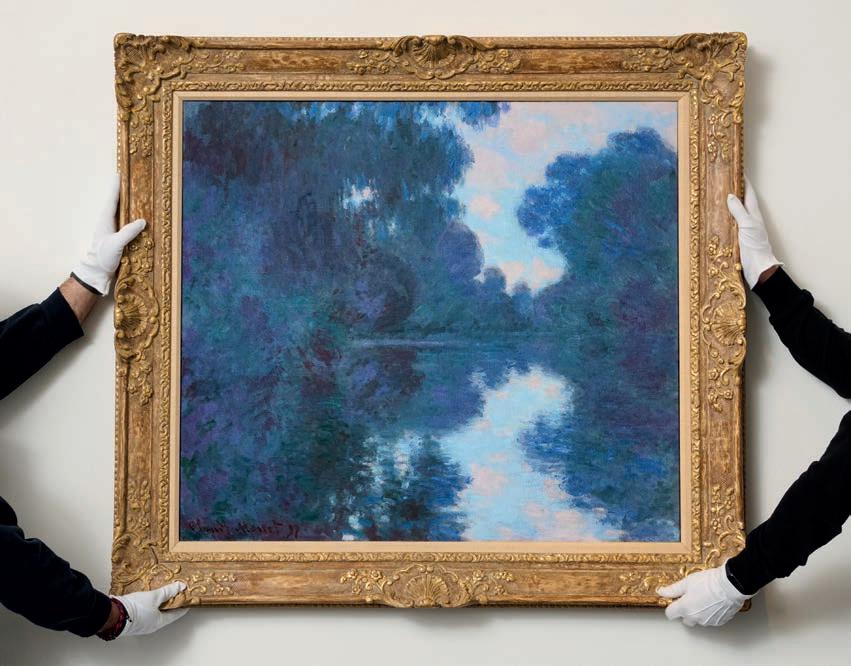
On the Monet
Last month Claude Monet’s Matinée sur la Seine, capturing a eeting moment on the river close to Giverny, sold for £14m
Marking both the 150th anniversary of Impressionsim and the rst time the painting had been seen at auction for 45 years, Monet’s painting, one of the artist’s famous series, captured a tranquil moment on the Seine.
ere were 22 canvases in Monet’s Matinée sur la Seine series, which record the early-morning light on a tranquil arm of the river near the artist’s home in Giverny, during the summers of 1896 and 1897.
Most were painted from his at-bottomed bateauatelier tted with a notched frame that held the canvases upright. To keep them in order, he numbered them, placed them in grooves built into the boat, before handing them in order to the gardener whom he enlisted as his assistant.
As the light changed during the course of the morning, he quickly switched from one canvas to the next. Lilla Cabot Perry, an American painter who was Monet’s neighbour in Giverny, recalled the artist having explained to her that the e ect he was seeking “lasted only seven minutes, or until the sunlight left a certain leaf, when he
took out the next canvas and worked on that.”
Monet explained: “I am pursuing the impossible. Other painters paint a bridge, a house, a boat… I want to paint the air in which the bridge, the house, and the boat are to be found – the beauty of the air around them, and that is nothing less than the impossible.”
Disciplined regimen
By the time of Matinée sur la Seine Monet had already painted several extended sequences under changing light and in varying weather conditions, employing grain stacks, a row of poplars, and the façade of Rouen Cathedral as his motifs. While working on the Matinée sur le Seine canvases, he kept to a rigorous and disciplined regimen from rst to last. e journalist Maurice Guillemot, who visited and interviewed Monet during the summer of 1897, described the process that the artist undertook: “ e crack of dawn, in August, 3:30 a.m. His torso snug in a white woollen hand-knit, his feet in a pair of sturdy hunting boots with thick, dew-proof soles, his head covered by a picturesque, battered, brown felt hat, with the brim turned up to keep o the sun, a cigarette in his mouth...he pushes open the door, walks down the steps, follows the central path through his garden...and comes to the river.
“ ere he unties his rowboat moored in the reeds along the bank, and with a few strokes reaches the large punt at anchor which serves as his studio. e local man, a gardener’s helper, who accompanies him, unties the packages—as they called the stretched canvases joined in pairs and numbered—and the artist sets to work.”
e Matinée sur la Seine paintings represent one of two major serial undertakings that absorbed Monet almost completely in 1896-1897. e other, collectively titled Les Falaises, depicts the towering chalk cli s at Pourville, where the artist spent two successive winter seasons. Whereas the Falaises are expansive, windswept, and volatile, the Matinées sur la Seine are delicate, contained, and self-re ective.
‘Most were painted from his flat-bottomed bateau-atelier fitted with a notched frame that held the canvases upright. To keep them in order, he numbered them, placed them in grooves built into the boat, before handing them in order to the gardener whom he enlisted as his assistant’
38 ANTIQUE COLLECTING COLLECTING GUIDES Monet at Giverny
Above Claude Monet’s Matinée sur la Seine, 1897, estimated to sell for £12-£18m sold for £14m. Image courtesy of Christie’s



In the KNOWLES
Eric Knowles is in the pink after a cameo-cut glass vase by the French artist Émille Gallé came to light during a routine house visit



Ilove the arrival of spring and this small vase, with its splash of bold yellow, pink and oral decoration, encapsulates the joy of new life, nature and all things bright and beautiful.
It’s also an important antique. Decorative art is my forte so I was excited to learn about its discovery nestling in a cabinet during a routine home visit. Because this cameo-cut glass vase, dated c. 1900, bears the signature of the creative genius, French artist and designer Émille Gallé (1846-1904).
Gallé only lived for 58 years but he made an enormous impact with his talent nurtured through family businesses. His father, Charles Gallé, was a merchant of glassware and ceramics who settled in Nancy in 1844, while his father-inlaw owned a mirror factory. His father began to manufacture glassware with a oral design. He also took over a struggling faience factory.
Émille Gallé was an innovator in the industrial age when advances in science presented ever increasing possibilities in technology and materials. Noted for both his art nouveau glass art and furniture, he founded the École de Nancy (Nancy School) in 1901, a design movement in the French city of his birth.
Consequently, this small, crocus-inspired vase, measuring only 5in (13cm) high, is big on importance which is demonstrated by its £1,500 estimate in Hansons Auctioneers’ spring sale at its Derbyshire saleroom.
Love of nature
It demonstrates the importance of owers, colour and technical innovation in Gallé glass works, especially vases.
He was a dedicated botanist and, in this example, owers in varying degrees of bud and blossom curve upwards as if growing out from the base of the vase. Gallé
Above right e signature of Émille Gallé on the vase, image courtesy of Hansons
Far left Émille Gallé cameo-cut glass vase, c. 1900, which could fetch thousands this spring, image courtesy of Hansons
Left e vase is only 5in tall, image courtesy of Hansons
Below e renowned French glassmaker Émille Gallé
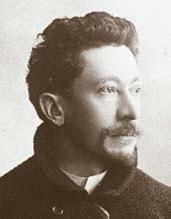
had an extensive ower garden as a source of models. He also required his artists to use plants as models. For him, owers had a strong symbolic appeal. In 1893, he wrote that, according to Saint Paul, each ower and fruit had its own symbolic meaning. e olive leaf is peace, wheat re ects charity and goodness, grapes are the symbol of the Eucharist, while the g signals generosity.
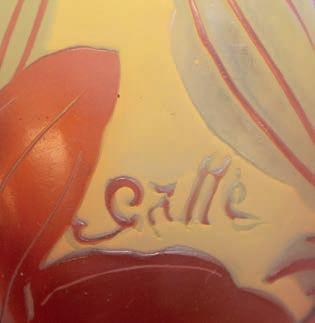
He also developed innovative techniques to showcase his love of nature, including cased glass and cameo glass. Cased glass was created by using heat to fuse together two layers of glass of di erent colours. is could be repeated for multiple layers of glass. Cameo glass was a means of decorating cased glass by using a diamond saw or etching it with acid. is allowed colours from the layer beneath to become visible. e quality of the etching is the most important factor to consider when determining value. e recent vase features these techniques with the yellow-bodied glass having a blue and pinkish layer over it. Gallé has cut away the top surfaces of the pink and blue to reveal the yellow ground, in turn creating a oral design.
Colour palette
As early as 1878 Gallé coloured glass with a small quantity of cobalt oxide to make a delicate sapphire tone which he called Clair de lune or Moonlight
He sometimes covered this with a glaze of cobalt blue, a technique which was widely imitated by other glassmakers, particularly in Germany and England.
However, his most original and characteristic colours were a deep violet made with manganese, a pink made with selenium or copper, which he created in 1889, and a green made with chromium, which he used to case pieces in three or four layers, giving a depth of colour.
Some of his early glass and faience works for the family factory at Saint-Clémont were displayed at the 1867 Paris Universal Exposition. At the Paris exhibition of 1878 Gallé won the Grand Prix, gaining recognition for his exquisitely decorated glass. He was also awarded a gold medal at the 1900 Paris exhibition. He left an indelible mark in the history of decorative glass.
Redolent of the summer sun, I can only imagine the joy the vase will give to its new owners.
As well as appearing in a number of TV programmes, Eric Knowles is a consultant valuer for Hansons Auctioneers, for more details go to www.hansonsauctioneers.co.uk
‘Gallé was a dedicated botanist and, in this example, flowers in varying degrees of bud and blossom curve upwards as if growing out from the base of the vase’
ANTIQUE COLLECTING 39
EXPERT COMMENT Eric Knowles
TEST YOUR KNOWLEDGE
Puzzle TIME

Peter Wade-Wright
APRIL QUIZ

Q1 Scumbling is a technique for…(a) rounding wooden edges, (b) softening areas in paintings, (c) blunting glass tumbler rims, (d) slowing the rise in bids at auction.
Q2 If you owned a ‘mortuary’, would it be? (a) a taxidermy collection, (b) co n-shaped furniture, (c) a chair, (d) a macabre picture.
Q3 A ‘single scroll’ is (a) a handle shape, (b) central furniture decoration, (c) parchment only rolled one way, (d) a heavy-furniture carrier’s gait.
Q4 A variety of toby jug representing a seated gure holding a hat and lantern is called (a) a clerical jug (lantern representing the light of the world), (b) a homeward-bound toper jug, (c) a penitent, (d) a night-watchman.
Q5 A ‘unite’ is (a) a corn-dolly knotted wedding gift, (b) a washstand with two sinks, (c) a gold coin, (d) a loving-cup.
Q6 Who was omas Steele (c. 1772-1850)? (a) a much-painted Scottish politician, (b) a porcelain decorator for Derby, (c) a recipient of the Victoria Cross, (d) a celebrated entertainer.
Q7 A piggin is (a) an oversized Victorian tureen, (b) a large Edwardian dinner-plate, (c) WWI army-issue mess-tin (popular with the Pals Battalions), (d) a small milk pail.
Q8 A late 18th-century winebottle holder that stood (sometimes hidden) under a side table is known as a (a) cellaret, (b) diplomat, (c) suzette, (d) pantalette.
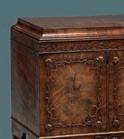




ink you know your rococo from your Regency? Pit your wits against our resident quiz editor




English, Scottish, Irish Silver & to
Send your answers to Crossword, Antique Collecting magazine, Riverside House, Dock Lane, Melton Woodbridge, Su olk, IP12 1PE. Photocopies are also acceptable, or email your answers to magazine@ accartbooks.com. e rst three opened by March 14 will win a copy of Jackson’s Hallmarks, Pocket Edition: English, Scottish, Irish Silver & Gold Marks From 1300 to the Present Day, worth £6.95.
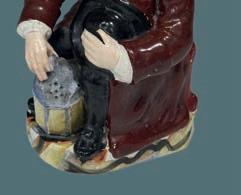
Q4 What is the name of this style of toby jug?

Anagram (d) is utensil is an anagram of a cold run
SOLUTION TO LAST MONTH’S CROSSWORD:
The letters in the highlighted squares could be rearranged to make the word mantlepiece. The three winners who will each receive a copy of the book are Sofia Wellman, by email; Jason Lee, Basingstoke and Miranda Grilli, Nantes, by email.
Q8 is type of wine holder is known as what?

Q9 e protuberance, on the stem of a drinking glass, called a ‘bullet knop’, is also known as (a) a cherry blob, (b) an olive button, (c) an orb, (d) a nger rest.
Q10 A line, or lines, of decorative inlay on furniture is known as (a) nings, (b) nishings, (c) stringing, (d) winding.
Finally here are four anagrams punk cowherd, Turk’s seabag, oven sins and a cold run Rearrange them to form, in order, (a) an elementary, primitive form of embossed metal e.g on 17th-century silver (two words), (b) a boatshaped container sometimes with a swing handle and glass liner (two words), (c) the name given to bowls of di erent capacities made to t into one another (plural.) (d) one of the oldest types of cooking utensils. For the answers turn to page 10
1 2 3 9 5 11 7 6 8 20 12 19 17 21 23 10 13 14 1516 18 22 4 24 25 26 27 40 ANTIQUE COLLECTING
BACO A DUM E A A G EB A ROC ER A T E H A SAS E ON E WN EM G UMA N O T LOW 0 BOEL L EE E BSE D N N E L ELT H O A SO C R G P H I T RY L O H S Y TA S A N
Across
1 Small, wooden shelf for bodily support, often beautifully carved, found under a church seat (anagram of micro rides). (10)
7 Harold ____ (1893-1971) American actor and silent-film maker. (5)
8 Hindu goddess (aka Parvati) and, as ____ Thurman (b. 1970) American actress with a Bill to settle. (3)
9 _____ nozzle etc. Cake-decorating utensil. The process for which it is used was introduced in the 17th century. (5)
11 (Alice) _____ Terry (1847-1928)
Leading English actress who famously corresponded with Bernard Shaw. (5)
13 Jawaharlal _____ (1889-1964)
India’s first prime minister who gave his name to a style of jacket. (5)

14 Description of the home exhibition first held at the Olympia, London, in 1908. (5)

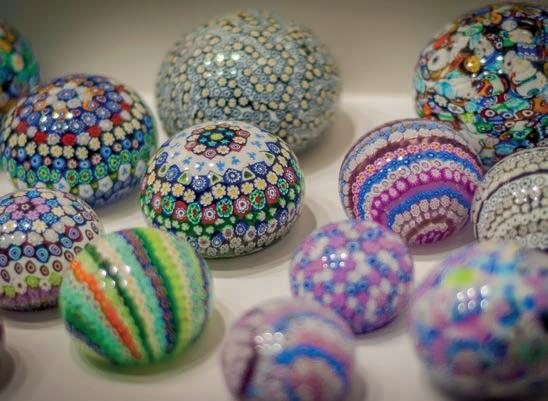
1
DOWN CLUE
18
DOWN CLUE

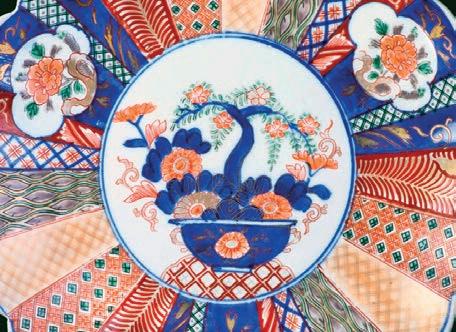
is style of Japanese porcelain is known as what?
21 Tropical fruit of the myrtle family. Not mentioned by Mrs Beeton in her Book of Garden Management but grown in England by Mary Capell (later 1st Duchess of Beaufort) in the 1660s. (5)
22 Writing desk with drawers and compartments (anagram of rioter’s ice). (10)

Which Indian prime minister gave his name to this style of jacket?
13 ACROSS CLUE
Down
1 Decorative glasswork of a thousand flowers. (10)
2 A seat without back or arms. (5)
3 Auguste _____ (1840-1917) French ‘founder’ of modern sculpture. (5)

4 Linked metal pieces for support, adornment, restraint etc. (5)
5 Not polished, smoothed or finished. (5)
6 Ornamental railing or parapet (anagram of arable dust). (10)
10 Undiluted or tidily finished. (4)

17 Pole structure for human or architectural elevation. (5)
19 Andrea _____ (c.1505-1577) Italian luthier credited with making the first violins (certainly with four strings rather than three). (5)
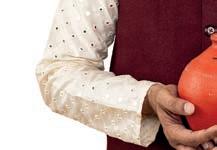

12 Dutch cheese with a red, waxy coating that prevents spoiling. (4)
15 Roof edges (pl.). (5)
16 Coating, cover or stratum. (5)
17 Weapon aiming device. (5)
18 Type of richly-decorated Japanese porcelain. (5)

Abbreviation for the
20 Abbreviation for the honorific of certain Christian clergy…sounds rotational. (3)





Finally, rearrange the letters in the highlighted squares to form the name of the lead glass developed by George ____ (1632-1683)


ANTIQUE COLLECTING 41
1 2 3 9 5 7 6 8 17 11 16 14 18 10 12 13 15 4 19 21 20 22
What is the name of this colourful glass?
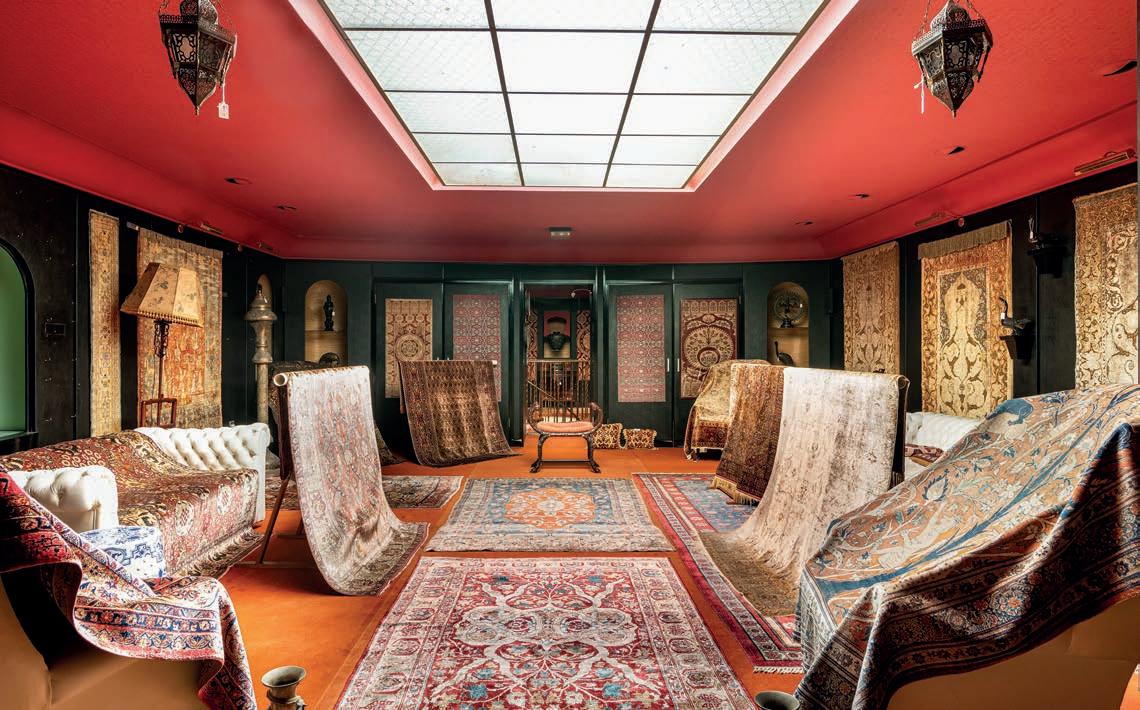
MAGIC CARPETS


ICollectors are known to embrace niche categories – none more so than George Farrow who championed the work of a small group of skilled Armenian weavers.
Louise Broadhurst reports
t may seem unlikely that George Farrow (19162001), born in the southeast of London to a workingclass family, would become a devotee of a coterie of Armenian weavers, active in the rst half of the 20th century. Yet, through determined collecting, indefatigable scholarship, and frequent correspondence, Farrow dedicated much of his life to preserving their memory and extolling their skill.
At the home which he shared with his wife, Anne, in Jersey, much of the wall and oor space was dedicated to the display of his impressive collection of more than a hundred rugs and carpets, including an impressive ‘museum’ in his attic, a place to study and appreciate the collection which appears for sale this month at Christie’s.
Koum Kapi workshops
e collection comprises a variety of silk weavings from along the Silk Road but Farrow was drawn particularly to the ne Koum Kapi Turkish weavings produced in the workshops of the Armenian master weavers, Hagop Kapoudjian (d.1938) and Zareh Penyamin (d.1949) at the turn of the 20th century. Of them, Farrow wrote: “For sheer artistry, unbelievable skill, inventiveness, adaptation – call it what you will – they will never be surpassed.”
eir workshops were located in the Koum Kapi (Sand Gate) area of Istanbul, set within the city walls in the shadows of the seat of the Ottoman Sultans in the Top Kapi Palace. It is from there that the rugs take their name. Both weavers were highly skilled in the art of draughtsmanship where they produced hand-coloured cartoons from which the oustas (female weavers) and their younger female trainees would weave.

42 ANTIQUE COLLECTING
COLLECTING GUIDES Oriental rugs
Above e private museum in George Farrow’s Jersey home to display part of his collection © courtesy of the family of George Farrow
Right A silk and metalthread Koum Kapi mat, Istanbul, c. 1920, 1ft 10in x 1ft 8in (57cm x 51cm). It has an estimate of £5,000-£7,000
e very nest silk was sourced from the city of Bursa and transported to Istanbul where it was dyed and woven into intricate and technically challenging designs, some made more demanding by the insertion of precious metalthread that was incorporated into numerous designs.
Silk was considerably more precious and costly than it is today and only royalty or extremely wealthy patrons could a ord it. To produce one kilogram of silk one needed over 100 kilograms of mulberry leaves, to be eaten by over 3,000 silk worms. To produce one silk prayer rug it is estimated that over 5,000 silkworms would be needed.
Sultan’s head
One of the most iconic designs woven in the Koum Kapi workshops was that of the Sultan’s Head. Not of human form but one that echoes the architectural pro le of the mosque domes of Safavid Persia and Ottoman Turkey and which can be seen in a number of silk rugs within the Farrow collection, particularly those by the hand of Zareh Penyamin.
Zareh’s palette is characteristically paler and softer than that of Hagop and frequently of a higher knot count, resulting in exquisitely ne designs of a highly elevated nature. On average it would take an ousta nearly a year to complete a single silk and metal-thread prayer rug, such as the nely woven red ground Sultan’s Head in the George Farrow collection.
Zareh oversaw the work of all of the pieces woven in the workshop, making sure that weaving irregularities were not included such as abrahses (colour changes within the dyes), loss of tension in the weave, or lower knot count.
Both Hagop and Zareh were noted for including small signatures in their designs which allows us to
Right e collector George Farrow (19162001) © courtesy of the family of George Farrow
Below A silk and metalthread Koum Kapi prayer rug Zareh Penyamin, c. 1920, 6ft 3in x 4ft 2in (190cm x 127cm). It has an estimate of £50,000£70,000
Below right A silk and metal-thread Koum Kapi prayer rug Zareh Penyamin, c. 1920, 6ft x 3ft 10in (184cm x 117cm). It has an estimate of £30,000£40,000

THE COLLECTOR
Born in Greenwich in 1916, a young Farrow was first introduced to the Horniman Museum in Forest Hill on a school trip. Later his parents would take him to the V&A, which soon became his favourite museum.

After leaving school aged 16, he starting a career in the building industry, qualifying as a chartered surveyor through evening classes. Following the war, he took over a small property development firm which soon grew to become one of Britain’s largest private landlords.
In the 1950s, Farrow started collecting European bronzes. Advised on health grounds to take early retirement and ideally move to a warmer climate, in 1966, he spent time in San Remo and Monte Carlo before settling in Jersey.
There, he and his wife converted a run-down farmhouse suitable to house his growing collection, including Oriental rugs which had become an obsession. He resided there until his death in 2001, aged 84.
A true collector at heart, he wrote: “I did have from a very early age a sincere and pure love of art - art as such without any influence whatsoever of profit.”
accurately attribute them to their hand. Hagop’s signature appeared in two forms: one in his Armenian initials, the other in Roman. ese can be found in as many as six places in the purple ground silk and metal-thread rug by Hagop in the Farrow collection (see below). Zareh’s signature appears as a ku c form woven most frequently within the metal-thread palmettes of the design.
‘Silk was considerably more precious and costly than it is today and only royalty or extremely wealthy patrons could afford it. To produce one kilogram of silk one needed over 100 kilograms of mulberry leaves, to be eaten by over 3,000 silk worms. To produce one silk prayer rug it is estimated that over 5,000 silkworms would be needed’

ANTIQUE COLLECTING 43
COLLECTING GUIDES Oriental rugs
European inspiration
Hagop Kapoudjian, who was born in the central Anatolian town of Kayseri, moved to Istanbul during the persecution of Armenians under Ottoman rule in the late 19th century. There he studied Persian rugs and soon after established his first looms in Koum Kapi.
After WWI, Hagop moved to Paris where he became renowned for restoring knotted carpets, working on some of the best examples of Persian pieces in the Calouste Gulbenkian collection. He continued his weaving and repair work in the French capital until his death in 1938.
Exposition Universelle
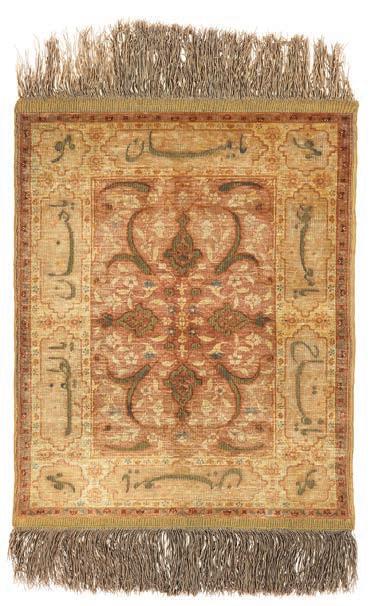
Initially both Hagop and Zareh, also from Kayseri, looked to 16th-century Persian Safavid carpets in the collection of the Imperial Treasury at the Topkapi Palace for inspiration before establishing a signature style.
A number of works by Hagop pre-date those of Zareh, one such being a large horizontal silk rug of Persian design that was exhibited by him in Paris in 1900 at the Exposition Universelle.
This carpet (below) is larger in scale than many examples in Farrow’s collection and, unusually, woven horizonally, with a deep silk pile and lustrous sheen. Interestingly, the design is a copy of a much earlier 16th-century Safavid Persian carpet, now in the Hermitage museum in St Petersburg.
Hagop, however, would not have seen the original carpet but, rather, have encountered it illustrated for the first time in colour, in the so-called “Vienna” book published in 18921896 by the German Orientalist and collector of Islamic art, Friedrich Sarre (1865-1945).
The volume was a vital source of information on the designs of Safavid, Ottoman and Mughal carpets for weavers such as Hagop and Zareh.

Documenting lives
Farrow collected at a time when the careers of the ‘master weavers’ – most of whom had died in the mid20th century – were still within living memory. When he began his work, Koum Kapi rugs were poorly understood, shrouded by ‘dealers’ lore’ and often miscatalogued by institutions and auction houses alike.
Working with Armenian friends in ParisandIstanbul, he contacted those who had known Hagop and Zareh and recorded their memories. He collected a wealth of documentary evidence for their work, including letters, draft contracts, photographs,and even original cartoons, some of which are included in the sale.
is treasure trove of oral history and ephemera gives extraordinary insight into the making of these rugs. Carpet expert and author, Ian Bennet, wrote: “Were it notfor the work of George Farrow and one or two others, we would know almost as little about silk rugs from 1900 as we do about those from 1600.”
Farrow also collaborated with Leonard Harrow on a monograph Hagop Kapoudjian: e First and Greatest of the Kum Kapi School. It appeared in 1994 and has become the standard text on Hagop’s life and career. Less widely known are Farrow’s own collection catalogues, which drew together much of the ephemera mentioned above, as well as personal reflections on his collection.
Louise Broadhurst is Christie’s director and international head of department, rugs and carpets. Sultans of Silk -The Collection of George Farrow comprises 44 lots in the Art of the Islamic and Indian Worlds sale taking place atthe London auction house on April 25.
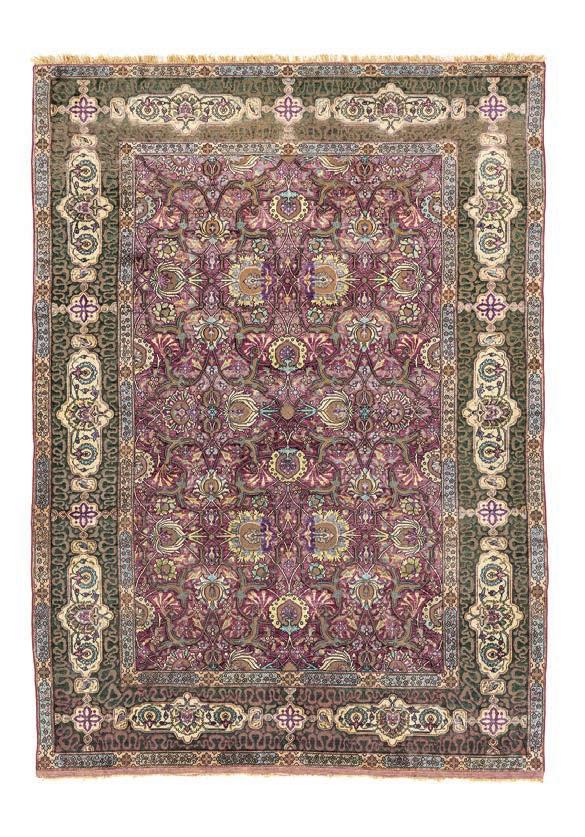
44 ANTIQUE COLLECTING
Above A silk and metalthread Koum Kapi mat by Zareh Penyamin, c. 1920, 1ft 11in x 1ft 3in (59cm X 39cm). It has an estimate of £2,000£3,000
Left A silk and metalthread Koum Kapi rug by Hagop Kapoudjian, Istanbul, c. 1895 5ft 1in x 8ft 2in (157cm x 248cm). It has an estimate of £40,000£60,000
Right A silk and metalthread Koum Kapi rug signed by Hagop Kapoudjian, Istanbul, c. 1900, 6ft x 4ft 3in (183 x 129cm.). It has an estimate of £20,000£30,000











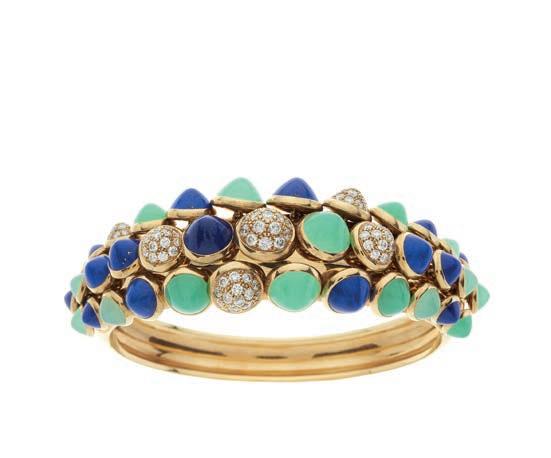
We are now accepting entries for our June & July auctions. in Berkshire. DESIGN, ART & INTERIORS THURSDAY 16 TH MAY To feature items from British, Continental and International Design Movements INVITING CONSIGNMENTS Contact us for sales advice We are particularly interested in works by Liberty, Lalique, Macintyre, Shapland & Petter, Moorcroft, William de Morgan, Martin Brothers, Ferdinand Preiss, William Morris, Louis Solon, Clarice Cli , and Robert Mouseman Thompson. ALL ENQUIRIES +44 (0)207 431 9445 | info@dawsonsauctions.co.uk | www.dawsonsauctions.co.uk O ces in London and Berkshire | National collection service available on request ANTIQUE COLLECTING 45 SAVE THE DATES 2024 UPCOMING EVENTS Call 07789 502027 / 07395 056393 Email classicantiquefairs@btinternet.com or davide@inlocoevents.co.uk www.classicantiquefairs.co.uk Friday 20th - Sunday 22nd September Farnborough International Exhibition & Conference Centre, Hall 5 10am - 5pm Friday & Saturday, 10am - 4pm Sunday Friday 29th November - Sunday 1st December Birmingham NEC Exhibition Hall 10 10am - 5pm Friday & Saturday, 10am - 4pm Sunday Friday 12th - Sunday 14th July Birmingham NEC Exhibition Hall 10 10am - 5pm Friday & Saturday, 10am - 4pm Sunday july 12-14 sept 20-22 NOV 29-01 dec Cartier, a diamond, lapis lazuli and chrysoprase Nouvelle Vague Mischievous bangle bracelet – sold for £10,400 COTSWOLD AUCTIONEERS & VALUERS SPECIALISTS IN SINGLE-OWNER COLLECTIONS NATIONWIDE VALUATIONS & ADVICE UPCOMING AUCTIONS: Silver & Objects of Vertu – 22nd March Cotswold Interiors & Collectables – 12th April Jewellery, Watches & Designer goods – 3rd May 10-12 Cotswold Business Village, London Road, Moreton-in-Marsh, GL56 0JQ 01608 695695 enquiries@kinghamsauctioneers.com www.kinghamsauctioneers.com THE MENAGERIE: AN AUCTION OF ANIMAL ANTIQUES AND COLLECTABLES Contact Catherine or Tom on 0208 468 1010 Email: tblest@catherinesouthon.co.uk A large late 19th century Swiss Black Forest carved dog group attributed to Walter Mader. Sold for £4000 (plus premium) 11th September 2024 Inviting entries for single items or collections
SAL EROOM SPOTLIGHT
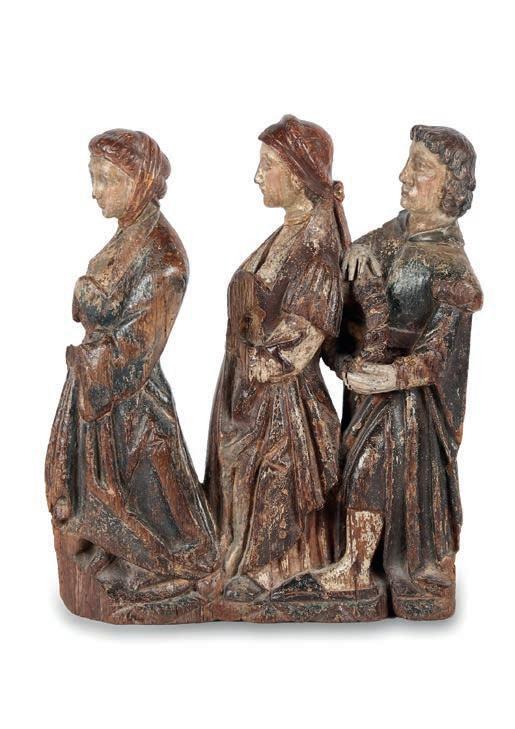
e collection of Keith Hockin, one of the rst and most important dealers of early oak, goes under the hammer this month in Su olk
Far right An Elizabeth I, or James I, carved female term, below a pair of eagles, it has an estimate of £1,500£1,800 at this month’s sale at Bishop & Miller
Right An iron and oak rushnip, north Wales, c. 1800, it has an estimate of £600-£800
Left A rare 15th-century oak and polychrome gure group, it has an estimate of £7,000£10,000
Below A George III sycamore platter, it has an estimate of £200-£300 at the same sale
Below right A leather bombard, English, c. 1680-1720, it has an estimate of £1,500£2,000
Friends of the renowned dealer Keith Hockin, who died last year – attest to his three loves: his wife Pat, with whom he opened his rst shop in Nottingham in 1970; his beloved trombone, which he played as a member of the jazz sextet the Antique Six, and, of course, early English antiques.
His passion for the latter inspired him to become one of the UK’s leading dealers in the eld, known for championing both the era and its antiques. As such, his stock from the 16th, 17th, and 18th centuries, included early oak furniture and works of art, including early carvings, pewter, copper and ironwork.
In an obituary in the Antiques Trade Gazette, Terry Sparks, from Red Lane Antiques wrote: “With the recent passing of Keith Hockin, the antiques trade has lost one of that remaining generation who were at the vanguard of the early oak furniture revival from the 1960s onwards. Keith was a BADA dealer for nearly 50 years, his stock re ecting his love of colour and surface and originality.”
In 1976, he and his wife moved to Stow-on-theWold, in the heart of the Cotswolds, to a period property on ‘ e Square’ – a mecca for collectors of early vernacular furniture.
From there he o ered co ers, court cupboards, refectory tables, joint stools, livery cupboards and wainscot chairs to a growing number of national and international clients.
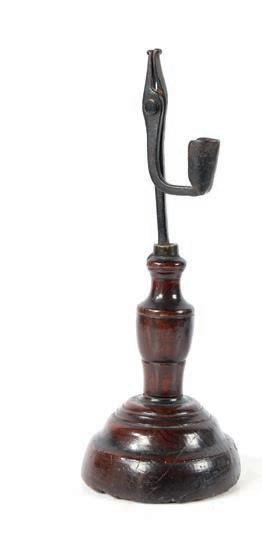
Bombard blast

For collectors, one glimpse of the 450-lot collection on sale at Bishop & Miller, will reel them back to domestic life in the 17th century. One of the highlights is an example of that most English of drinking vessels – the ‘bombard’ – a larger version of a blackjack. e former was likely named after its shape resembling a bombard gun. (Shakespeare mentions bombards at least twice in e Tempest and Henry IV.) e latter blackjack owes its name to the word for the jerkin worn by soldiers (‘a jack’) with ‘black’ derived from their dark pitch, or pine tar resin, waterproo ng.
Both were common from Medieval times and were used for holding water or ale and therefore an invaluable item in any Tudor household or tavern. In 1414, records show New College, Oxford, purchased “four leather jacks two holding a gallon each and two a pottle each, the four costing four shillings and eightpence.”
As a vessel for the refectory or the baronial hall, they remained so until fashion prevailed for the manorial head to take his meals privately in parlour or dining room. At this time the leathern blackjack remained in the servants’ hall, while those intended for high-class use became edged with silver.

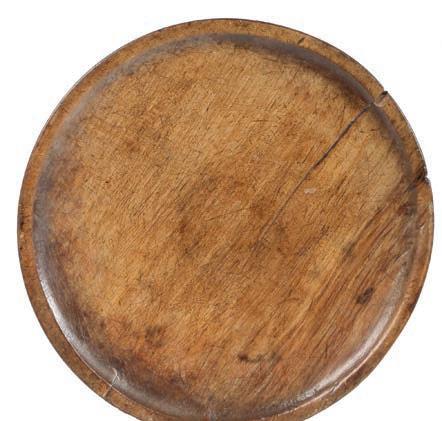
46 ANTIQUE COLLECTING
ANTIQUES UNDER THE HAMMER e Keith Hockin collection

Pewter dish
Another highlight is a pewter dish, dated to the reign of Charles II (1660-1685) engraved with the arms of the Worshipful Company of Butchers.
e use of pewter, both domestically and ecclesiastically, reached its peak in the 17th century when every home and tavern would have jugs, plates, buttons, toys, tankards, wine cups, inkwells, candlesticks and spoons made from the metal.
Pewter was also used for ‘display’ wares such as large dishes, or chargers, like this lot, that were set out on the bu et and never used. e metal (an alloy of tin, copper and antimony) was said to be favoured by nobles after cashhungry Charles II took to con scating silver to raise money without having to consult parliament. Once removed, owners preferred to replace their nest silver with pewter in case the snatch was repeated.
Unlike in Europe, decoration on British pewter –certainly until the reign of Charles II – was the exception rather than the rule. e commonest early method was known as “wriggle work” carried out by a chisel-ended tool which is worked from side-to-side to produce a zig-zag. In most cases the designs are crude, as it was the pewterers themselves who were responsible for adding the decoration. After the reestablishment of the monarchy in 1660 designs became more sophistcated, using ner lines, perhaps due to the in ux of skilled Huguenot craftsmen to the UK.


AUCTION fact file
WHAT: The Keith Hockin collection
Where: Bishop & Millers’ Suffolk saleroom, 19 Charles Industrial Estate, Stowmarket, IP14 5AH
When: April 11 Viewing: April 6 from 9am-1pm, April 7 from 9am to midday, April 8 to 10, 9.30am-4.30pm and online bishopand millerauctions.co.uk
IN MY OPINION...
We asked Bishop & Miller’s head of sale Oliver Miller for his sale highlights

How important is the collection?
Very. It includes some of Keith’s personal collection reflecting his own collecting interests which were, most definitely, quirky, naïve and fun. It includes carved oak panels, leather costrels and bombards, a number of treen pieces and pewter, including some incredibly early spoons and pistols.
Often dealers’ personal collections fall into two main categories: the first is full of mistakes, squirrelled away from prying eyes; while the second is full of treasures, equally hidden but lovingly discovered and curated over decades.
Keith’s collection was very much of the second type. Just as his selling stock, nothing has to be excused for having a repair or alteration, and all are excellent examples of their type. Furthermore, the collection is full of items now hard to find.
All of the early pieces have a history attached to them, many along regional lines which make them feel very personal.
Have you got a personal highlight?
Above left A Charles II pewter engraved broad rim and bossed dish, c.1660, engraved with the arms of the Worshipful Company of Butchers, along with roundels of a stag, pelican and wyvern. It has an estimate of £4,000-£6,000 at this month’s sale
Far left A Henry VIII bronze wool weight, it has an estimate of £5,000-£7,000
Left A rare Henry VIII oak panel, carved with a pair of male bust pro les, it has an estimate of £1,500-£2,000
‘In 1976, he and his wife moved to Stow-on-the-Wold at the heart of the Cotswolds, to a period property on ‘The Square’ – a mecca for collectors of early vernacular furniture’
I think my favourite piece is a charming and rare 15th-century oak and polychrome figure group (far left) which is expected to make £7,000-£10,000. The trio retains its original decoration and being this early is a rare survivor of the period. It is a real joy to handle and see.
Is there anything in the sale to attract the new collector?
A good place to start would be a Charles I carved oak panel, c. 1640. It would be a great entry piece for a new young collector, showing how you can own a piece of oak carved by someone form the mid 17th century for as little as £40.
Where are you expecting interest to come from?
We are seeing a growing demand in this field, especially for items that have not come onto the market for such a long time.
For that reason this auction will generate a great deal of interest from collectors after a hidden treasure. We expect to see interest from both the UK and American market, both of which have keen collectors of early antiques.
ANTIQUE COLLECTING 47
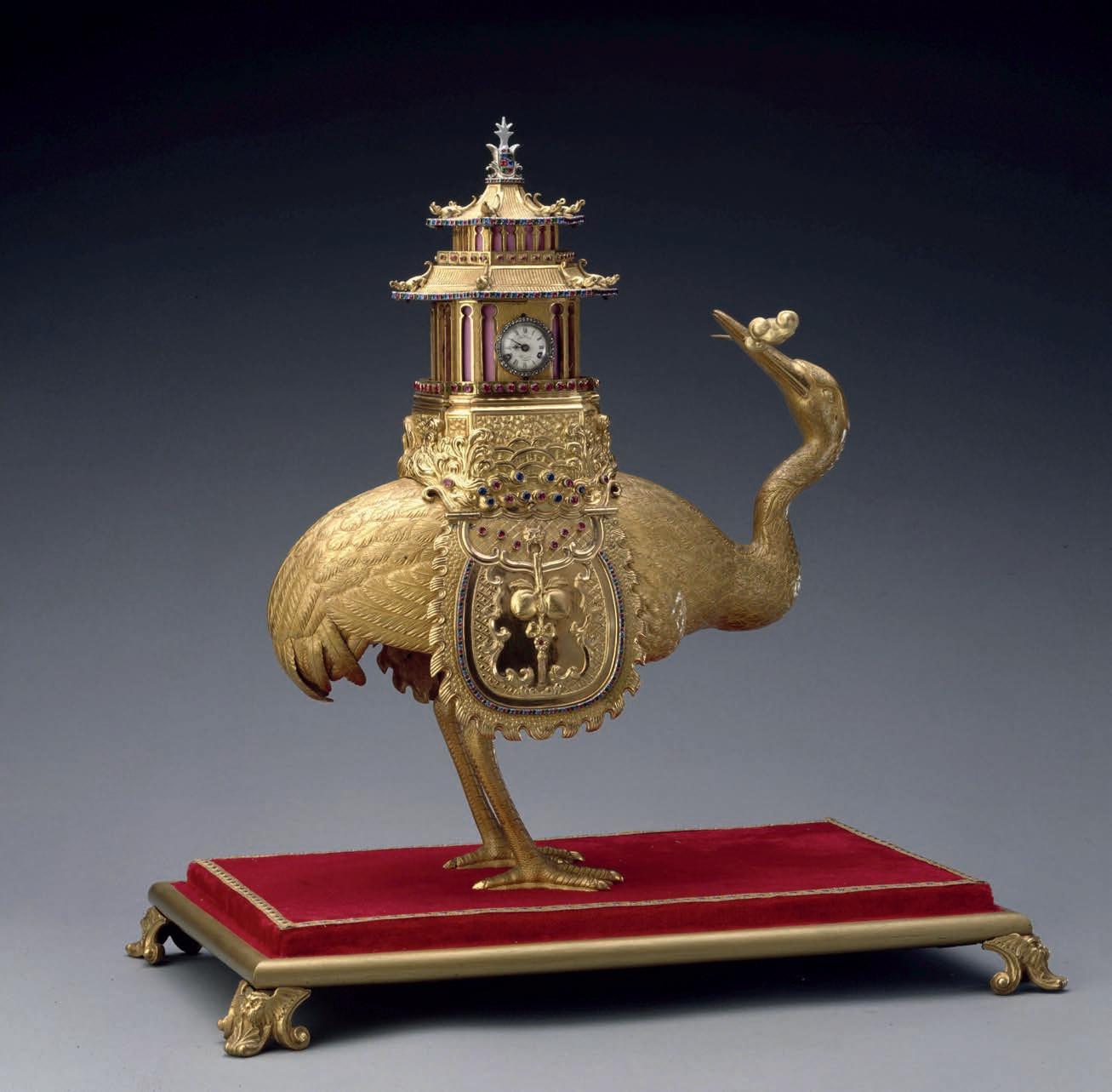
Clock This
Both intricate and fantastical, Chinese ‘singing’ clocks were high fashion among the Imperial Court. But despite the lotus leaves, cranes and bats, they had British makers at their heart, Antique Collecting goes behind the scenes at a new exhibition
While English clocks were exported to China from as early as the 16th century, by the 18th century, they had morphed into luxurious versions. ese fancy automata, known as ‘sing-songs’ in England and zimingzhong in Chinese, soon caught on with the country’s emperors and high-ranking court o cials.
It’s easy to see why. Clocks were already part of courtly gift-giving traditions, with courtiers and overseas visitors presenting spectacular designs to the Qianlong emperor, the fancier or more intricate the better.
Zimingzhong, meaning ‘self-sounding bells’ and pronounced ‘zi-ming-jong’, were a unique combination of East and West. Not only did they tell the time, they
48 ANTIQUE COLLECTING
THE EXPERT COLLECTOR Chinese zimingzhong
played music ranging from Handel to the Chinese folksongs Molihua and Jasmine Flower
As the new exhibition at the Science Museum shows, many of them started their journeys 8,000 miles from the Forbidden City in 18th-century London clockmakers’ ateliers.
Global trade

In the 1700s China was at the centre of an emerging globalised economy and held a quarter of the world’s wealth. Across Europe, fashionable Chinese goods such as silk, porcelain and tea were in high demand.
But in contrast, most British exports were not popular in China, with UK merchants having to part with precious silver to aquire Chinese goods. To help address the trade imbalance, merchants brought British-made luxury goods, including zimingzhong, to Guangzhou, a bustling port on China’s southern coast, to trade.
Snapped up by Chinese o cials, they were sent 2,000km to the Forbidden City as a gift to the emperor as a sign of loyalty and to curry favour.





Opposite page Zimingzhong with parts from China and Britain, James Cox, 1700s, © e Palace Museum














Left A Zimingzhong made up of a clock mechanism made in Guangzhou with the maker’s name Cheong Sing engraved in both Chinese and English. When wound, miniature birds swim on a pond to opening lotus owers, early 1800s © e Palace Museum

Right Zimingzhong with a print of the coronation of Louis XIV, made by Stephen Rimbault (1711–1786), c. 1780 © e Palace Museum
Below left A zimingzhong in the shape of an elephant. When wound, the animal’s tail and trunk sway and its eyes roll, 1700s © e Palace Museum
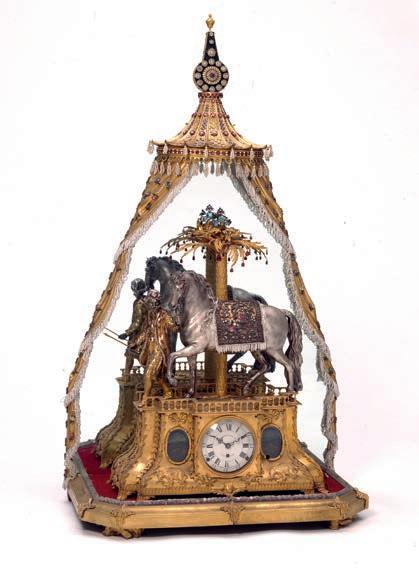
INSTRUMENT OF POWER
Collecting Western curiosities was a political strategy for Chinese emperors. Three generations of emperors collected zimingzhong during the Qing dynasty between 1662 and 1795: the Kangxi Emperor (1662-1722), the Yongzheng Emperor (1723-1735) and the Qianlong Emperor (17361795), the latter being their most ardent fan.
The Qing dynasty was a time of great prosperity and social change in China with emperors amassing hundreds of zimingzhong, using them to demonstrate their power and international reach.
One such is the zimingzhong (above) showing a print of Louis XIV and made by the noted London clockmaker of Huguenot descent Stephen Rimbault (1711–1786).
It had the dual purpose of being an accurate timekeeper to organise imperial work and life, but secondly, and most importantly, with its Western technology and aesthetic, by displaying it in the Forbidden City, the emperor demonstrated his status and international reach. In Chinese cosmology, the emperor was the only person connecting Heaven and Earth. By demonstrating his mastery of the heavens through tracking celestial movements, he could prove his right to rule the country.
‘Not only did they serve as an accurate timekeeper to organise imperial work and life, by displaying it in the Forbidden City, with their Western technology and aesthetic, the emperor showcased his status and international reach’
ANTIQUE COLLECTING 49

THE EXPERT COLLECTOR Chinese zimingzhong
Left A Zimingzhong by three makers including the artist John Howes, clockmaker John Marriott and goldsmith Lewis Pantin, 1780s © e Palace Museum
Below left Zimingzhong in the form of a potted landscape known as penjing which was a popular artform in the 1700s. Made by Timothy Williamson, recorded as working in London from 1769-1788 © e Palace Museum
Academy in 1772. John Marriott of the Clockmakers’ Company made the clock mechanism, and goldsmith Lewis Pantin crafted the elaborate gilt-metal casing.
Chinese makers
It was not long before clockmaking centres grew up across China where skilled artisans re-created, adapted and made their own zimingzhong. e most important ones built up around the port of Guangzhou itself, with its large community of skilled makers.
Using local talent was cheaper than importing from Europe, and zimingzhong could be made to the emperor’s speci c instructions.
e makers built on China’s tradition of mechanical knowledge dating back thousands of years before zimingzhong arrived. As long ago as the 11th century Song Su (1020–1101) had designed a water-powered astronomical clock tower featuring the rst known example of a mechanical escapement (a device for regulating a timekeeper). But it appears the knowledge was lost over time and the types of mechanisms within European zimingzhong would have appeared new to most people in China in the 1700s.
Blue enamel
Combination of talents
With their many parts, from gilt metal gurines to musical mechanisms, making a zimingzhong required the skills of a wide variety of makers in workshops across Europe.
But while hundreds of makers could be involved in the creation of just one zimingzhong most of their names remain unknown as most did not sign their work.
e zimingzhong above is known to have had three makers. e intricate enamel paintings were made by the artist John Howes, who rst exhibited at the Royal
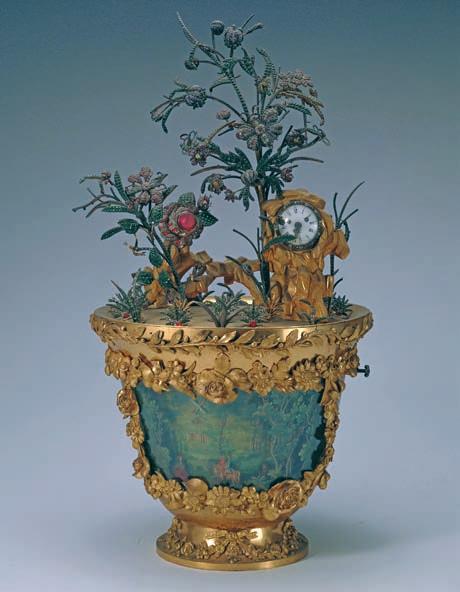
Some of the Chinese-made zimingzhong from Guangzhou can be identi ed through their blue enamel decoration used to cover a metal such as copper or silver. To create the enamel, the maker formed a powdered glass paste, mixing it with cobalt oxide, which gave it a deep blue colour. Glass paste was then applied to the metal and heated at a high temperature, fusing it to the surface. Another Chinese feature was the use of king sher feathers on the clock. e complex and delicate process of attaching feathers to metal is known as (dian cui, a dipping of blue) which became particularly popular during the Ming and Qing dynasties. Craftspeople probably glued the feathers to a backing sheet before delicately bonding this to the surface of the clock.
Lost in translation
With such a cross-cultural trade there were often mishaps on both sides. When it came to British zimingzhong designed for the Chinese market little was known of the Far East. Most people in Britain had never met someone from China, nor travelled there themselves. Designers made assumptions about Chinese tastes based on European travel writing and imported Chinese products –and by using their, generally awed, imaginations.
‘Equally, when the Qianlong emperor ordered Guangzhou makers to reproduce British zimingzhong mistakes were made. One clock copied from one by the London clockmaker Timothy Williamson shows the name and place on the dial are upside down’
50 ANTIQUE COLLECTING

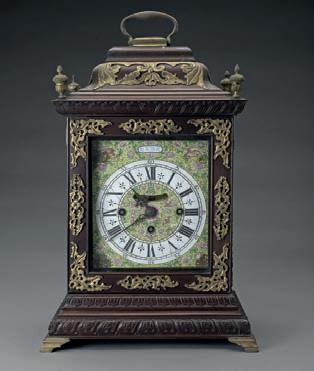
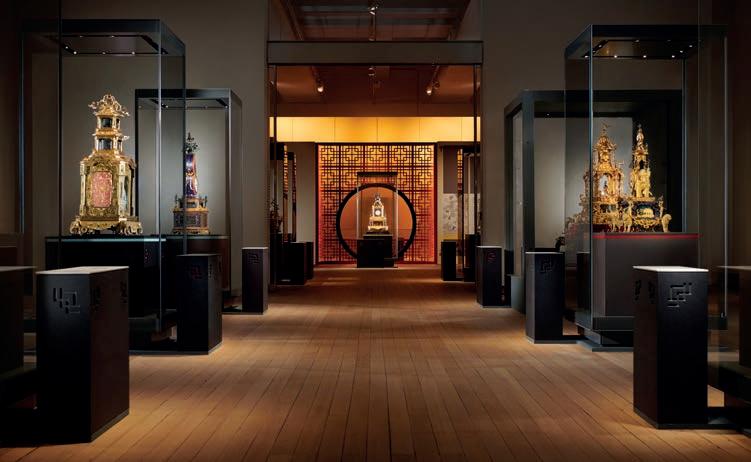
With its turbaned gure and tasselled tent, Indian in concept, the zimingzhong (below left) re ects some of the misconceptions of China in the 1700s.
Equally, when the Qianlong emperor ordered Guangzhou makers to reproduce British zimingzhong mistakes were also made. e clock (below right) copied from one made by London clockmaker Timothy Williamson shows the name and place on the dial are upside down.
Swan song
In 1796, the Qianlong Emperor’s son, the Jiaqing Emperor, ascended to the throne. Unlike his father he saw expensive zimingzhong as a waste of money and the British trade soon faded. However, zimingzhong continued to be used in the Forbidden City and by China’s elite. Today, a permanent exhibition of more than 1,500 amazing zimingzhong inspires millions of visitors each year at e Palace Museum in Beijing.
Zimingzhong: Clockwork Treasures from China’s Forbidden City is on at the Science Museum in London until June 2, for more details on the exhibition go to www.sciencemuseum.org.uk/see-and-do/zimingzhong






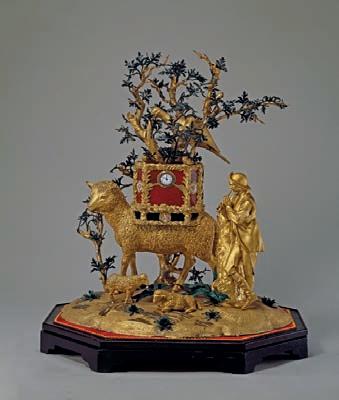
Above far right Zimingzhong with shepherd scene, made in Britain by Timothy Williamson, probably 1769–1790 (Qianlong reign) © e Palace Museum
Above right A zimingzhong includes a depiction of nine bats, 1736–1795 © e Palace Museum
Above Gallery view of Zimingzhong: Clockwork Treasures from China’s Forbidden City at the Science Museum © Science Museum Group
Below left Zimingzhong with turbaned gure, c. 1770 © e Palace Museum
Below European-style zimingzhong, made in Guangzhou, 1700s © e Palace Museum

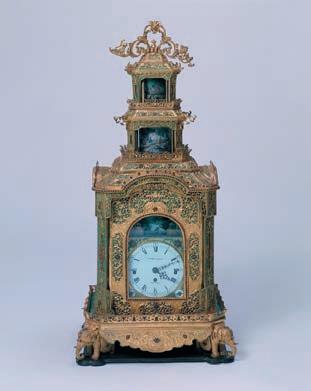

Fusion of symbols



Makers in both the East and West had to be particularly knowledgeable about the symbols which would appeal to the Chinese market.
The Qianlong emperor apprecated zimingzhong with restrained wooden architectural designs (above left).
Within its floral decoration are nine bats. The Chinese word for bat, fu, sounds similar to the word meaning good fortune. Bats are therefore an auspicious symbol in China.
At the base of the clock lotus petals symbolise purity, an association made because lotus flowers grow out of mud.
Equally, the exhibition includes a publication from 1809 written by Chaojun Xu and on loan from the Needham Research Institute, titled Illustrated Account of Zimingzhong
The document was used as a guide for converting the Roman numerals used on European clocks into the Chinese system of 12 double-hours (shi).
Arcadian scenes
Despite very little knowledge of Britain, on the other side of the coin, scenes of English rural utopia were greatly favoured at the imperial court. As a counterpoint to such opulence, many zimingzhong feature ‘humble’ pastoral scenes, with farmyard animals and thatched huts.
The shepherd scene (above right) was created by the British maker Timothy Williamson, who was not a horologist (the clock mechanics may have been supplied by the maker William Hughes in High Holborn) but had the skills of a talented goldsmith.
Williamson was adept at combining both eastern and western sensibilities, with one of his zimingzhong featuring a young writer wearing a Georgian court suit. Instead of writing in alphabet, he is writing in Chinese.
Numerous musical clocks by Williamson were sent to the Chinese emperor and are today in the Beijing Palace Museum, including a spectacular pagoda-form automaton clock, produced in collaboration with the Swiss Jacquet-Droz family with a scroll in Chinese characters.
ANTIQUE COLLECTING 51
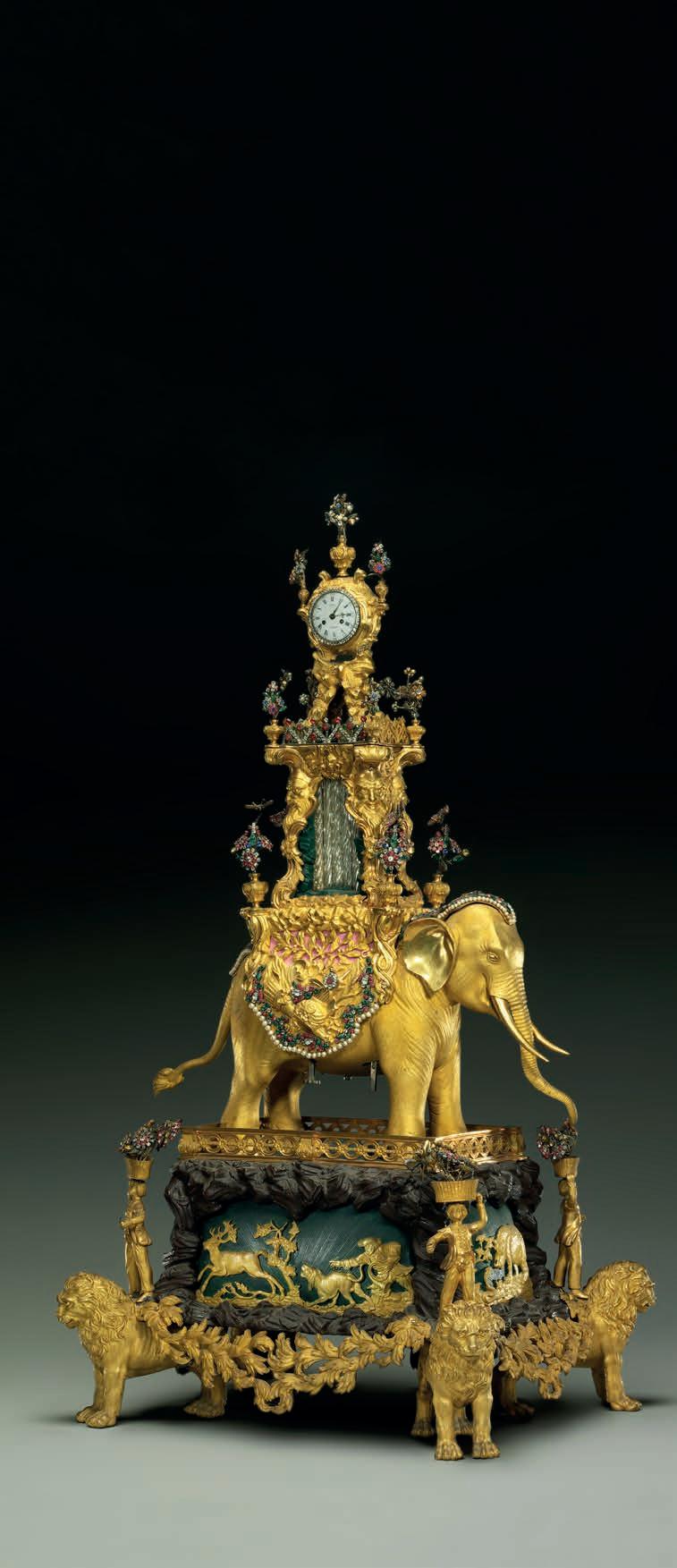
James Cox (c. 1723-1800)
BRITISH MAKERS
e skills of 18th-century British clockmakers such as James Cox were at the heart of the zimingzhong’s complex mechanisms
Gilt-metal zimingzhong, produced by James Cox, probably 1750–1795 © e Palace Museum
By the end of the 1700s almost half of the world’s clocks and watches were made by skilled makers in Britain. e most famous person associated with making British zimingzhong was James Cox. Originally trained as a goldsmith, Cox progressed to managing every part of zimingzhong production, from design and marketing to shipping, working with many skilled makers to create each part of a zimingzhong, claiming a workforce of up to a thousand between 1766 and 1773.
His trade card stated his London address as ‘At the Sign of the Golden Urn’, where he described himself as a goldsmith who Makes Great Variety of Curious Wares in Gold, Silver and other metals. Also, Amber, Pearl, Tortoiseshell and Curious Stones.
Cox himself was not technically trained: having started his career as a “toyman”, he became an entrepreneur and merchant in the 1760s, concentrating on identifying markets, specifying the goods required, and providing the nance needed for production and export to the Far East.
While few of the craftsmen on which his projects relied ever signed their work, it was a legal requirement of the day for a maker’s name to be visible on exported clocks, hence Cox’s name appeared while it’s likely he would never have been responsible for a clock movement.
Skilled immigrants
With little available historical evidence, not much is known about how these makers worked together, who else was involved or how the di erent parts were assembled.
Of Cox’s large sta few would have been employed full-time, with many highly-skilled immigrants on his pay roll including his chief workman up to 1773, John Joseph Merlin (1735-1803), an immigrant worker from near Liège.
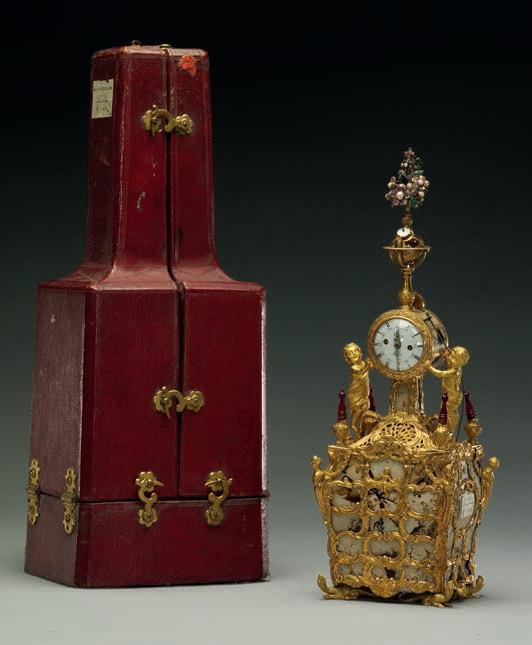
Zimingzhong produced by James Cox showing the movement of the stars and planets around Earth, probably 1760–1795 © e Palace Museum
52 ANTIQUE COLLECTING THE EXPERT COLLECTOR Chinese zimingzhong
At the time (Chinese buyers were not concerned with the makers of the luxury items) there was a system of subcontracting in the traditional luxury trades, that permitted a exible subdivision of labour while also spreading the nancial risk.
In addition, Cox evidently bought some articles in a nished or semi- nished state from leading London clock and watch makers like James Upjohn who was responsible for the temple zimingzhong (right).
Similarly, creating pieces out of solid gold was expensive meaning producers like Cox would have hired gilders to coat zimingzhong in gold, possibly using the ormolu technique. is involved pouring molten metal into a mould, leaving it to set and then applying mercury and powdered gold to the surface. When heated, the mercury evaporated and the gold fused to the surface of the metal.
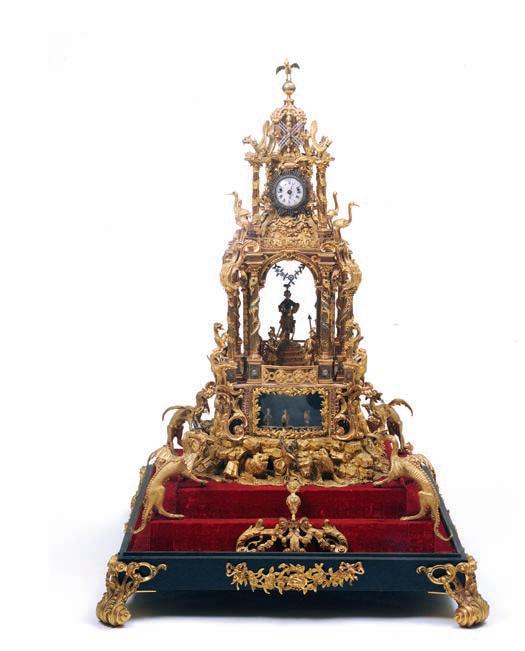
But Cox’s success was also his downfall. In 1770, Chinese merchants wrote to the East India Company asking them to desist exporting any more fancy objects to China as they had a mountain of unsold curiosities to the value of £330,000 – many from the proli c workshops of one James Cox.
New direction
With a sudden collapse in trade to the Far East, Cox proved his entrepreneurial mettle by opening the Spring Gardens Museum, near the Admirality Arch, displaying 22 of his most magni cent creations among other exhibits (including, some say, Oliver Cromwell’s head).
His plan was to raise cash by the exorbitant entry fee of 10s 6d. Despite the half-guinea entry fee, the museum became one of London’s major attractions, and takings soon hit £500 per week. When this proved insu cient, Cox held a lottery of the exhibits, issuing 120,000 tickets at one guinea each – but with 40,000 tickets unsold, the museum was closed and much of Cox’s stock auctioned. Little is known of his later life other than that he died in Watford and left an estate valued at less than £100.
‘With a sudden collapse in trade to the Far East, Cox proved his entrepreneurial mettle by opening the Spring Gardens Museum, near the Admirality Arch, displaying 22 of his most magnificent creations among other exhibits (including, some say, Oliver Cromwell’s head)’
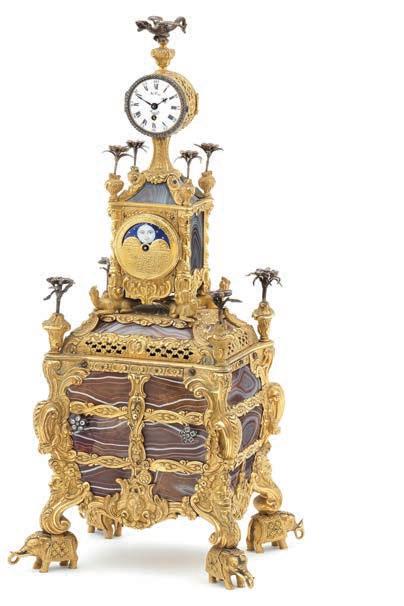
Above Temple Zimingzhong made by James Upjohn commissioned by James Cox, 1760s © e Palace Museum
Above right e gate-set ormolu musical clock by James Cox sold for £385,250, image courtesy of Bonhams
Below right A paste and gilt metal automaton watch c.1770 made by Cox sold for £11,000, image courtesy of Mellors & Kirk
MUSICAL CLOCKS AT AUCTION
When a mid 18th-century zimingzhong by James Cox (above) went under the hammer at Bonhams in 2012 it sold for £385,250. It was the first time in almost 60 years the agate-set ormolu musical clock made by Cox in 1766 had been offered for sale. Measuring 37cm from the base of its elephant feet to the wingtips of its silver dragon finial, the clock is a perfect example of the fantastical creations that made Cox’s name.
Bonhams’ head of clocks, James Stratton told Bonhams magazine: “We are used to seeing amazing things, but this clock is simply extraordinary. It is an object that was designed to enthral and make a statement, a world apart from the clocks made by Cox’s English contemporaries.”
For the less well-heeled collector, work by Cox regularly appears in regional salerooms with a lower price tag. In 2020, a paste and gilt metal automaton watch, c.1770, sold for £11,000, beating its estimate of £6,000-£8,000 at the Nottingham auction house Mellors & Kirk.
Known as a ‘toy’ the 7.5cm clockwork watch is wound by its central dial after which two star clusters rotate. It required some minor work but was apparently complete and in original condition.

ANTIQUE COLLECTING 53
ANTIQUES UNDER THE HAMMER Lots in April
TOP of the LOTS
A remarkable collection of 20th-century art goes under the hammer in Kent while early cycling memorabilia is set to y at two sales in
Dorset and Somerset

A small Victorian bugle used to warn cyclists of the dangers on the road has an estimate of £200-£300 at the Dorset auctioneers Charterhouse’s sale in Sherborne on April 3.
The silver-plated instrument, called a buglet, would have been blown to announce when cyclists were to mount, move off, slow down and dismount. Measuring just 18.5cm, it is engraved with the words Presented by the Lewes Bicycle Club won by J Andrews Jnr July 11th 1878.
Raquel Welch, who died last year at the age of 82, goes under the hammer at Julien’s Auctions on April 12 in California, expected to make between $500 to $700.
While it was modelled on the two-piece she wore in the 1966 film One Million Years B.C. which launched her career, the replica outfit was worn by her in the 1974 TV special Really Raquel. Welch’s appearance as a cavewoman in a deerskin bikini in the pre-historic epic catapulted her to international stardom and made her one of the era’s biggest sex symbols.

A collection of Bradford City football club programmes dating back to 1909 goes under the hammer at Sheffield Auction Gallery’s sale of sporting memorabilia on April 18.
Compiled over the years by an avid enthusiast, it includes many pre-war and war-time issues, both at Valley Parade and away. The collection also includes many match tickets, team sheets and books from the Bantams (the team’s nickname due to their red and orange colours said to resemble the plumage of a bird). Most estimates range from £80-£120 per lot.
Above


A stoneware bottle by the British studio potter and ceramic artist Elizabeth Fritsch (b. 1940) has an estimate of £3,000-£5,000 at Bonhams’ design sale at New Bond Street on April 24.
Fritsch who was born in Whitchurch in Shropshire to Welsh parents, trained as a musician before taking up pottery in 1966. She studied ceramics at the Royal College of Art under the well-known German-born ceramicist Hans Coper (1920-1981) whose work appears in the same sale. After graduating in 1971, she worked in the Bing and Grondahl factory in Copenhagen where she held her first exhibition. In 1987, she set up her own studio in London.
Right Fritsch’s ‘Cubist’ bottle, c. 1984, stoneware, coloured slips, 24.3cm x 10cm x 4cm

A collection of early cycling medals and ephemera, dating from the earliest days of organised races, has an estimate of £4,000-£6,000 at Lawrences’ sale in Crewkerne in Somerset on April 17.
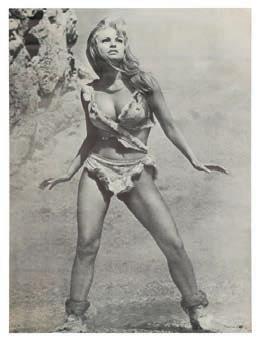


The collection, which includes 20 cased gold medals and 11 silver ones, dates from the 1890s to the early 1900s and relates to the keen cyclist Frederick Charles Lowcock who was born in 1876 in Northenden, Manchester. Lowcock, who was the managing director of a glove factory, became a keen member of the Manx Wheelers Cycling Club after moving to the Isle of Man.
Lawrences’ Simon Jones said: “This is the largest and most impressive cycling collection I have seen. Collections with such good history are rare so we are hoping for some eager interest.”


54 ANTIQUE COLLECTING
An iconic fur bikini worn by
Above e buglet signalled the time for 19th-century cyclists to dismount
Above right e medals date from the earliest days of organised cycling races
Bantams’ fans are in for a treat at the She eld sale
Below e faux suede and fur bikini was worn by Raquel Welch
Below right Her appearance in the lm One Million Years B.C. which launched her career

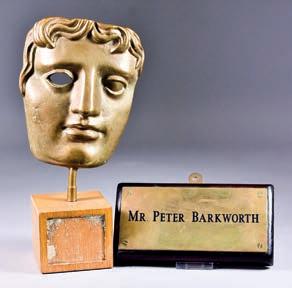
The remarkable art collection of the award-winning Kent actor Peter Barkworth (1929-2006) goes under the hammer at The Canterbury Auction Galleries this month inKent, including works by LS Lowry, Bridget Riley and Ivon Hitchens.
Barkworth is best remembered in the title role of Mark Telford, a bank executive suffering a midlife crisis, on the ‘70s show Telford’s Change. But his talents in front of the camera belied his eye as an art collector, with many pieces bought as gifts for his partner David Wyn Jones, who died last year. When Barkworth died in 2006 he bequeathed 55 works from his exquisite collection to the National Trust to be hung at Fenton House, London, a few minutes’ walk from his London home in Hampstead’s historic Flask Walk.
Scottish Colourists
Two works by LS Lowry (1887-1976) include a rare penand-ink study of people and animals, signed and dated 1971. On a label on the back Barkworth has written “I bought this in 1979 at a sale in Sotheby’s on 14th March, for £1,000. It’s always been a favourite.” It has a guide price of £25,000. Another label on the other Lowry, a 1960 pencil-and- biro sketch titled Ebbw Vale, reads “I bought this in 1960 at Abbott and Holder. I think it was £4!” It has a guide price of £5,000.
The work expected to sell for the greatest amount (£30,000) is an oil-on-canvas by Ivon Hitchens (18931979) titled Sussex River, Evening Sky, signed and dated 1969. Hitchens was much loved for his bright landscapes painted around his secluded Sussex home.
Work by two Scottish Colourists, Samuel John Peploe (1871-1935) and Francis Campbell Boileau Cadell (1883-1937), have estimates of £7,000 and £6,000 respectively. Both were part of the gang of four artists, along with fellow Scots George Leslie Hunter and John Duncan Fergusson, all of whom were active in the early 20th century.
1 Peter Barkworth was a well-known actor in the ‘60s and ’70s as well as an astute art collector 2 Barkworth twice won a BAFTA best actor in 1975 3 Ivon Hitchens (1893-1979) Sussex River, Evening Sky, oil on canvas, signed and dated 1969, 16 x 29¼in. It has an estimate of £30,000 at this month’s sale 4 LS Lowry (1887-1976) a pen-and-ink study of people and animals, signed and dated 1971, 8½ x 11¼ in. It has an estimate £25,000 5 Bridget Riley (b.1931) Short Sequence, Study for Painting, gouache, 9¾ x 10in signed and dated ’83. It has an estimate of £20,000 6 William Scott (1913-1989) Composition, Ceruleum and Black, gouache, signed, 9 x 11¼ in, dated 1960. It has a handwritten label: “I bought this at Sotheby’s, my memory tells me for £10.” It has an estimate of £7,000 7 Samuel John Peploe (1871-1935) Comrie Sky, oil on canvas, signed, 5½ x 9in. It has an estimate of £7,000 8 Francis Campbell Boileau Cadell (1883-1937) e Ross of Mull, watercolour on canvas, signed, 6½ x 9½in, dated 1922 to back. It has an estimate of £6,000 9 LS Lowry (1887-1976) Ebbw Vale, pencil and biro sketch titled with gures and a dog on a road towards a village, signed and dated 1960. It has an estimate of £5,000 10 Peter Lanyon (1918-1864) Green Landscape, gouache and collage, 6 x 6¾in. It has an estimate of £10,000.

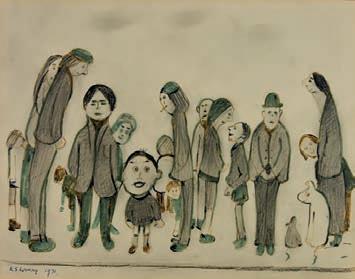


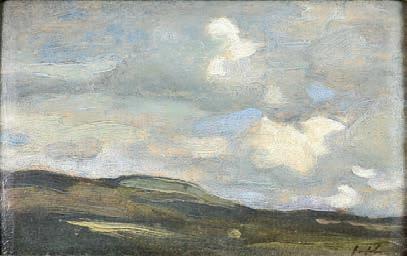

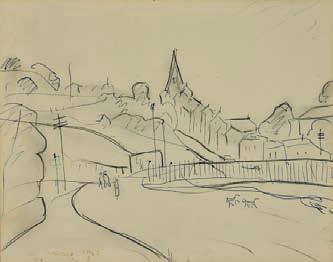
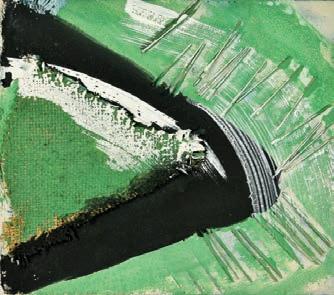
ANTIQUE COLLECTING 55 4 6 7 1 8 9 10

ANECDOTES OF WILLIAM HOGARTHWRITTEN BY HIMSELF
BY WILLIAM HOGARTH & MARTIN MYRONE
ISBN 9781843681793
RRP £10.99
OFFER PRICE £7.14
SUBSCRIBER EXCLUSIVE
BOOK OFFERS
Become a wine bu and explore ‘secret’ Paris all from the comfort of your own armchair, with the latest titles from our sister publisher ACC Art Books UP
TO 35% DISCOUNT
This volume is a fascinating look into the notorious English satirical artist’s life, presenting Anecdotes of William Hogarth, Written by Himself — a collection of autobiographical vignettes supplemented with short texts and essays written by his contemporaries, first published in 1785.

PARISIAN’S PARIS
BY BILL GILLHAM
ISBN 9781873429945
RRP £12.99
OFFER PRICE £8.44
Experience the sights and sounds of the City of Lights like a true native with this expanded edition. Bill Gillham has been visiting Paris for decades, for him, the pleasure is not in revisiting the tourist sights, but rather in immersing himself in a particular quartier, discovering little shops and bistros, exploring markets, parks, and local entertainment, and finding the quirks and particularities of the city’s day-to-day life.
SPEECHES THAT CHANGED OUR TIMES - FROM 1945 TO THE PRESENT
BY CARLO BATÀ
ISBN 9788854420403
RRP £25.00
OFFER PRICE £16.25
From Charles de Gaulle’s announcement of the end of World War II in 1945, Martin Luther King’s “I have a dream” in 1963 and Stephen Hawking’s 2022 speech at his 60th birthday symposium, to Ursula von der Leyen’s State of the Union address in 2022, Speeches That Changed Our Times invites you to read these 38 masterpieces of oratory without restraining the emotions they provoke, in the hope that learning from the past will help build a better world for the present and the future.

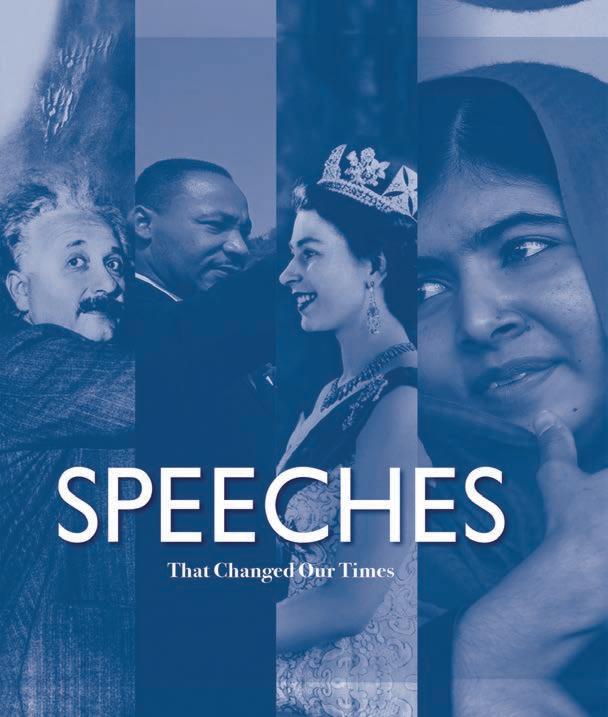
56 ANTIQUE COLLECTING

THE CLASSIC WINE LIBRARY READER - A TASTE OF THE WORLD’S BEST WINE WRITING
BY JULIAN JEFFS, RICHARD MAYSON, REBECCA CLARE
ISBN 9781913141714
RRP £40.00
OFFER PRICE £26.00
The Classic Wine Library is home to some of the world’s best-informed writing on wine. This anthology gathers together selected essays from nearly 30 titles, published over the last 10 years. The chapters cover topics essential to understanding the wines of a range of regions, including their history, wine growing, winemaking and signature wines.
BRITISH ROYAL TOMBS
BY AIDAN DODSON
ISBN 9781843681182

RRP £16.99
OFFER PRICE £11.04
The classic guide to all burials of the kings, queens and lords protector of England, Scotland and the United Kingdom. This fully revised edition of a book that became an immediate classic of its kind is equally interesting to the visitor and student.
The career of each ruler is briefly described, followed by what is known about his or her burial arrangements and the subsequent history of the tomb and its contents.
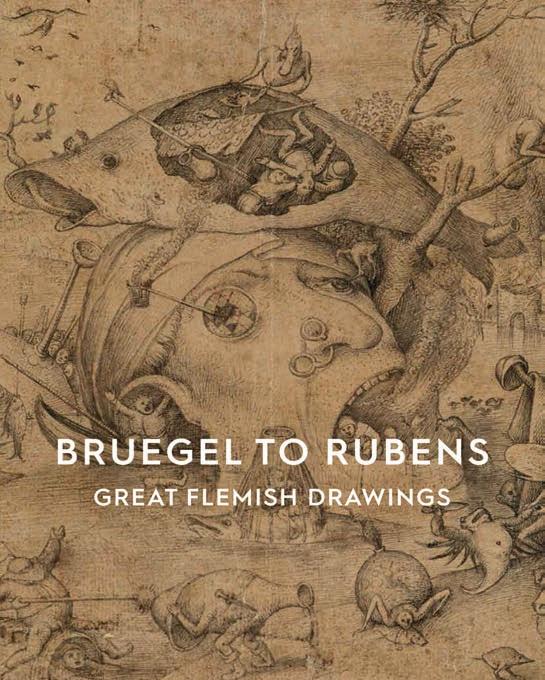
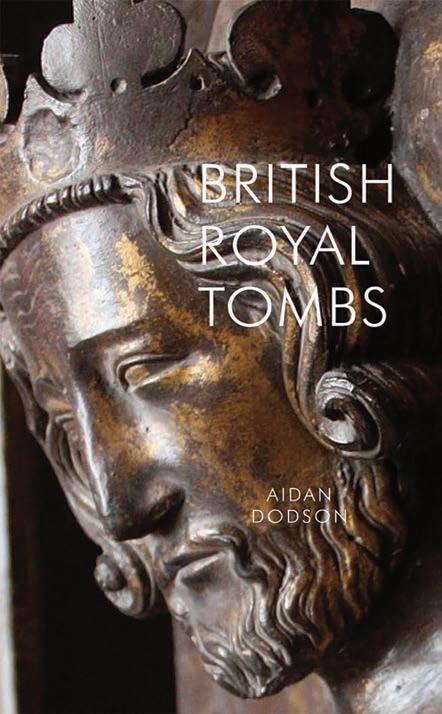
BRUEGEL TO RUBENSGREAT FLEMISH DRAWINGS
BY
AN VAN CAMP
ISBN 9781910807590
RRP £25.00
OFFER PRICE £16.25
Through a selection of over 100 world-class drawings created by Flemish artists in the sixteenth and seventeenth centuries, this book gives an insightful and comprehensive overview into how these drawn sheets were used as part of artistic practice, within or beyond the artist’s studio.
ORDER NOW! Email uksales@accartbooks.com, or call 01394 389950. Postage to UK addresses is £7, call for overseas rates. Offer subject to change without notice.
ANTIQUE COLLECTING 57
FAIR NEWS
Textiles and ceramics are all on o er this month, as well as the return of a popular fair to a former WWII air eld


Bowled over Ceramic Art
London stages its largest ever fair at Olympia this spring marking the event’s 20th anniversary.









Running over three days from April 19 to 21, some 118 makers will take part, selected from hundreds of applications to the Craft Potters Association. Prices willl start at less than £100 for entry-level designs, reaching £10,000 for museum-quality pieces.

Makers from across the globe will take part ranging from Greece to Guatemala, and Korea to Japan.
The list includes Melina Xenaki, who has created exclusive collections for the shops of the British Museum and the Benaki Museum of Green Culture.
Tet o ensive
Westonbirt School, near Tetbury, in Gloucestershire is the home of the Cotswolds Decorative Antiques and Arts Fair this month.
Running from April 12-14, the fair promises everything from traditional antiques to chic and decorative furniture, textiles and accessories.
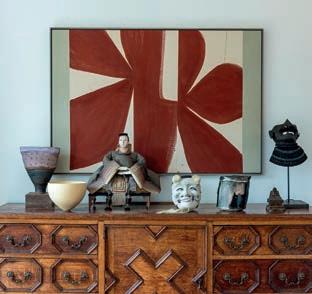
Among its highlights will be a collection of contemporary art by the northern artist Peter Seal (b.1959) to be shown by Anthony Hepworth Fine Art (above). Visitors will also get the chance to meet Antique Collecting favourite David Harvey who will be showcasing an intriguing George III period mahogany metamorphic library stool. For collectors of art nouveau and art deco, Hickmet Fine Art will be offering a fine selection of bronze sculpture and glass.


Taking o
Taking o





popular fair returns to a disused Suffolk airfield this month, six months after its debut event. Runway Flea at Debach Airfield Clopton in Suffolk will host the antiques, vintage and makers market on April 21.
A popular fair returns to a disused Suffolk airfield this month, six months after its debut event. Runway Flea at Debach Airfield in Suffolk will host the antiques, vintage and makers market April 21.

which sees a Dark Norfolk
It is part of organiser Black Dog Events expanding calendar which sees a new fair, called the Dark Horse Brocante, take place at Fakenham racecourse in north Norfolk on June 9.

The company was launched in 2014 with one local brocante and has since expanded to 10 events in 2024 across Suffolk and Norfolk. Debach Airfield is home to the 493rd Bomb Group Museum, with the officers’ mess offering drinks and homemade cakes and savouries during the fair.
Above Black Dog Events returns to Debach Air eld in April
Material world
Now in its 30th year the Textile Society’s Antique and Vintage Textile Fair in Manchester – the first antique fair to specialise entirely in textiles, returns this month.
Dubbed as a “hub for all passionate collectors of textiles”, the event, on April 28 at the city’s Armitage Centre, brings together antique and vintage textile dealers from around the globe.
As well as vintage clothing, collectors can find textiles from the 17th and 18th centuries, including rare cloth remnants and even court dress.
Chair of the Textile Society, Linda Brassington, said: “The fair is an abundant source for objects and ideas, whether wall art or wearables.
“For those who care about sustainability this is a great opportunity to repurpose the old into something unique either to wear, or display in their homes.”
 Right e fair brings together antique and vintage textile dealers from around the globe
Right e fair brings together antique and vintage textile dealers from around the globe
58 ANTIQUE COLLECTING OUT AND ABOUT in April
Above A contemporary artwork by the northern artist Peter Seal (b.1959) on o er from Anthony Hepworth Fine Art
Above A terracotta and green teapot, 2022, by the Turkish-born London ceramicist Ömer Öner on o er at this month’s fair
FAIRS Calendar
Because this list is compiled in advance, alterations or cancellations to the fairs listed can occur and it is not possible to notify readers of the changes. We strongly advise anyone wishing to attend a fair especially if they have to travel any distance, to telephone the organiser to confirm the details given.
LONDON:
Inc. Greater London
Adams Antiques Fairs 020 7254 4054
www.adamsantiquesfairs.com
Adams Antiques Fair, The Royal Horticultural Halls, Elverton Street, SW1P 2QW, Apr 21
Etc Fairs 01707 872 140
www.bloomsburybookfair.com
Bloomsbury Book Fair, Turner Suite at Holiday Inn, Coram Street, London, WC1N 1HT, Bloomsbury Book Fair, Apr 14
Sunbury Antiques 01932 230946
www.sunburyantiques.com
Kempton Antiques Market, Kempton Park Race Course, Staines Road East, Sunbury-onThames, Middlesex TW16 5AQ, Apr 9, 30
SOUTH EAST & EAST ANGLIA:
including Beds, Cambs, Essex, Hertfordshire, Kent, Norfolk, Suffolk, Surrey, Sussex.
Arun Fairs
07563 589725
Emsworth Antiques and Collectors Fair, Emsworth Community Centre. North Street, Emsworth, Hampshire, PO10 7DD, Apr 14
Rustington Antiques & Collectables Fair, The Woodland Centre, Woodlands Avenue, Rustington, West Sussex, BN16 3HB, Apr 7
CL Fairs
07501 782821
Norfolk Collectors Fair At The Parish Hall, Church Street, Cromer, Norfolk, NR27 9HH, Apr 6
Marcel Fairs
07887648255
www.marcelfairs.co.uk
Antique and Vintage Fair, Eagle Farm Road, Biggleswade, Bedfordshire, SG18 8JH, Apr 21
Sunbury Antiques
01932 230946
www.sunburyantiques.com
Sandown Antiques Market, Sandown Park Racecourse, Portsmouth Road, Esher, KT10 9AJ
Apr 14
SOUTH WEST
including Berkshire, Buckinghamshire, Cornwall, Devon, Dorset, Gloucestershire, Hampshire, Isle of Wight, Oxfordshire, Somerset, Wiltshire.
Antique Fairs Cornwall
07887 753 956
www.antiquefairscornwall.co.uk
Lostwithiel Antiques & Collectors Fair Community Centre, Plyber Christ Way, Lostwithiel, Cornwall, PL22 0HA, Apr 14
Pensilva Liskeard Antique and Collectors Fair, PL14 5NF, Apr 28
Arun Fairs
07563 589725
Emsworth Antiques and Collectors Fair, Emsworth Community Centre., North Street, Emsworth, Hampshire, PO10 7DD, Apr 14
Cameo Fairs
07790 126967
Corfe Castle Antique & Vintage Fair, Village Hall, East Street, Corfe Castle, Dorset, BH20 5EE, Apr 7
Continiuity Fairs
01584 873634
www.continuityfairs.co.uk
Matford Centre, Matford Park Rd, Marsh Barton, Exeter EX2 8FD, Apr 13
Drayton Antique & Collectors Fair, 07488549026
Drayton Village Hall, Lockway, Drayton, Abingdon Oxon, OX14 4LG, Apr 14
Hidden Treasures
073947 04272
Benson on Thames Antique & Collectors Fair, The Parish Hall Sunnyside, Benson, Wallingford Oxon, OX10 6LZ, Apr 21
New Forest Fairs Dorset
07904 634858
Shaftesbury Town Hall Antique & Vintage Fair Shaftesbury Town Hall, High Street, Shaftesbury, Dorset, SP7 8LY, Apr 2, 9 16, 23, 30
Sga Fairs
07759 380299
Browsers Antique & Collectors Fair. Pangbourne Village Hall
Adj to Central Village Car Park Pangbourne, Berkshire, RG8 7AN, Apr 27
EAST MIDLANDS
including Derbyshire, Leicestershire, Lincolnshire, Northamptonshire, Nottinghamshire, Rutland.
Arthur Swallow Fairs
01298 274493
asfairs.com
Vintage Flea Market, EXO Centre, Lincolnshire Showground, Lincoln, LN2 2NA, Apr 8
Halcyon Fairs
0780 3543467
Buxton Antiques and Collectors
Fair, The Pavilion Gardens, St Johns Road, Buxton, Derbyshire, SK17 6BE, Apr 13-14
Stags Head Events
07583 410862
www.stagsheadevents.co.uk
Bank Holiday Antiques, Vintage & Collectors Fair, Hood Park Leisure Centre, Ashby-de-la-Zouch, LE65 1HU, Apr 1
Antiques, Vintage & Collectors Fair, Coalville Leisure Centre Coalville, LE67 3FE, Apr 27
WEST MIDLANDS
including Birmingham, Coventry, Herefordshire, Shropshire, Staffordshire, Warwickshire, Worcestershire
B2B Events
07774 147197
www.b2bevents.info
Malvern Flea & Collectors Fair Three Counties Showground, Malvern, Worcestershire
WR13 6NW, Apr 1
Codsall Antiques and Collectables fair
07923 538178
Codsall Village Hall, Wolverhampton Rd, Codsall, Wolverhampton, Staffordshire, WV8 1PL, Apr 28
Coin and Medal Fair Ltd
01694 731781
www.coinfairs.co.uk
Midland Coin Fair
National Motorcycle Museum, Bickenhill, Birmingham, B92 0EJ, Apr 14
Marcel Fairs
07887 648255
marcelfairs.co.uk
Antique & Collectors Fair, Sarratt Village Hall, The Green, WD3 6AS, Apr 14
M & B Cramp
07973 655903
Ludlow Castle Square Antique
Flea And Collectors Fair
Castle square, Ludlow, Shropshire, SY8 1AX, Apr 7, 21
NORTH
including Cheshire, Cumbria, Lancashire, Northumberland, Tyne and Wear, Yorkshire.
Arthur Swallow Fairs
01298 274493
asfairs.com
Clay House Farm, Flittogate Ln, Tabley, WA16 0HJ, Apr 20
Ilkley Fairs
07973 563992
Ilkley Antiques, Vintage & Collectables Fair, Clarke Foley Centre, Cunliffe Road, Ilkley, West Yorkshire, LS29 9DZ, Apr 7
V&A Fairs
01244 659887
www.vandafairs.com
Nantwich Civic Hall Antique and Collectors Fair, Civic Hall
Nantwich, Beam Street, Nantwich, Cheshire
England, CW5 5DG, Apr 18
SCOTLAND
Glasgow, Antique, Vintage & Collectors Fair
07960 198409
Bellahouston Leisure Centre, 31 Bellahouston Drive, Glasgow, G52 1HH, Apr 14
IRELAND
Vintage Ireland
+353 85 862 9007
Gorey Antiques, Vintage & Collectables Fair, Amber Springs Hotel Wexford Road, Gore, Apr 14
South Dublin Antiques, Vintage Fair, Royal Marine Hotel Marine Road, Dun Laoghaire, Apr 7
ANTIQUE COLLECTING 59
AUCTION Calendar
Because this list is compiled in advance, alterations or cancellations to the auctions listed can occur and it is not possible to notify readers of the changes. We strongly advise anyone wishing to attend an auction especially if they have to travel any distance, to telephone the organiser to confirm the details given.
LONDON:
Inc. Greater London
Adam Partridge
The London Saleroom, The Auction Room, Station Parade, Ickenham Road, West Ruislip, HA4 7DL, 01895 621991
www.adampartridge.co.uk
Antiques and Fine Art with Asian Art, Apr 30
Bonhams
101 New Bond St, London W1S 1SR, 020 7447 7447
www.bonhams.com
Modern and Contemporary Glass Paperweights (Online), ends
Apr 4
Bloomsbury Modern British Art (Online) Apr 8-18
Fine and Rare Wines (Online) Apr 9-18
Impressionist and Modern Art, Apr 18
Bloomsbury Modern British Art (Online) Apr 8-18
Fine and Rare Wines (Online) Apr 9-18
Old Master Paintings, Apr 10 Design, Apr 24
Bonhams
Montpelier St, Knightsbridge, London, SW7 1HH, 020 7393 3900
www.bonhams.com
Weeking Watches (Online), ends Apr 4
Home and Interiors (Online), Apr 5-16
Nelson Forever! A Naval Legacy in Ceramics and Glass, Apr 23
Important Instruments of Science and Technology: Including a Collection of Portable Sundials Apr 24
The Marine Sale, Apr 24 Jewels (Online), Apr 22-30
Chiswick Auctions
Barley Mow Centre Chiswick, London, W4 4PH 020 8992 4442
www.chiswickauctions.co.uk
Design and Modern Contemporary, Apr 9 Islamic and Indian Art, Apr 23
Chiswick Auctions
1Roslin Square, Roslin Road, London, W3 8DH
www.chiswickauctions.co.uk
Photographica, Apr 4
Christie’s
8 King St, St. James’s, SW1Y 6QT, 020 7839 9060
www.christies.com
Fine and Rare Wines Online: London Edition, Apr 4-18
The Collector: London (Online), Apr 10-23
Le Gavroche (Online), Apr 10-24
Art of the Islamic and Indian Words including Rugs and Carpets, Apr 25
Elmwood’s
101 Talbot Road London, W11 2AT, 0207 096 8933
www.elmwoods.co.uk
None listed
Forum Auctions
220 Queenstown Road, London SW8 4LP, 020 7871 2640
www.forumauctions.co.uk
Books and Works on Paper (Online), Apr 11, 25
Hansons Auctioneers
Richmond Saleroom, 6 Parkley’s Parade, Upper Ham Road, Richmond, TW10 5LF
www.hansonsauctioneers.com
0207 018 9300/ 07469 353077
Silver, Jewellery, Watches, Fine Art and Antiques, Apr 27
Lyon & Turnbull
Mall Galleries, The Mall, St. James’s, London SW1Y 5AS, 0207 930 9115
www.lyonandturnbull.com
Select Jewellery and Watches (Live Online) Viewing in London, Apr 16
Luxury Handbags and Accessories (Live Online) Viewing in London, Apr 18
Travel and Vintage Posters (Live Online) Viewing in London, Apr 24
Lalique (Live at the Mall Galleries and Online), Apr 25
Modern Made: Modern and PostWar Design, Craft and Ceramics (Live at the Mall Galleries and Online), Apr 25-26
Noonans 16 Bolton St, Mayfair, W1J 8BQ, 020 7016 1700 www.noonans.co.uk
Orders, Decorations, Medals and Militaria, Apr 10
Coins and Historical Medals, Apr 16-17
Phillips
30 Berkeley Square, London, W1J 6EX, 020 7318 4010 www.phillips.com
Wired (Online), Apr 15 New Now, Apr 18
Olympia Auctions
25 Blythe Road, London W14 0PD, 020 7806 5541 www.olympiaauctions.com
None listed in April
Roseberys Knights Hill, Norwood, London, SE27 0JD, 020 8761 2522 www.roseberys.co.uk
Antiquities and Islamic Arts, Apr 26
Sotheby’s New Bond St., London W1A 2AA, 020 7293 5000 www.sothebys.com
Old Master and 19th-Century Paintings (Online), Apr 4-10 Frames from the Collection of the Richard Green Gallery. Part II, (Online) Apr 4-10
Classic Design: Furniture, Clocks, Silver and Ceramic (Online) Apr 2-11
Important Picasso Ceramics (Online), Apr 11-18 Orientalist Art, Apr 23 Arts of the Islamic World and India, Apr 24
Timeline Auctions
23-24 Berkeley Square
London W1J 6HE www.timelineauctions.co.uk 020 7129 1494
None listed in April
SOUTH EAST AND EAST
ANGLIA: Inc. Bedfordshire, Cambridgeshire, Essex, Hertfordshire, Kent, Norfolk, Suffolk, Surrey, Sussex
Bishop and Miller
19 Charles Industrial Estate, Stowmarket, Suffolk, IP14 5AH, 01449 673088 bishopandmillerauctions.co.uk
The Keith Hockin Collection, Apr 11
Coins, Stamps and Postcards, Apr 17
The Collector: Silver and Asian Art, Apr 24
Toys and Collectables, Apr 24
Bishop and Miller
Unit 12 Manor Farm, Glandford, Holt, Norfolk, NR25 7JP 01263 687342
bishopandmillerauctions.co.uk
Asian Art, Apr 24
Bellmans
Newpound, Wisborough Green, West Sussex, RH14 0AZ, 01403 700858
www.bellmans.co.uk
Wines and Spirits, Apr 16
The Purple Shop - The Anthony Gardner Collection, Apr 16
Brighton & Hove Auctions
112-114 Warren Rd, Brighton and Hove, Brighton BN2 6DB 01273 23 00 50
brightonandhoveauctions.co.uk
Antiques and Collectables, Apr 11-12
Burstow & Hewett
The Auction Gallery, Lower Lake, Battle, East Sussex,TN33 0AT, 01424 772 374
www.burstowandhewett.co.uk
Luxury Watches, Fine Jewellery and Silver, Apr 5
Homes and Interiors, Apr 10-11
Fine Sale, Apr 25
Fine Art and Sculpture, Apr 25
The Canterbury Auction
Galleries 40 Station Road West, Canterbury, Kent, CT2 8AN, 01227 763337
canterburyauctiongalleries.com
Fine Sale, Apr 12-13
Catherine Southon
Auctioneers Farleigh Court Golf Club, Old Farleigh Road, Selsdon, Surrey, CR6 9PE, 0208 468 1010
www.catherinesouthon.co.uk
None listed in April
Cheffins
Clifton House, Clifton Road, Cambridge, CB1 7EA 01223 213343,
60 ANTIQUE COLLECTING
www.cheffins.co.uk
The Library Sale, Apr 4
The Interiors Sale, Apr 18
The Jewellery, Silver and Watches Sale, Apr 25
Ewbank’s
London Rd, Send, Woking, Surrey, 01483 223 101
www.ewbankauctions.co.uk
Comics, Apr 4
Vintage Posters, Apr 5
Pre-Loved Vintage and Antique (Timed Online), Apr 5-15 Interiors and Modern Design, Apr 25
Contemporary Art and Editions, Apr 25
Vintage Fashion, Apr 26
Excalibur Auctions Limited
Unit 16 Abbots Business Park
Primrose Hill Kings Langley, Hertfordshire, WD4 8FR 020 3633 0913
www.excaliburauctions.com
Marvel, DC and Independent Comic Book, Apr 6
Collectors’ Cavern, Including Entertainment Memorabilia and Posters, Apr 27
Gorringes
15 North Street, Lewes, East Sussex, BN7 2PE, 01273 472503
www.gorringes.co.uk
Weekly House and Gardens, Apr 8, 22, 29
Weekly Featuring Militaria and Medals, Apr 15
Hansons
The Pantiles Arcade, 49 The Lower Pantiles, Royal Tunbridge Wells, Kent, TN2 5TE, 01892 573540
www.hansonauctioneers.co.uk
Tunbridge Wells April Silver, Jewellery, Watches, Fine Art and Antiques Auction, Apr 16
Hanson Ross
Unit 1, The Power House, Lumen Road, Royston, Hertfordshire, SG8 7AG, 01763 430 042
www.hansonsauctioneers.co.uk
Hanson Ross April Silver, Jewellery, Watches, Fine Art and Antiques Auction, Apr 12
Hyperion Auction House Station Road, St Ives, Cambridgeshire PE27 5BH
www.hyperionauctions.co.uk 01480 464140
Antiques & Interiors, Apr 6
John Nicholson’s
Longfield, Midhurst Road, Fernhurst, Haslemere, Surrey, GU27 3HA, 01428 653727
www.johnnicholsons.com
Islamic and Oriental Auction, Apr 9
Fine Art, Apr 10
Antiques and General Auction, Apr 20
Lacy Scott & Knight
10 Risbygate St, Bury St Edmunds, Suffolk, IP33 3AA, 01284 748 623
www.lskauctioncentre.co.uk
Home and Interiors, Apr 6, 27
Toys and Models, Apr 12
Lockdales Auctioneers
52 Barrack Square, Martlesham Heath, Ipswich, Suffolk, IP5 3RF 01473 627110
www.lockdales.com
The Fine Sale, Apr 9-10
Paper Collectables, Apr 23-24
Mander Auctioneers
The Auction Centre
Assington Road
Newton, Sudbury, Suffolk
CO10 0QX, 01787 211847
www.manderauctions.co.uk
Fine Art and Interiors, Apr 20
Parker Fine Art Auctions
Hawthorn House, East Street, Farnham, Surrey, GU9 7SX, 01252 203020
www.parkerfineartauctions.com
Fine Art Sale Apr 11
Reeman Dansie
8 Wyncolls Road, Severalls Business Park, Colchester, Essex, CO4 9HU, 01206 754754
www.reemandansie.com
Homes and Interiors, Apr 16-17
Classic Cars and Vehicles Sale, Apr 26
East Anglian, Fine Art and Antiques, Apr 30 to May 1
Sworders Fine Art Auctioneers
Cambridge Road, Stansted Mountfitchet, Essex, CM24 8GE, 01279 817778
www.sworder.co.uk
Homes and Interiors, Apr 3, 23
Modern and Contemporary Art, Apr 9
Books and Maps, Apr 16 Design, Apr 30
Toovey’s Antique & Fine Art Auctioneers
Spring Gardens, Washington, West Sussex, RH20 3BS,
01903 891955
www.tooveys.com
Asian and Islamic Ceramics and Works of Art, Apr 11
Coins, Banknotes and Medallions, Silver and Plate, Jewellery, Apr 17 Furniture, Arts and Crafts Furniture, Arts and Crafts Metalwork and Applied Art, Collectors’ Items, Works of Art and Light Fittings, Rugs and Carpets, Apr 18
Antiquarian and Collectors’ Books Apr 24
T.W. Gaze
Diss Auction Rooms, Roydon Road, Diss, Norfolk,IP22 4LN, 01379 650306.
www.twgaze.com
Blyth Barn Furniture Auction, Apr 2, 9, 16, 23, 30 Antiques and Interiors, Apr 5, 12, 19, 26
W&H Peacock Auctioneers
Eastcotts Park, Wallis Way Bedford, Bedfordshire MK42 0PE, 01234 266 366
www.peacockauction.co.uk
Wine and Spirits, Apr 12
An Oriental Collection from the Estate of Phillip Allen, Apr 19
SOUTH WEST: Inc. Berkshire, Buckinghamshire, Cornwall, Devon, Dorset, Gloucestershire, Hampshire, Isle of Wight, Oxfordshire, Somerset, Wiltshire
Adam Partridge
The Devon Saleroom, The Antique Village Station Road Hele, Exeter EX5 4PW 01392 719826
www.adampartridge.co.uk
Fine Art, Antiques & Collectors’
Items with with Toys, Wines and Spirits, Apr 15
Auctioneum
Broadlands Fruit Farm, Box Road, Bathford, Bath BA1 7LR, 01225251303
www.auctioneum.co.uk
Asian Art Auction(timed) ends Apr 22
Bearnes Hampton & Littlewood
St. Edmund’s Court, Okehampton Street, Exeter EX4 1DU, O1392 41310
www.bhandl.co.uk
The Spring Auction,, Apr 16, 17
British Bespoke Auctions
The Old Boys School, Gretton Rd, Winchcombe, Cheltenham, GL54 5EE 01242 603005
www.bespokeauctions.co.uk
Automobilia, Militaria, Jewellery, Antiques and Collectables, Apr 4
Chorley’s
Prinknash Abbey Park, Near Cranham, Gloucestershire, GL4 8EU, 01452 344499
www.chorleys.com
A Political Inheritance: The Contents of a Cotswold Country House, Apr 23
David Lay Auctions
Lay’s Auctioneers, Church Row, Lanner Redruth, Cornwall, 01736 361414, TR16 6ET
www.davidlay.co.uk
Cornish Art and Fine Art, Apr 11
All Things Musicals (Timed), Apr 5-21
Watches, Apr 25
The Timed Art Sale, Apr 26 to May 12
Dawsons
Unit 8 Cordwallis Business Park, Clivemont Rd, Maidenhead, Berkshire, SL6 4BU, 01628 944100
www.dawsonsauctions.co.uk
Fine Jewellery, Watches and Silver, Apr 18
Fine Wine, Whisky, Rare Spirits and Cigars, Apr 24
Fine Art and Antiques, Apr 25
Dominic Winter
Mallard House, Broadway Lane, South Cerney, Cirencester, Gloucestershire, GL7 5UQ, 01285 860006
www.dominicwinter.co.uk
Printed Books, Maps and Documents, Travel and Exploration, Architecture and Design, Apr 10
Dreweatts
Donnington Priory Newbury, Berkshire, RG14 2JE 01635 553 553
www.dreweatts.com
Art Live, Apr 4
Interiors Day One, Apr 9
Interiors Day Two, Apr 10
Jewellery, Silver, Watches, Pens and Accessories, Apr 18
Single Owner Collection, Apr 24
Fine Wine, Champagne, Vintage Port and Spirits (At Forum Auctions,) Apr 25
Duke’s Brewery Square, Dorchester, Dorset, DT1 1GA, 0105 265080
www.dukes-auctions.com
The Spring Auction, Apr 24
Art and Design Post 1880, Apr 25
ANTIQUE COLLECTING 61
AUCTION Calendar
Because this list is compiled in advance, alterations or cancellations to the auctions listed can occur and it is not possible to notify readers of the changes. We strongly advise anyone wishing to attend an auction especially if they have to travel any distance, to telephone the organiser to confirm the details given.
East Bristol Auctions
Unit 1, Hanham Business Park, Memorial Road, Hanham, BS15 3JE, 0117 967 1000
www.eastbristol.co.uk
Antiques & Collectables, Ceramics, Collectables, Music Memorabilia & Ephemera, Apr 9
Antiques & Collectables , Furniture & Decorative Interiors, Apr 10
Gardiner Houlgate 9 Leafield Way, Corsham, Wiltshire, SN13 9SW, 01225 812912
www.gardinerhoulgate.co.uk
Antiques and Vintage, Apr 25
Hansons Auctioneers
49 Parsons Street, Banbury, Oxford, OX16 5NB, 01295 817777
www.hansonsauctioneers.co.uk
Banbury March Silver, Jewellery, Watches, Fine Art and Antiques Auction, Apr 6
Banbury April Whisky and Wine Auction, Apr 11
Harper Field Auctioneers
The Stroud Auction Saleroom
Ebley Road, Stonehouse, Stroud, Gloucestershire, GL10 2LN 01453 873800
www.harperfield.co.uk
April Auction, To include Toys, Musical Instruments, Pictures and Paintings, Books, Ephemera, Stamps and Vinyl Records, Apr 10-11
Kinghams 10-12 Cotswold Business Village, London Road, Moreton-in-Marsh, Gloucester, GL56 0JQ, 01608 695695
www.kinghamsauctioneers.com
Cotswold Interiors and Collectables, Apr 12
Lawrences Auctioneers Ltd The Linen Yard, South St, Crewkerne, Somerset, TA18 8AB, 01460 703041
www.lawrences.co.uk
Silver & Vertu, Apr 16
Pictures, Apr 17
19th/20th Century Design, Apr 17
Ceramics and Oriental Works of Art, Apr 17
Jewellery and Watches, Apr 18 Furniture, Clocks and Rugs, Apr 19
Mallams Oxford
Bocardo House, St Michael’s St, Oxford, OX1 2EB 01865 241358
www.mallams.co.uk
Jewellery, Watches and Silver, Apr 24-25
Mallams Cheltenham
26 Grosvenor St, Cheltenham. Gloucestershire, GL52 2SG 01242 235 712
www.mallams.co.uk
None listed in April
Mallams Abingdon
Dunmore Court, Wootten Road, Abingdon, OX13 6BH, 01235 462840
www.mallams.co.uk
None listed in April
Moore Allen & Innocent Burford Road Cirencester, Gloucestershire GL7 5RH, 01285 646050
www.mooreallen.co.uk
Vintage and Antique Furniture and Home Interiors, Apr 24-25, Vintage And Antique Furniture
Auction (Timed), Apr 26 to May 5
Nesbits Auctioneers & Appraisers
7 Clarendon Road, Southsea, PO5 2ED
023 9229 5568
www.nesbitsauctions.co.uk
Fine Art, Antiques and Collectables, Apr 14
Philip Serrell
Barnards Green Rd, Malvern, Worcestershire.
WR14 3LW, 01684 892314
www.serrell.com
Interiors, Apr 11
Special Auction Services
Plenty Close, Newbury, Berkshire, RG14 5RL 01635 580 595
www.specialauctionservices.
Coin, Medallion and Bank Note
Auction, Apr 4
Watch and Clock Auction, Apr 9
Photographica and Cameras
Auction, Apr 16
Popular Diecast Toys and Figures
Auction, Apr 23
The Austin Smith and Margaret Harkin Antique Doll CollectionPart 2, Apr 25
The Cotswold Auction Company Bankside Saleroom, Love Lane, Cirencester, Gloucestershire, GL7 1YG, 01285 642420
www.cotswoldauction.co.uk
Silver, Jewellery, Asian, Whisky, Antiques & Interiors, Apr 9-10
The Cotswold Auction Company Chapel Walk
Saleroom, Chapel Walk, Cheltenham, Gloucesterhire, GL50 3DS, 01242 256363
www.cotswoldauction.co.uk
None listed in April
The Pedestal The Dairy, Stonor Park, Henley-on-Thames, Oxfordshire RG9 6HF, 01491 522733
www.thepedestal.com
Fine and Decorative Interiors including Jewellery and Silver, Apr 30
Wessex Auction Rooms
Westbrook Far, Draycot Cerne, Chippenham, Wiltshire, SN15 5LH, 01249 720888
www.wessexauctionrooms.co.uk
Militaria (Online), Apr 5 Antiques, Collectables and Furniture, Apr 6
Vinyl Records and Music Memorabilia, Apr 11-12
Antiques, Collectables and Furniture (With BBC Bargain Hunt), Apr 20
Woolley & Wallis
51-61 Castle Street, Salisbury, Wiltshire, SP1 3SU, 01722 424500
www.woolleyandwallis.co.uk
Furniture, Works of Art and Clocks, Apr 16-18
Fine Jewellery, Apr 24-25
British and Continental Ceramics and Glass, Apr 30
EAST MIDLANDS: Inc.
Derbyshire, Leicestershire, Lincolnshire, Northamptonshire, Nottinghamshire, Sheffield
Bamfords The Derby Auction House, Chequers Road, Derby, Derbyshire, DE21 6EN, 01332 210 000
www.bamfords-auctions.co.uk Antiques, Interiors, Estates and
Collectables Auction, Apr 3 Country House, Antique and Fine Art Auction, Apr 17-19
Bamfords Peak Shopping Village Chatsworth Road, Rowsley, Derbyshire,DE4 2JE, 01629 730 920
The Bakewell Country Home Interiors and Collectors Auction Including Furniture, Ceramics, Textiles, Jewellery, Contemporary Design, Apr 10, 24
Gildings Auctioneers
The Mill, Great Bowden Road, Market Harborough, Leicestershire, LE16 7DE 01858 410414
www.gildings.co.uk
None listed in April
Golding Young & Mawer
The Bourne Auction Rooms, Spalding Road, Bourne, Lincolnshire PE10 9LE 01778 422686
www.goldingyoung.com
Bourne Collective Sale, Apr 10-11
Bourne Toy, Transport and Automobilia Sale, Apr 24
Golding Young & Mawer
The Grantham Auction Rooms, Old Wharf Road, Grantham, Lincolnshire NG31 7AA, 01476 565118
www.goldingyoung.com
Grantham Collective Sale, Apr 3-4
Golding Young & Mawer
The Lincoln Auction Rooms, Thos Mawer House, Station Road North Hykeham, Lincoln LN6 3QY, 01522 524984
www.goldingyoung.com
Lincoln Collective Sale, Apr 17-18
Hansons
Heage Lane, Etwall, Derbyshire, DE65 6LS 01283 733988
www.hansonsauctioneers.co.uk
Derby April Antique and Collectors Auction: Including Silver, Jewellery and Watches, Apr 18-23
Derby April Stamp and Philatelic Auction, Apr 23
April Toys, Diecast and Model Railway Auction, Apr 25
62 ANTIQUE COLLECTING
Irita Marriott Auctioneers and Valuers Ltd, William’s Yard Derby Road, Melbourne, Derbyshire, DE73 8JR 01332414848
iritamarriottauctioneers.co.uk
None listed in April
John Taylors Auction Rooms
The Wool Mart, Kidgate Louth, Lincolnshire LN11 9EZ 01507 611107
www.johntaylors.com
Antiques including Jewellery and Silver, Apr 16
Unique Auctions
Vincent Court,, Teal Park, Turnstone Road,, Lincoln,, Lincolnshire, LN6 3AD, 01522 690444
www.the-saleroom.com
Antiques and Collectors, Apr 6-7 Collectors and General Apr 10, 24
WEST MIDLANDS: Inc.
Birmingham, Coventry, Herefordshire, Shropshire, Staffordshire, Warwickshire
Cuttlestones Ltd
Pinfold Lane, Penkridge
Staffordshire
ST19 5AP, 01785 714905
www.cuttlestones.co.uk
Antiques and Interiors, Apr 11, 25
Fellows
Augusta House, 19 Augusta Street, Hockley, Birmingham, B18 6JA , 0121 212 2131
www.fellows.co.uk
Pawnbrokers Jewellery and Watches, Apr 3, 17
Watches, Apr 4
Jewellery, Day 1, Apr 9, 23
Jewellery, Day 2, Apr 10, 24
Designer Handbags and Accessories, Apr 16
Jewellery and Costume Jewellery
Day 1, Apr 17
Jewellery and Costume Jewellery
Day 2, Apr 18
Monies, Medals and Militaria, Apr 25
Gemstones, Apr 30
Fieldings Mill Race Lane, Stourbridge, DY8 1JN 01384 444140
www.fieldingsauctioneers.co.uk
Antiques and Intreriors, Apr 11-12
Antiques (Online), Apr 16-23
Bespoke, Apr 24
Halls
Bowmen Way, Battlefield, Shrewsbury, Shropshire, SY4 3DR 01743 450700
www.hallsgb.com/fine-art.com
Asian Art, Apr 10
Modern and Contemporary Art Auction (Timed), Apr 5-23
Hansons Auctioneers
Bishton Hall, Wolseley Bridge, Stafford, ST18 0XN, 0208 9797954
www.hansonsauctioneers.co.uk
Bishton Hall April Silver, Jewellery, Watches, Fine Art and Antiques Auction, Apr 4-5
Bishton Hall April Modern Firsts
Auction: Including Popular and Iconic Novels of the 20th Century, Apr 9
Bishton Hall April Silver, Jewellery, Watches, Fine Art and Antiques
Auction, Apr 30
Potteries Auctions Unit
4A, Aspect Court, Silverdale Enterprise Park, Newcastle, Staffordshire, ST5 6SS, 01782 638100
www.potteriesauctions.com
20th Century Pottery, Collectables and Jewellery, Apr 12
Potteries Auctions The Cobridge Saleroom, 271 Waterloo Road, Cobridge, Stoke-on-Trent, Staffordshire, ST6 3HR 01782 212489
www.potteriesauctions.com
British Pottery, Furniture and unreserved items, Apr 14, 28
Trevanion
The Joyce Building, Station Rd, Whitchurch, Shropshire, SY13 1RD, 01928 800 202
www.trevanion.com
Fine Art and Antiques, Apr 24
Warwick & Warwick
Chalon House,Scar Bank, Millers Road, Warwick CV34 5DB. 01926 499031
www.warwickandwarwick.com
Collectables, Apr 3
NORTH: Inc. Cheshire, Co. Durham, Cumbria, Humberside, Lancashire, Greater Manchester, Northumberland, Tyne & Wear, Sheffield, Yorkshire
Adam Partridge
Withyfold Drive, Macclesfield, Cheshire, SK10 2BD 01625 431 788
www.adampartridge.co.uk
Jewellery, Silver, Watches and Boutique with Northern Art, Apr 10-12
Northern Art, Apr 20
Adam Partridge
The Liverpool Saleroom, 18 Jordan Street, Liverpool, L1 OBP, 01625 431 788
www.adampartridge.co.uk
Photographic and Scientific Equipment, Silver, Jewellery, Antiques and Collectors’ Items, Apr 4-5
Anderson and Garland
Crispin Court, Newbiggin Lane, Westerhope, Newcastle upon Tyne, NE5 1BF, 0191 432 1911
www.andersonandgarland.com
Collectors’ and Decorative Interiors, Apr 9, 23
Silver, Jewellery and Watches Auction, Apr 10
The Comics Auction, Apr 10-11
The Modern Pictures Auction, Apr 11
The Pictures Auction, Apr 25
Capes Dunn
The Auction Galleries, 40 Station Road, Heaton Mersey, Cheshire, SK4 3QT.
0161 273 1911
www.capesdunn.com Interiors, Vintage and Modern Furniture, Apr 2, 15, 29
Spring Auction, Apr 3
European and Oriental Ceramics and Glass, Apr 16 Northern Artists, Apr 30
David Duggleby Auctioneers
The Gallery Saleroom, Scarborough, North Yorkshire, YO11 1XN, 01723 507 111
www.davidduggleby.com
Jewellery and Watches, Apr 4, 25
Affordable Art, Apr 4, 25
Decorative Antiques and Collectors, Apr 5, 26 Collectors and Clearance, Apr 5, 26
Furniture, Rugs and Interiors, Apr 6, 27
Musical Instruments, Apr 19
The Silver Sale, Apr 25
Duggleby Stephenson
The Saleroom, York Auction Centre, Murton, York, YO19 5GF,01904 393 300 www.dugglebystephenson.com
Coins, Banknotes and Stamps, Apr 10
Jewellery and Watches, Apr 11
Antiques and Collectors, Apr 11
Collectors and Clearance, Apr 11 Fine and Affordable Art, Apr 12 Furniture, Rugs and Interiors, Apr 12
Omega Auctions Ltd
Sankey Valley Industrial Estate,
Newton-Le-Willows, Merseyside WA12 8DN, 01925 873040
www.omegaauctions.co.uk
Audio Equipment and Music Memorabilia, Day 1, Apr 23-24
Rare and Collectable Vinyl Records, Day 2, Apr 23-24
Richard Winterton
Tamworth Auction Rooms, 34 -35 Church Street, Tamworth, B79 7BX, 01827 217746
www.richardwinterton.co.uk
Antique and Home, Apr 8-9, 15-16, 22-23, 29-30
Ryedale Auctioneers
Cooks Yard, New Road
Kirkbymoorside, North Yorkshire, YO62 6DZ, 01751 431 544
www.ryedaleauctioneers.com
Monthly Antiques, Interiors and Collectables, Apr 4-6
Collectors and Sporting Goods, Apr 19-20
Sheffield Auction Gallery
Windsor Road, Heeley, Sheffield, S8 8UB, 0114 281 6161
www.sheffieldauctiongallery.com
Specialist Collectable Toys, Apr 4 Football Programmes and Sporting Memorabilia, Apr 18
Shelby’s Auctioneers Ltd
Unit 1B Westfield House, Leeds LS13 3HA, 0113 250 2626
www.shelbysauctioneers.net
Antiques and General Sale, (Online) Apr 2, 30
Tennants Auctioneers
The Auction Centre, Harmby Road, Leyburn, North Yorkshire DL8 5SG, 01969 623780
www.tennants.co.uk
Toys and Models, Sporting and Fishing, Apr 3
Antiques and Interiors, Apr 5, 19 Books, Maps and Manuscripts, Apr 10
Natural History and Taxidermy, Apr 17
Thompson Roddick Callan
The Auction Centre, Marconi Road, Carlisle, Cumbria, CA2 7NA, 01228 535 288
www.thomsonroddick.com
Carlisle: Antiquarian & Collectable Books and Related Items, Apr 4
Carlisle: Home Furnishings and Interiors Auction To Include Jewellery, Silver, Paintings, Porcelain, Collectables, Furniture Etc., Apr 15
Collector’s Music and Vinyl
ANTIQUE COLLECTING 63
Records to include Militaria, Vintage Toys, Model Railways, Gold Coins and World Currency, Vinyl, Music Memorabilia and Musical Instruments, Apr 23
Vectis Auctions Ltd Fleck Way, Thornaby, Stockton on Tees, TS17 9JZ, 01642 750616
www.vectis.co.uk
Specialist Diecast, Apr 3-4
Doll and Bear, Apr 9
Vinyl, Music and Associated Items, Apr 10
General Toys, Apr 11, 23
Retro Toys: Lego and Action Man, Apr 16
General Toys and Tinplate, Apr 17
Model Trains, Apr 24
Star Wars Extravaganza, Apr 25
Wilson55 Victoria Gallery, Market St, Nantwich, Cheshire CW5 5DG, 01270 623 878
www.wilson55.com
Fine and Classic, Apr 11
SCOTLAND
Lyon & Turnbull
33 Broughton Place, Edinburgh. EH1 3RR, 0131 557 8844
www.lyonandturnbull.com
Design Since 1860, Apr 17
Contemporary Art, Prints and Multiples, Apr 30
McTears Auctioneers
31 Meiklewood Road, Glasgow, G51 4GB, 0141 810 2880
www.mctears.co.uk
Antiques and Interiors, Apr 4,18
Toys, Models and Pop Culture, Apr 10
British and International Pictures, Apr 10
Scottish Pictures, Apr 10
Clocks and Instruments, Apr 11 Fine Furniture and Works of Art, Apr 11
Sporting Medals and Trophies, Apr 11
Thomson Roddick
The Auction Centre, 118
Carnethie Street, Edinburgh, EH24 9AL 0131 440 2448
www.thompsonroddick.com
Silver, Jewellery, Paintings, Oriental, Asian, Porcelain, Furniture and Decorative Arts, Apr 10
Toys, Postcards, Stamps, Coins,
Whisky, Wine & Spirits, Medals and Militaria etc. , Apr 11
Thomson Roddick 22 Smith Street, Ayr, KA7 1TF 01292 267 681
www.thompsonroddick.com
Interior Sale of Household Antiques and Modern Furniture. Ceramics, Glass and Decorative Ware, Assorted Pocket and Wrist Watches, Jewellery, Apr 4, 18
WALES
Anthemion Auctions, 15 Norwich Road, Cardiff, CF23 9AB., 029 2047 2444
www.anthemionauction.com
Fine and Antique Auction to include Jewellery, Silver, Ceramics, Glass, Paintings, Furniture, Clocks, Works of Art, Books, Sporting Memorabilia, Apr 3
Jones & Llewelyn Unit B, Beechwood Trading Est, Llandeilo, Carmarthenshire, SA19 7HR, 01558 823 430
www.jonesandllewelyn.com
General Sale, Apr 6, 30
Rogers Jones & Co
Colwyn Bay Saleroom, 33 Abergele Road, Colwyn Bay, Conwy, North Wales, LL29 7RU 01492 532176
www.rogersjones.co.uk
Fine Art and Interiors, Apr 9, 30 Jewellery, Collectables, Apr 16
Rogers Jones & Co
17 Llandough Trading Estate, Penarth, Cardiff, CF11 8RR, 02920 708125
www.rogersjones.co.uk
The Welsh Sale, Apr 27 Selections, Apr 30
IRELAND
Adam’s
26, Stephens Green, Dublin 2, D02 X665, Ireland 00 353 1 6760261
www.adams.ie
Vernacular Auction, Apr 16
Whyte’s 38 Molesworth St. Dublin D02 KF80 Ireland 00 353- 1-676 2888
www.whytes.ie
None listed in April


64 ANTIQUE COLLECTING
Connecting collectors to collectables List your art & antiques. For more information, scan the QR code Amy Kent Senior Category Manager, Art & Antiques UKCollectables@ebay.com
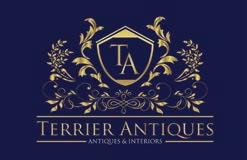
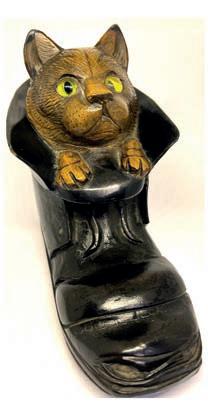





Labelled/ stamped branded furniture from Georgian to Victorian, eg Thomas Butler, Morgan & Sanders, J Alderman, Ross of Dublin (pictured), Gregory Kane, Wilkinson of Ludgate Hill, Robert James of Bristol, James Winter, W Priest, Samuel Pratt and many others. Tables all types, chairs, bookcases, , Davenport. mirrors etc. Campaign shower.
Georgian chamber horse exercise chair (pictured)
Unusual Georgian to William IV architectural features eg doors, door frames, over door pediments. 18th century staircase spindles and handrail needed. Anything Georgian or Regency with lots of character considered.
Rectangular Georgian fanlight.
Four identical reclaimed Georgian wooden sash windows with boxes, approx 60 high x 37 wide.
Marble fire surrounds from 1750 to 1850ish. White or coloured. Bullseyes, William IV styles etc. Brass Regency reeded fire insert and Victorian griffin grate (pictured)
Human


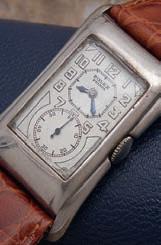

For East
~ WANTED ~ vintagejewellery@yahoo.co.uk or tel 07958 333442 ANTIQUE COLLECTING 65 ADVERTISE TODAY PLEASE CALL CHARLOTTE KETTELL ON 01394 389969 or email: Charlotte.Kettell@accartbooks.com Fair dates cancelled Bookings www.antique-clock.co.uk 01422 843189 o ce@terrierantiques.co.uk www.terrierantiques.co.uk QUALITY ANTIQUES & OBJETS D’ART 26 Market St, Hebden Bridge, West Yorkshire, HX7 6AA •WANTED• VINTAGE WRISTWATCHES vintagejewellery@yahoo.co.uk or tel 07958 333442 Omega Seamasters and pre-1980s Omegas in general. IWC and Jaeger LeCoultres, all styles. Looking for Reversos. American market filled and 14k pieces possibly, at the right price. Breitling Top Times, Datoras and 806 Navitimers. Pre-1960s Rolex models, with a focus in pre-war tanks, tonneaus etc. Gold or silver/steel. Also World War I Rolex 13 lignes etc. Princes. Longines, Tudors and Zeniths, pre-1970. Even basic steel models in nice condition. All the quirky oddities like Harwoods, Autorists, Wig Wag, Rolls etc, and World War I hunter and semi-hunter wristwatches. Early, pre-war ladies’ watches also wanted by Rolex, Jaeger LeCoultre etc. Prefer 1920s/30s deco styles, but early doughnuts also considered. Yorkshire based, but often in London and can easily collect nationwide.
skull, stuffed crocodile/ alligator. Grand tour souvenirs.
Yorkshire town house renovation.

Marc My Words
After taking part in a three-day, 2,242-lot sale, Antiques Roadshow expert Marc Allum is pleased to report the live auction is very much alive
I’ve recently coined a new saying: the ‘Wither’s e ect’. You might remember I recently wrote about working on one of the biggest single-owner collections I’d encountered in recent decades (owned by George Withers) and the thrill of discovery as we worked our way through tens of thousands of old school antiques. Well, it seems my faith in the attraction of ‘proper’ antiques has been well and truly restored.
e resulting auction, at Dore and Rees in Frome, Somerset, was a ‘white glove’ sale, which in saleroom jargon means that all of the 2,242 lots sold. No mean achievement, although it was a ‘without reserve’ sale.
Armchair collectors
What soon became apparent as the sale went online, was that the late great George Withers was going to generate his own momentum and, as the condition reports started to roll in, the curse of the online armchair shopper started to take e ect.
We were swamped with thousands of condition reports. Many were extremely demanding and the man hours required were cheerfully subsumed by the team, all of this on top of conducting a physical view, too. It took three days to sell the lots with a non-stop rotation of myself, Lisa Lloyd and Lee Young working 13-hour days on the rostrum.
Also, spare a thought for the clerks and backroom sta who were at some points running four online platforms, telephones and continual relentless enquiries. e sale’s top seller, hammering at £14,000 was a set of Elizabethan sycamore ‘trenchers’. Dating from the late 16th or early
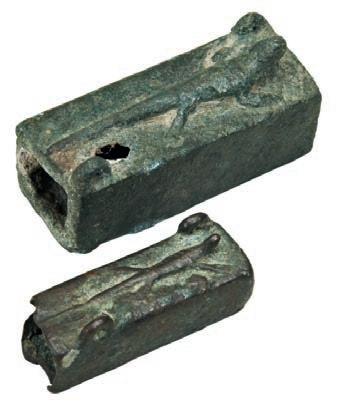
Above Ancient Egyptian mummi ed lizards and their co ns may have had a ritualistic use, image courtesy of Dore and Rees
Below left e Elizabethan roundels were the top lot of the three-day sale, when they hammered for £14,000, image courtesy of Dore and Rees
17th century; they gave us a wonderful insight into 500-year-old dining traditions. e roundels would have been used as a plate and then turned over to reveal a verse which diners might read or sing – a bit like today’s cracker joke. Another lot which attracted a lot of presale publicity was made up of two Ancient Egyptian lizard co ns, dating to around 500BC, which were expected to sell for £150-£200 but made £1,100 on the day. Both hinted at the breadth of George’s eclectic collecting range and his wonderful world treasures.
Old school dealers
What I did particularly enjoy was the nostalgic sense of occasion. In a modern saleroom environment where views can be very quiet, this was completely di erent. Hundreds of people came to look at the lots. It seemed everybody wanted a bit of George’s collecting and dealing legacy and I was constantly having conversations with people I hadn’t seen for many years, even decades.
Old school dealers, the real eccentrics of the antiques world and collectors from all walks of life, plus all the di erent strata of the art and antiques world came through the doors and generated a premium atmosphere for high prices and objects which hadn’t seen the light of day for decades.
Many had tales to tell about George. But for us, one of the main pleasures, despite the enormous amount of work, has been putting the collection back into the marketplace and the hands of collectors.
Temporary blip
Being a collector myself I’ve never been of the opinion that the items are mine. ey’re mine for a while and I hope that George would have had the same opinion, too.
Part two of the sale, although smaller, will I am sure attract much attention with plenty of interesting items still to go under the hammer. is is to be followed by some superlative Asian Art items in May.
Let’s see if the ‘Wither’s e ect’ was just a temporary blip feeding some real connoisseurship.
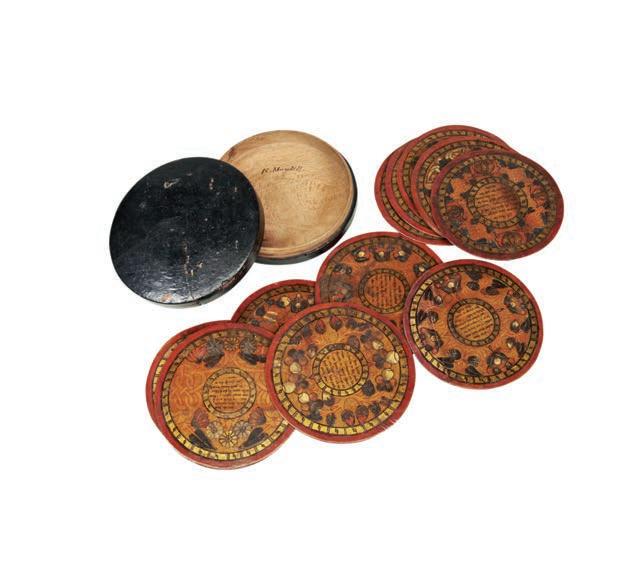
Because, despite the often gloomy appraisal of which antiques are popular, or not, the sale demonstrated beyond doubt that George had a discerning eye for what collectors really want.
Marc Allum is an author, lecturer and specialist on the BBC’s Antiques Roadshow. For more details go to www.marcallum.co.uk
‘Let’s see if the ‘Wither’s effect’ was just a temporary blip, feeding some real connoisseurship. Because, despite the often gloomy appraisal of which antiques are popular, or not, the sale demonstrated beyond doubt that George had a discerning eye for what collectors really want’
66 ANTIQUE COLLECTING LAST WORD Marc Allum
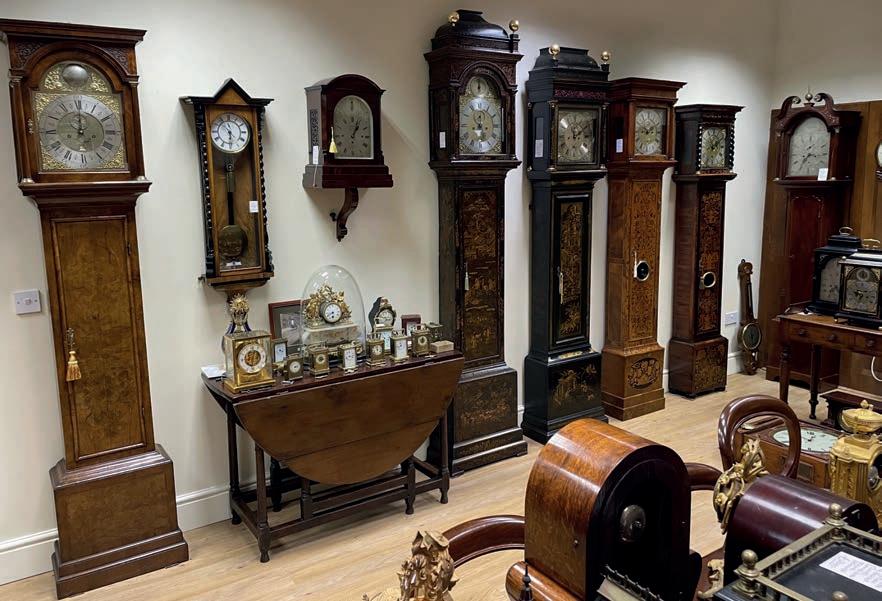
Whaley Bridge, High Peak, Derbyshire Tel: 07767 617507 or 01663 733209 www.antique-clock.co.uk The Chimes Antique Clock Centre For a superb selection of over 100 Genuine Antique longcase, wall, and bracket clocks Open 7 days by appointment
PACK & SEND’s specialist
Antiques and Fine Art services include:
Custom packing:
PACK & SEND custom makes cartons and wood crates of any size and our ‘foam in place’ cushioning provides maximum protection to fragile items such as glass, sculptures and ceramics.
International and UK delivery services:
PACK & SEND offers the UK’s widest range of freight solutions… We send anything, anywhere! –local, domestic and international.
Cover against loss or damage:
PACK & SEND’s Gold Service provides cover against loss or damage up to any value.
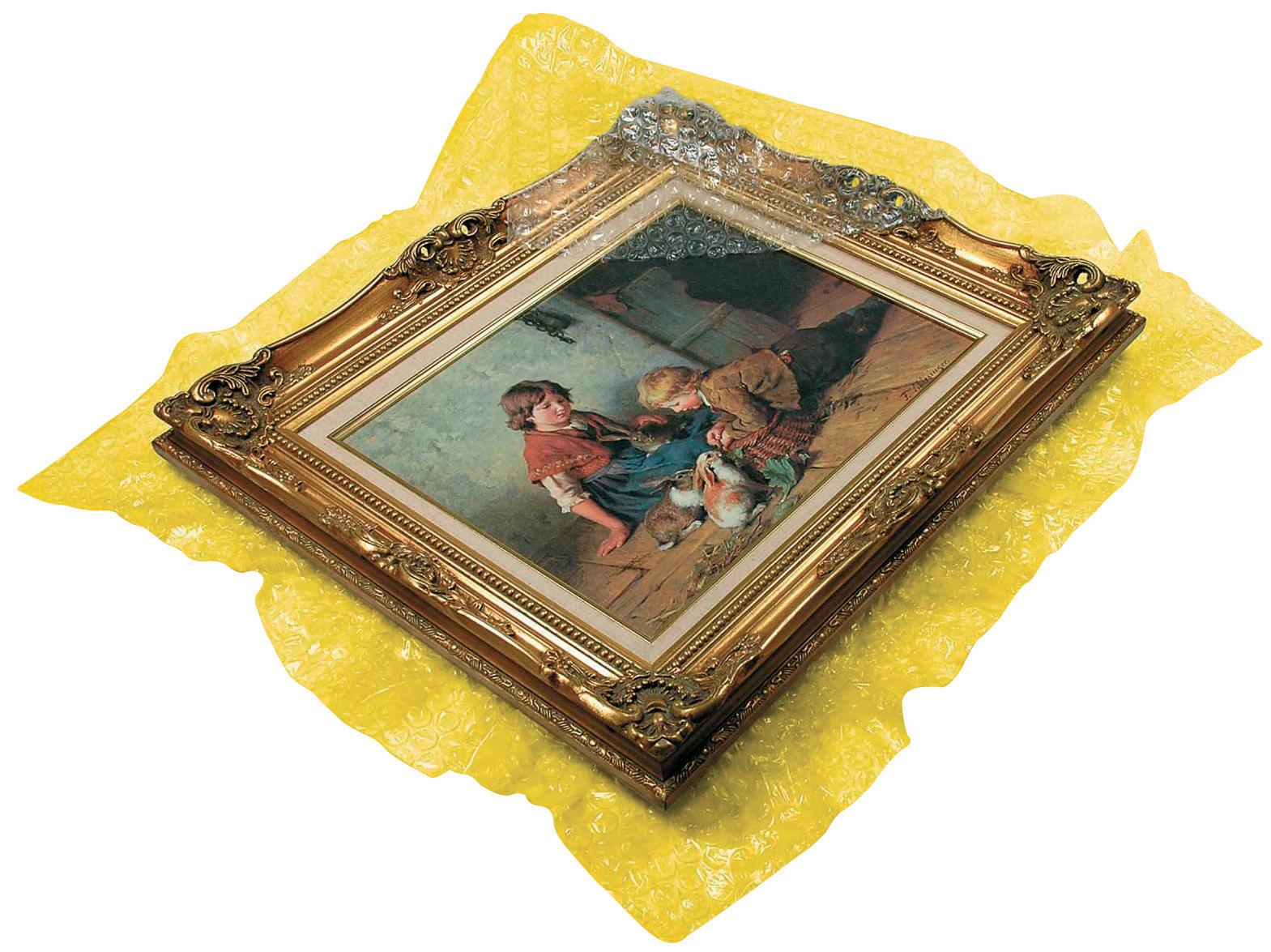
“My
-Barbara Myers Sculpture Ltd
57 ANTIQUE COLLECTING
and
Contact our specialists a e ilsom or onnie urph email: al a a e a e Unit 1 Radclyffe Park, Phoebe Street, Salford, Manchester M5 3PH
Specialist Shippers of Antiques
Fine Art
client was delighted and said it was the best packing he had ever seen”





















































































































































































































































































































































































 Right e fair brings together antique and vintage textile dealers from around the globe
Right e fair brings together antique and vintage textile dealers from around the globe

















